Month: April 2020 (Page 1 of 2)
all within a walk from my apartment
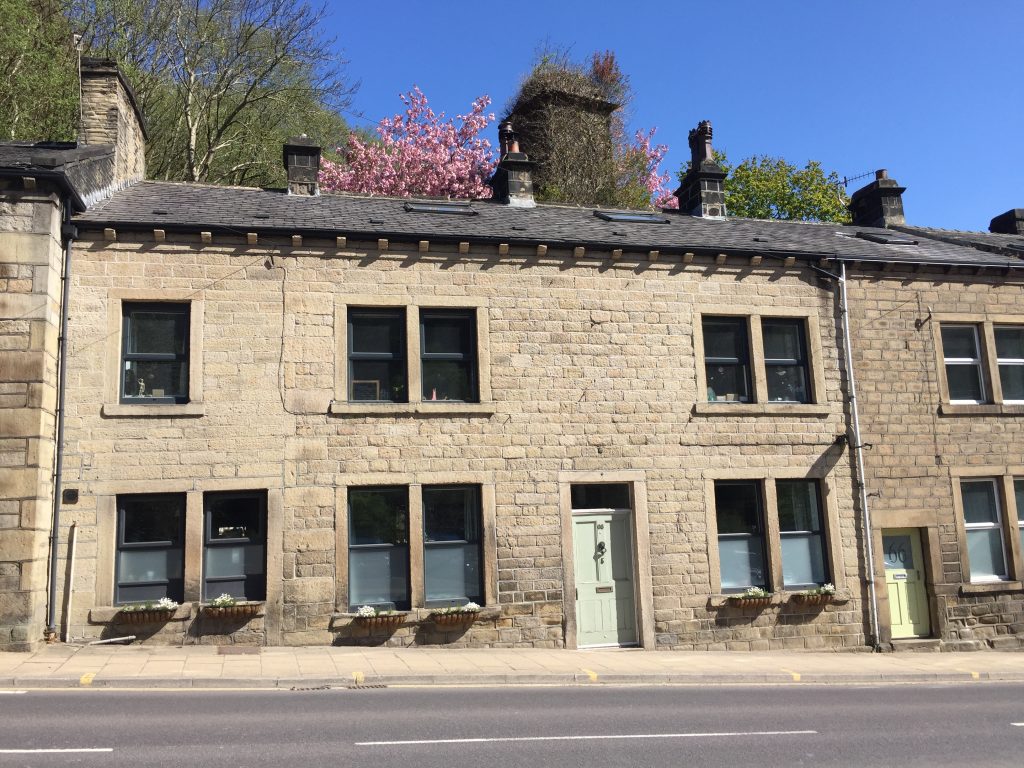
The former Bull Inn, Hebden Bridge, where Joshua hanged himself in his slaughterhouse at the rear
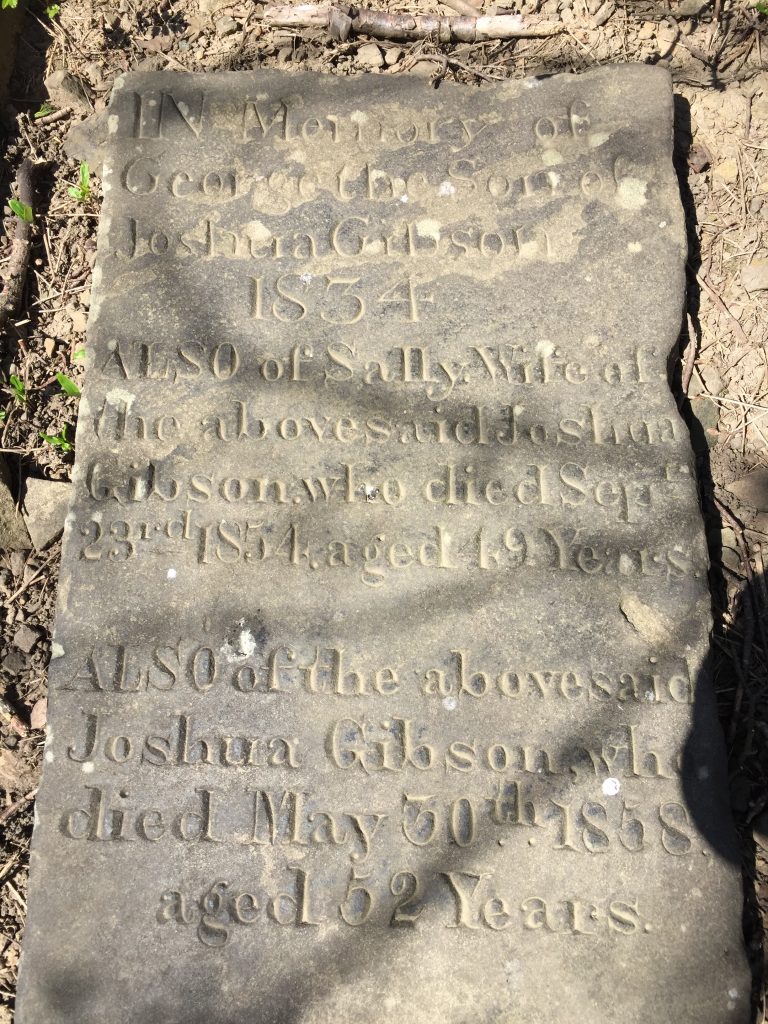
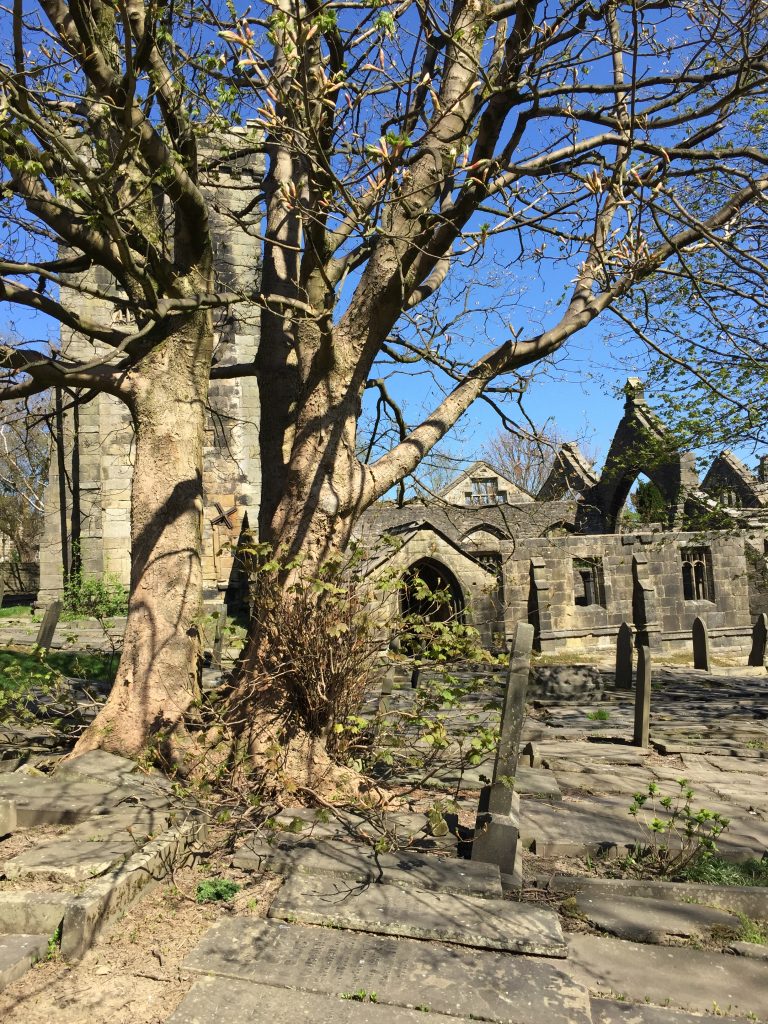
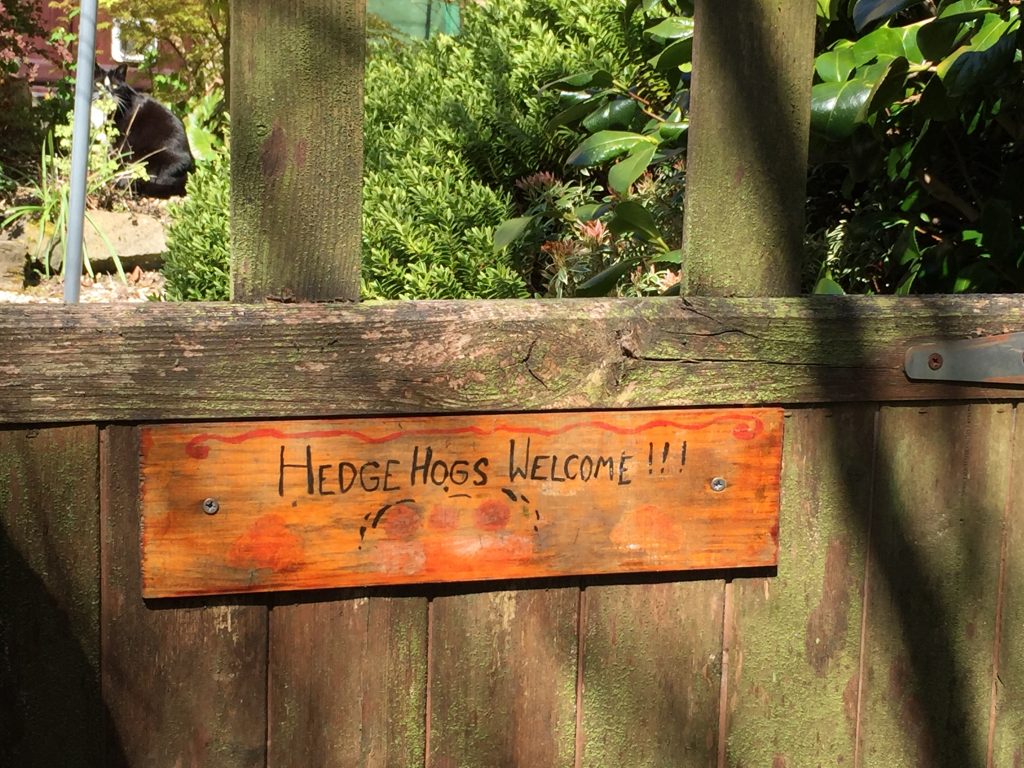
A reference to my mum 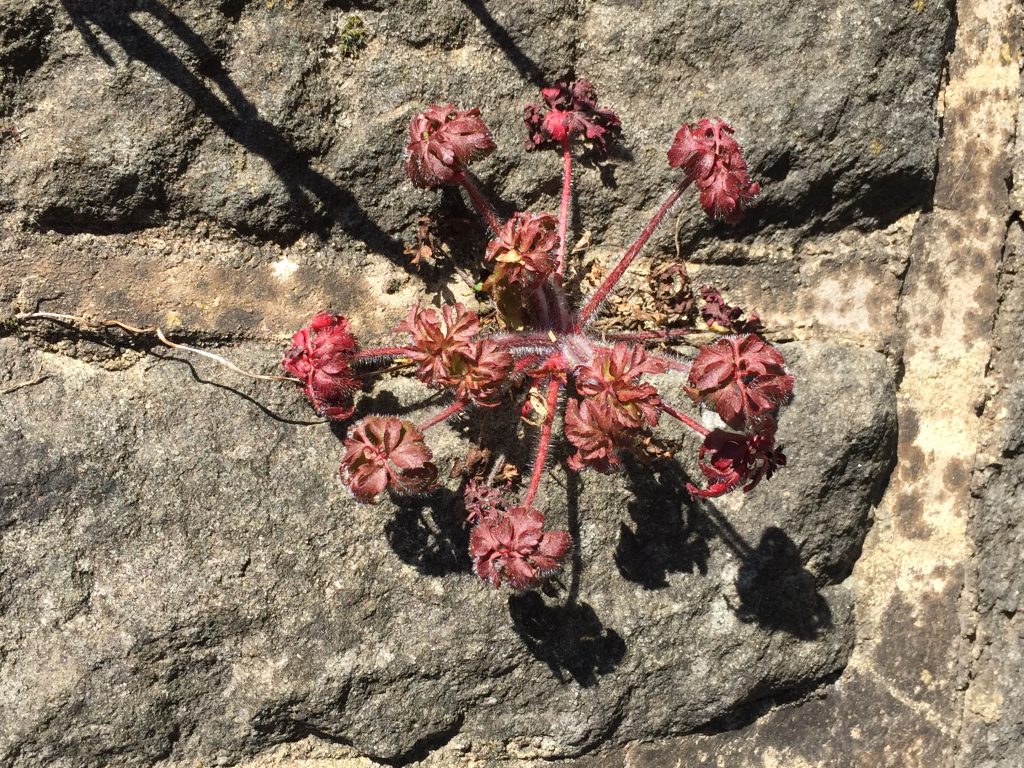
A reference to corona virus
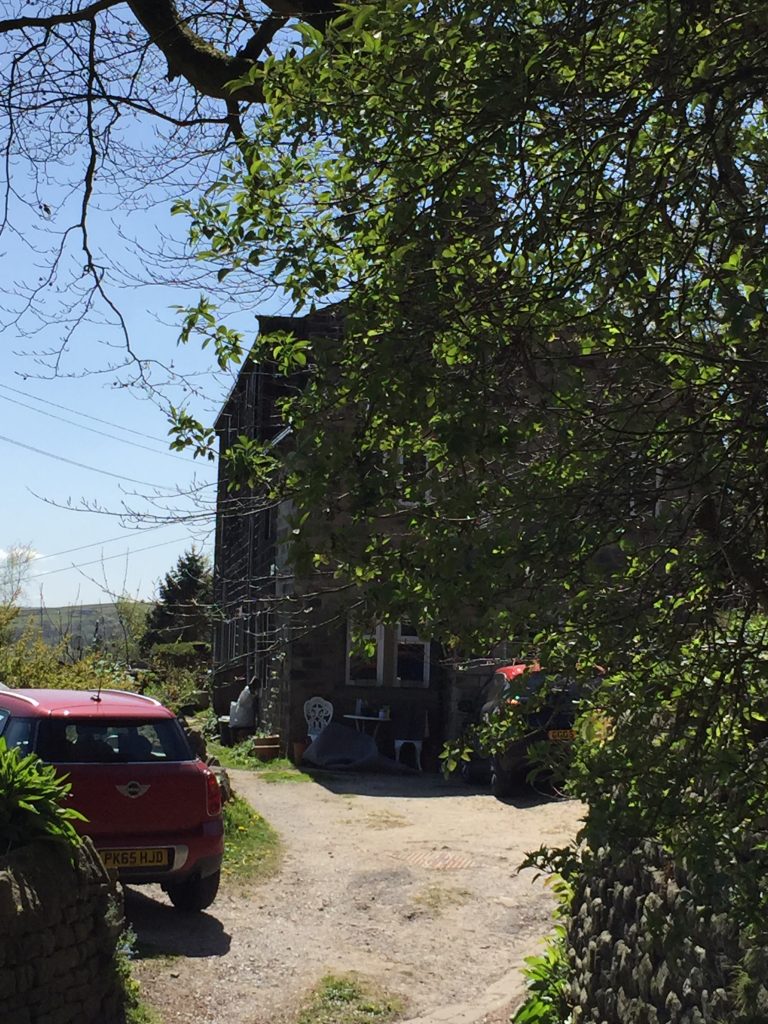
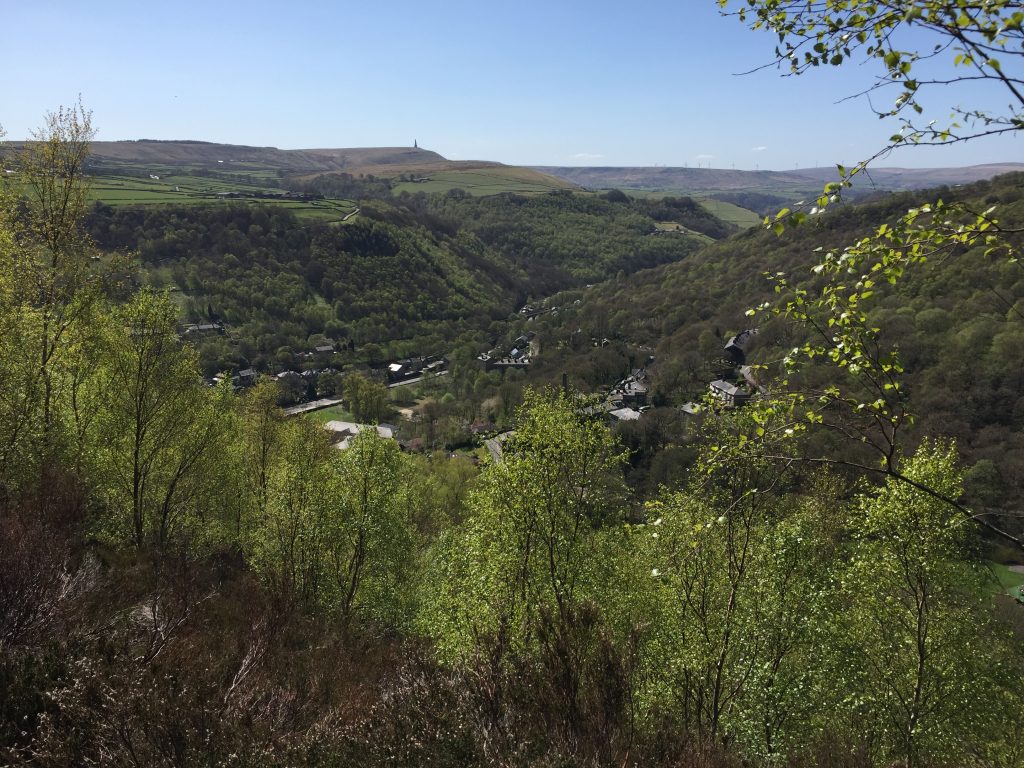

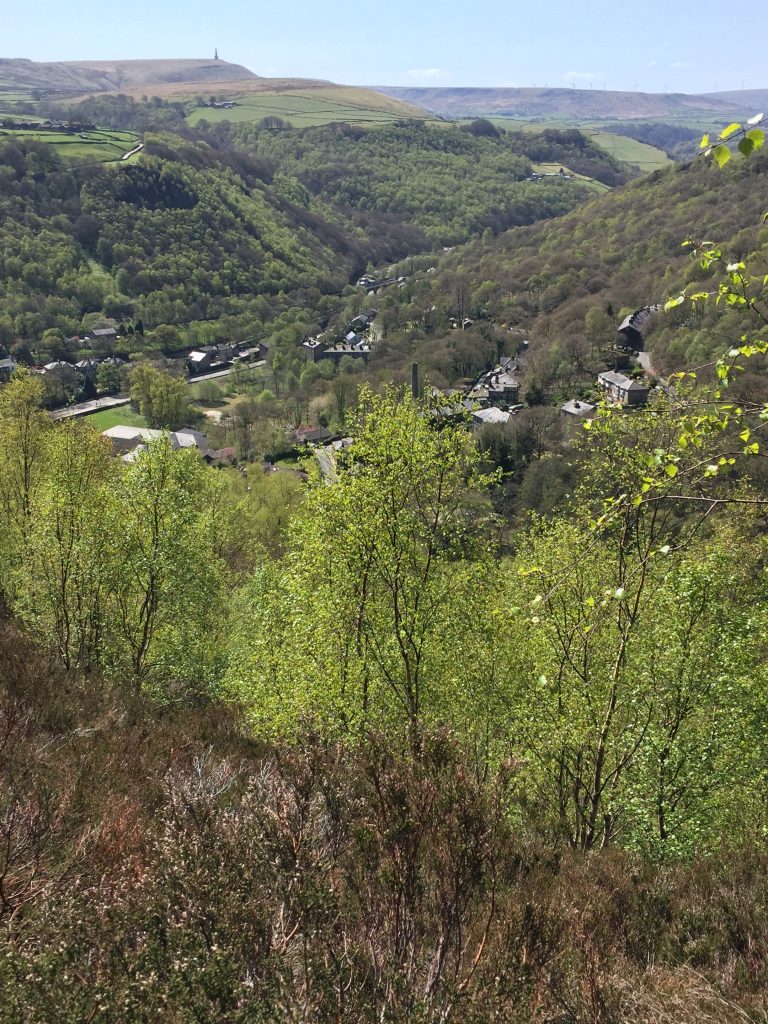
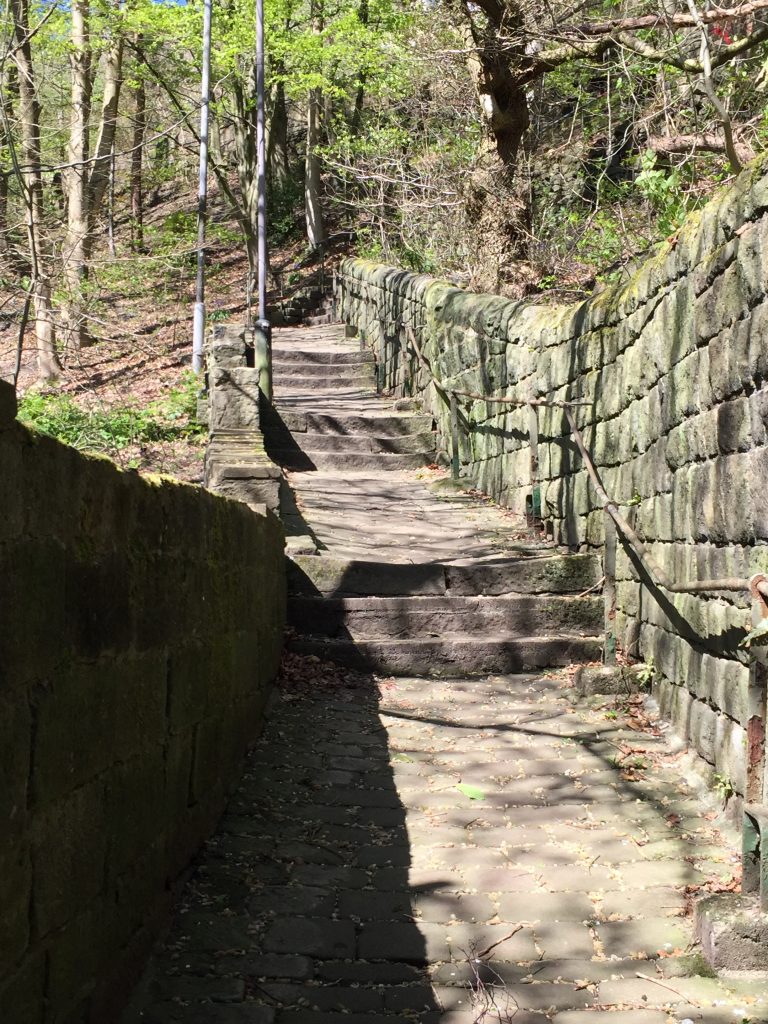
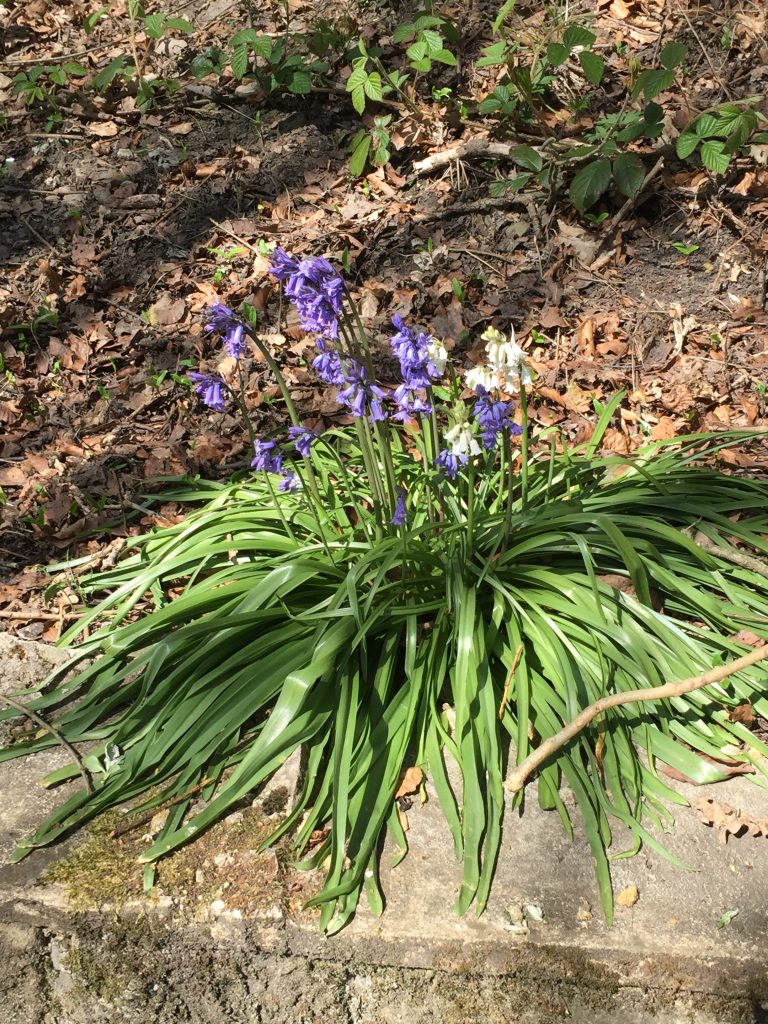
Update: May 28
Today I saw a message on my blog dated May 2nd. It was from Kate Lycett saying that it was nice to chat this morning and let’s connect again. It took me a few minutes to figure this out. Kate Lycett is a wonderful artist who lives in Hebden Bridge. A visit to her gallery in Heart Gallery is always high on my list to take my visitors to, and last summer I’d been to her open studio and bought a note book, the cover of which was a lovely painting of Staithes. I’d asked Kate to sign the notebook and when Anna came to visit in August and we spent a few days in Staithes I gave her the notebook and we found the exact spot from where Kate had done her painting. so why had she posted on my blog a couple of weeks ago? And then it dawned on me. At the beginning of May I’d been walking past the former Bull inn where Joshua had been the landlord when I saw that the door was being refurbished. A lady was working on it and so I paused to ask if I was correct in thinking that this had been The Bull. It had, and under normal circumstances she would have invited me in when I told her that one of my ancestor had lived there. I invited her to look at the posting on my blog about Joshua. And so the response I noticed today was from Kate, who I hadn’t recognised in my chat to her at her door. This means that I’ve actually been into The Bull, since this was where her open studio was, up the steep steps, behind the building and so I hadn’t realised it was the back of the Bull. Interestingly Kate had moved there when she was pregnant with twins, who I had met at the open studio. I’d also attended a fascinating lecture she had presented to the local history society about Lost Houses of the South Pennines. It’s coincidences like this that make me feel at home in this community.
When I set off for a walk I had no intention of climbing up to Stoodley Pike but I was enjoying myself so much I just kept going: 7 miles.
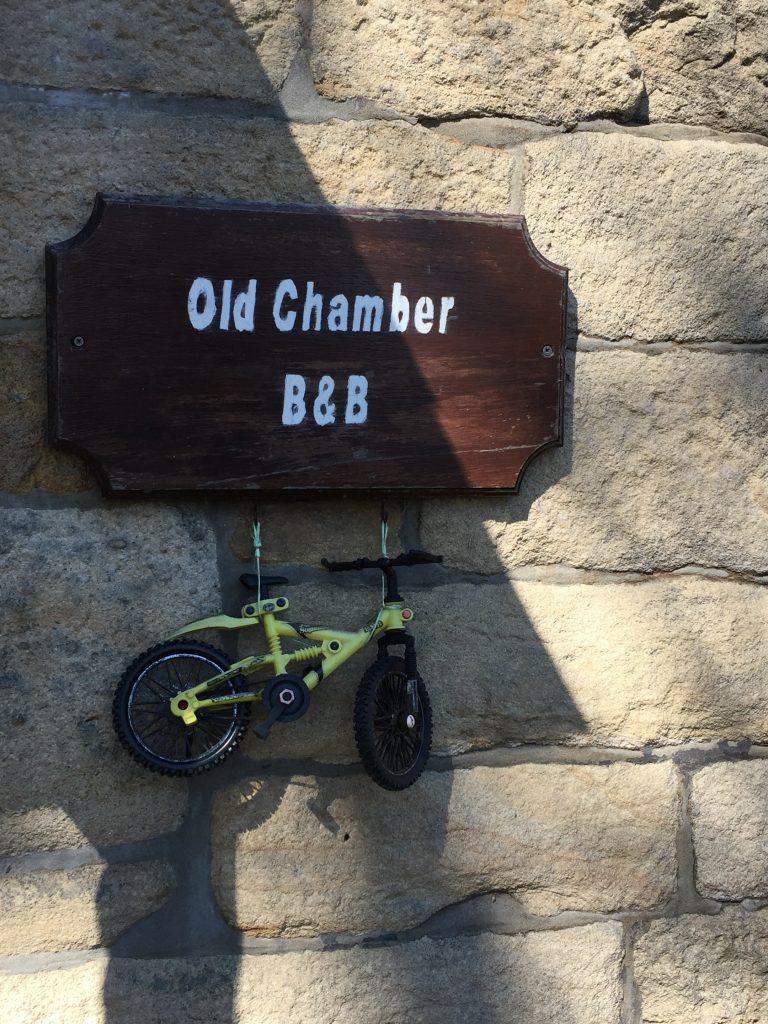
Ancestors lived here: John Lord and his family in 1841 and 1851 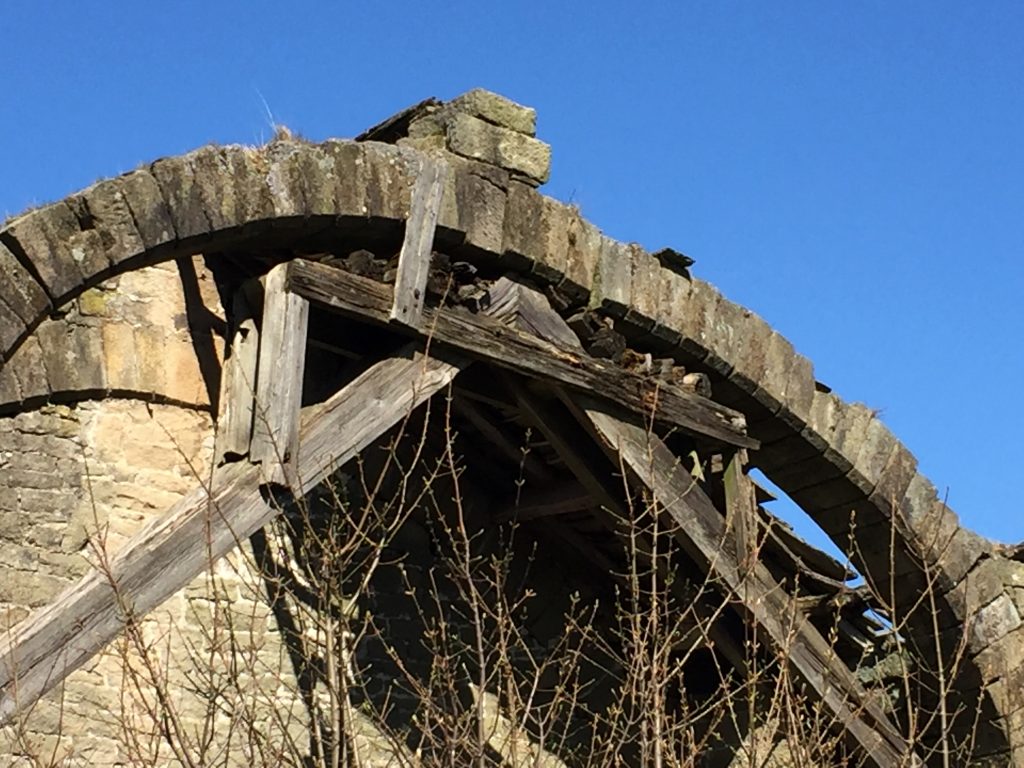
Old Chamber barn 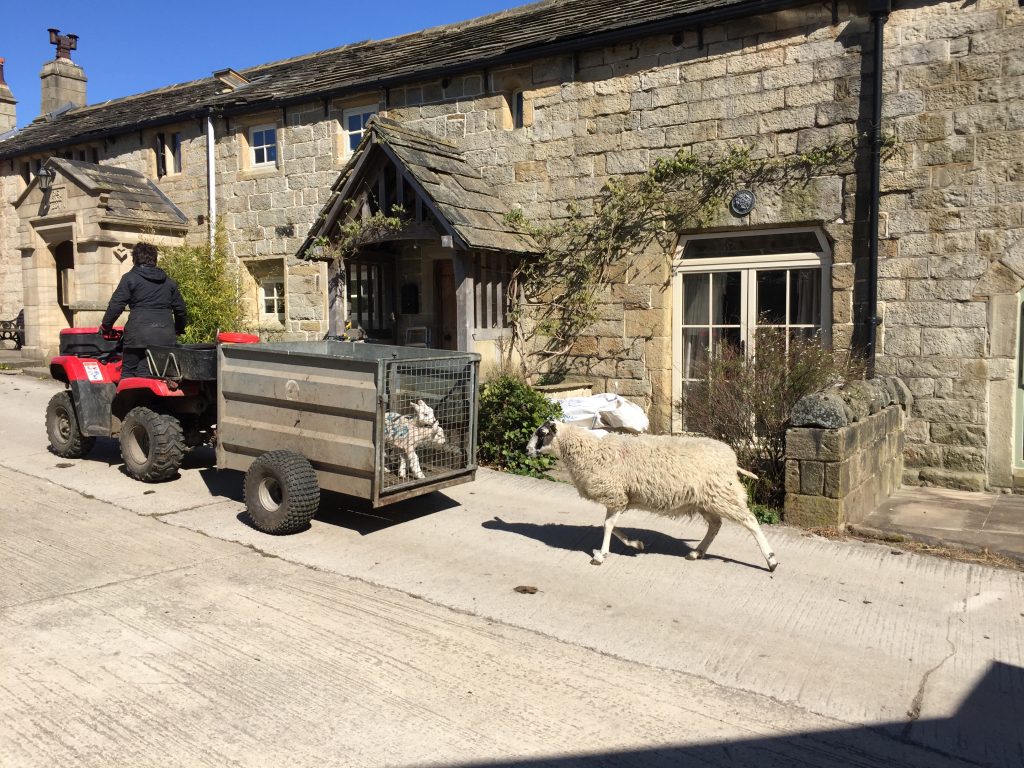
Off to a new field 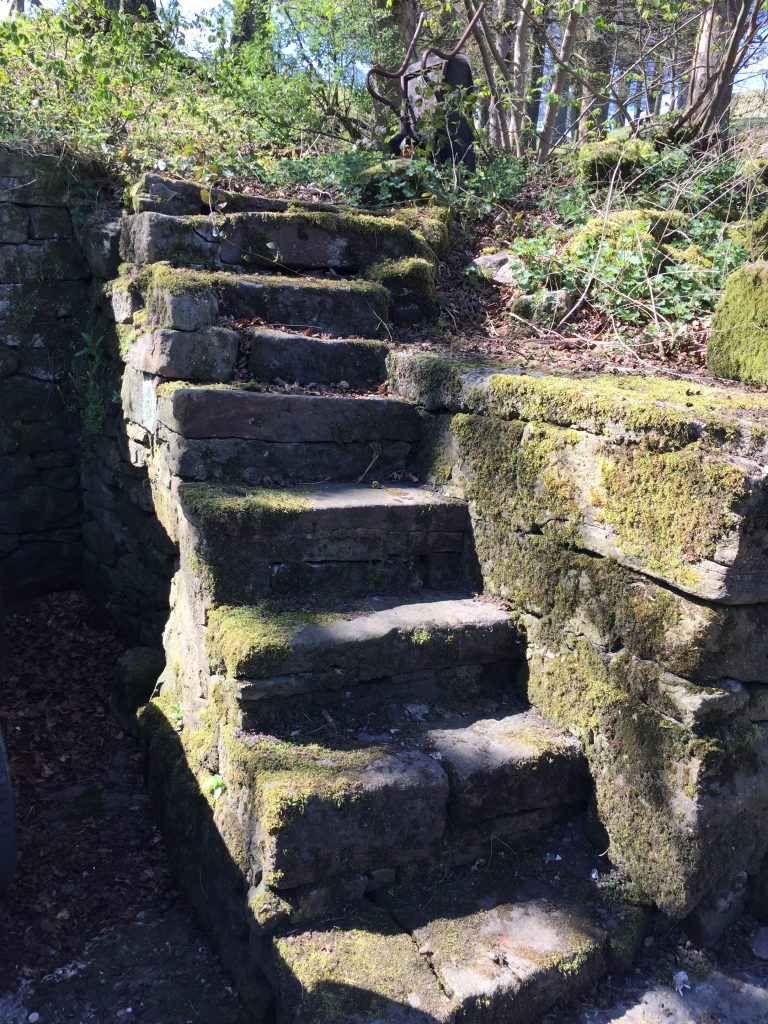
Did John climb these steps? 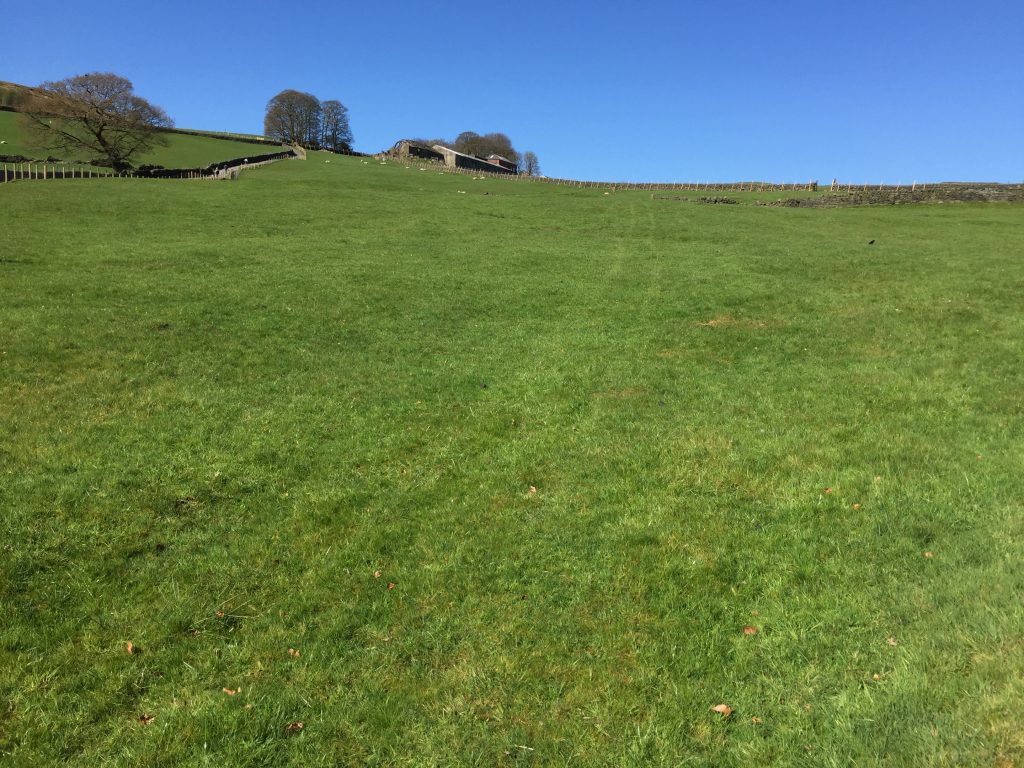
Old Chamber is very isolated. 6 children were born to him here. 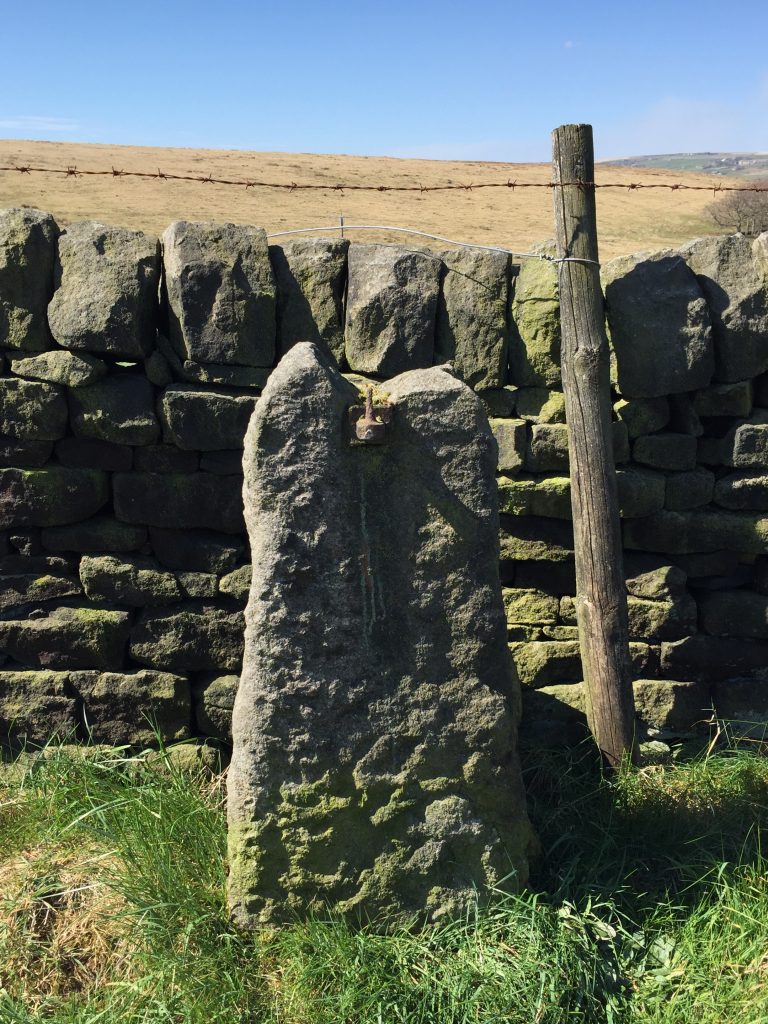
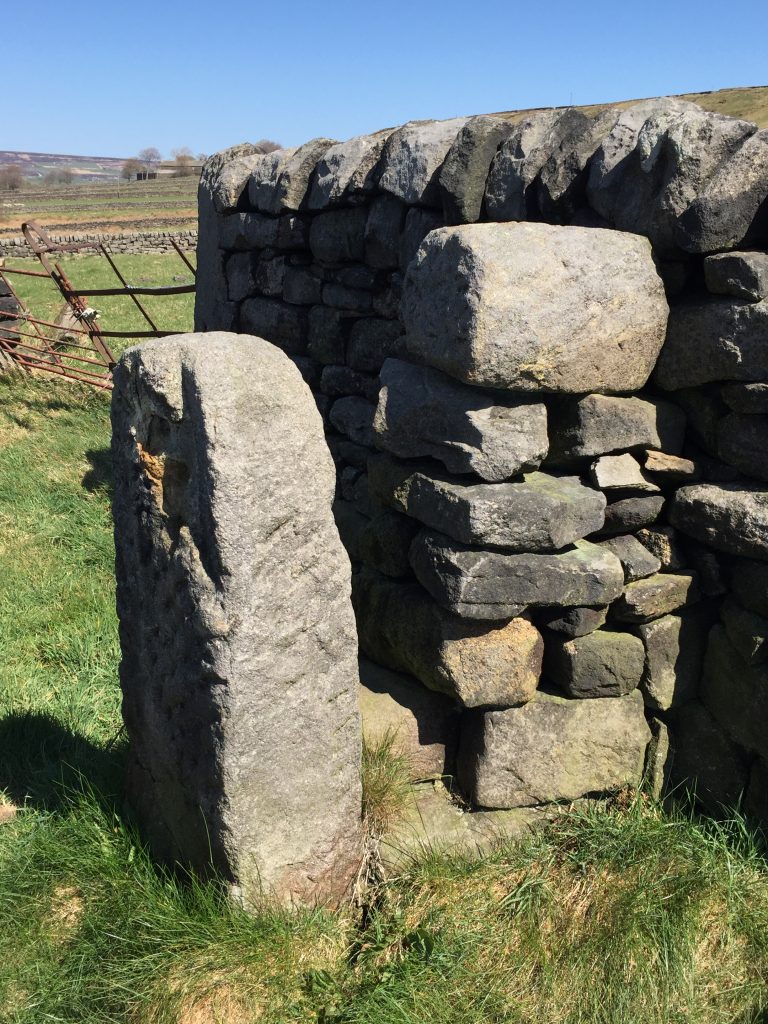
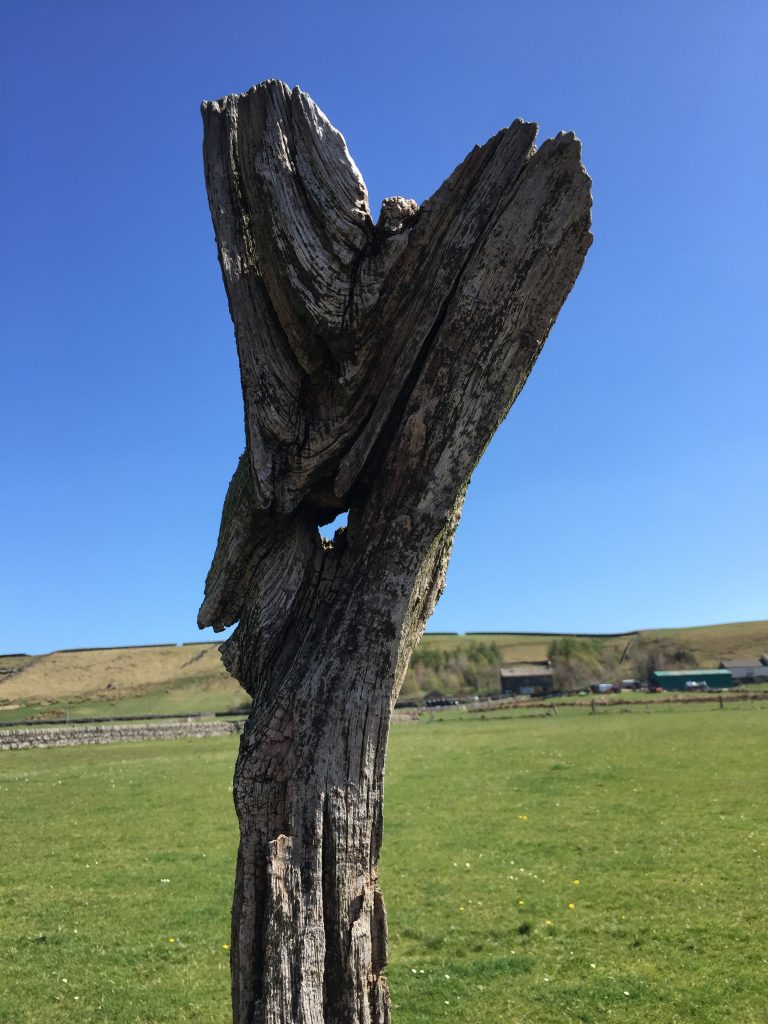
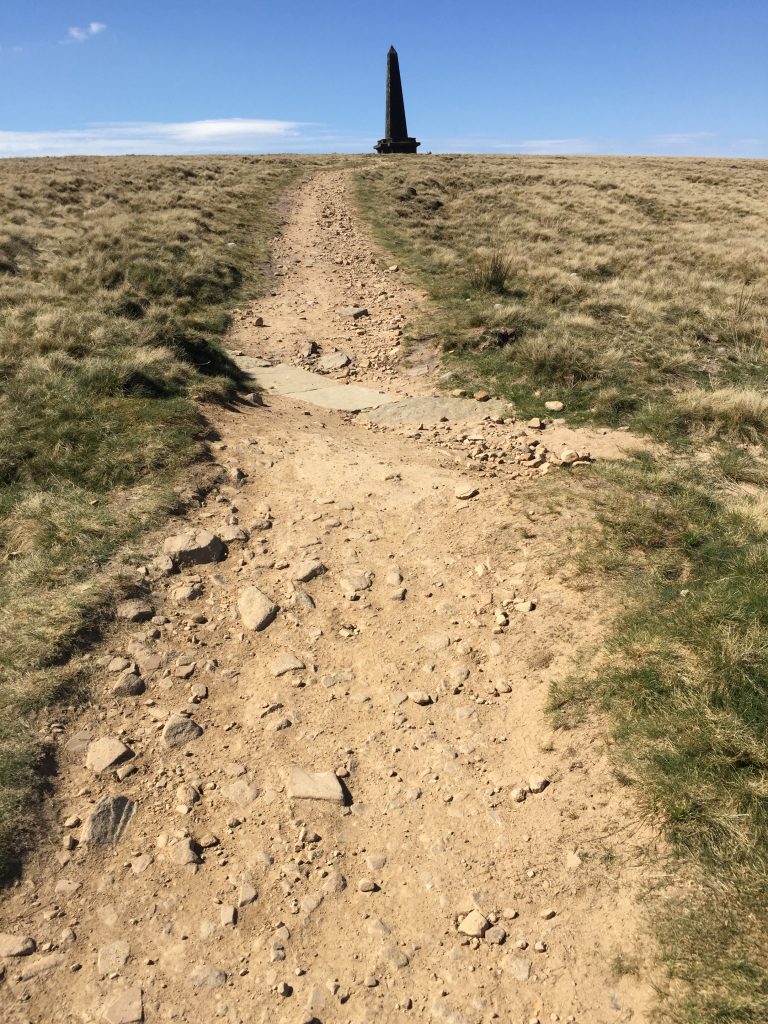

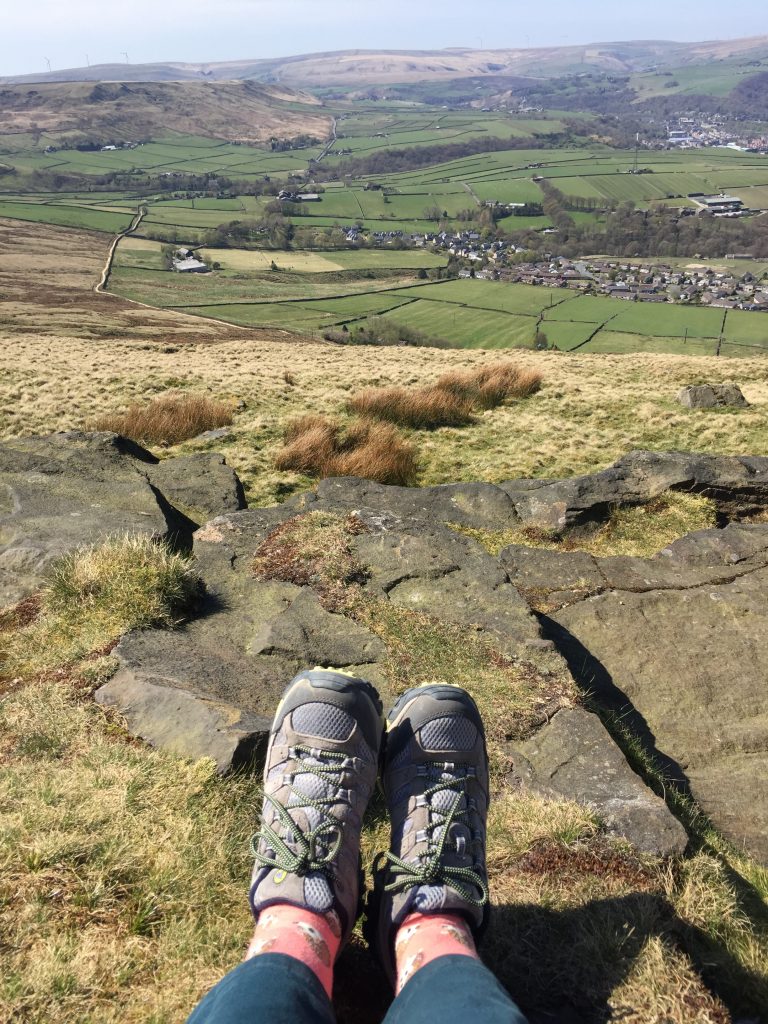
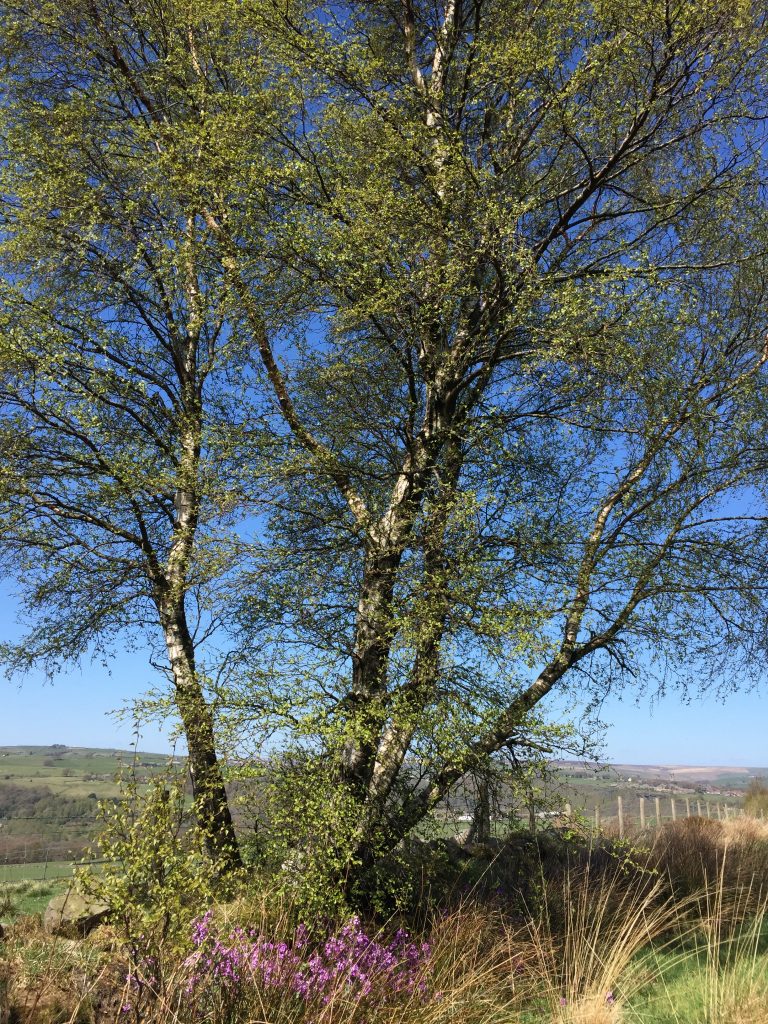
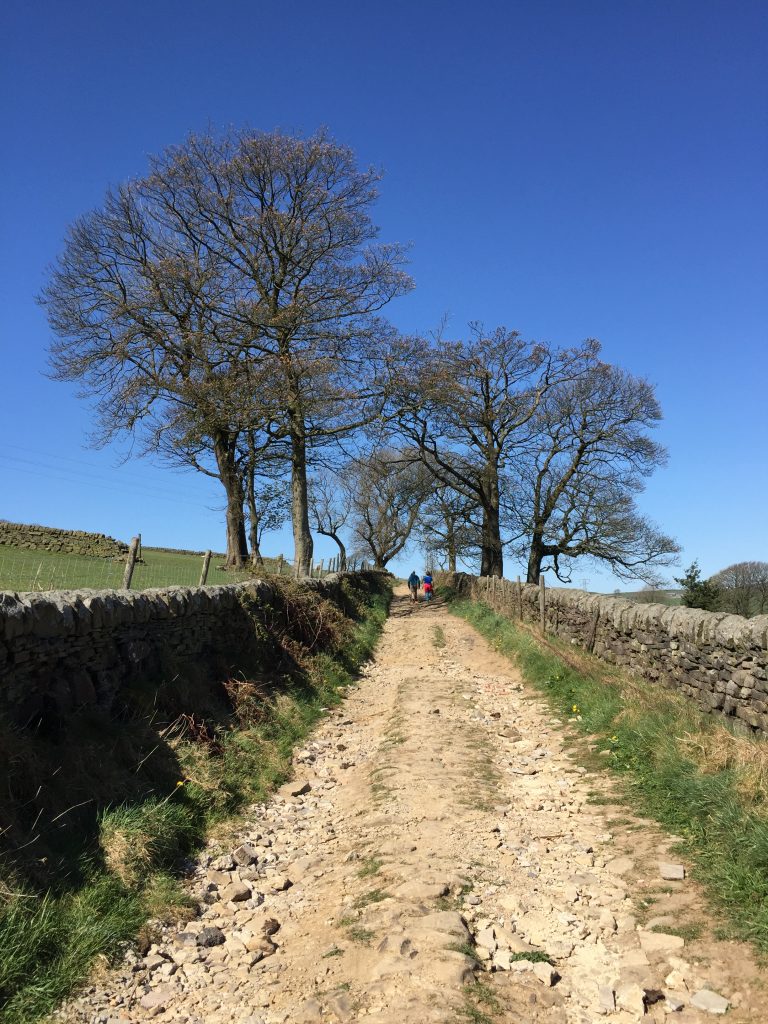
I find it remarkable that within less than a week of my hike to Old Chamber, that place with the weird name, that I was so excited to find out more about when I got home, I discovered that one of my ancestors – yes, a distant one – lived there in 1851. John Lord was born 1819 in the oddly named village of Coniston Cold near Skipton. In 1841 he was a labourer living at Old Chamber. Later that year he married Catherine Stansfield at Halifax Minster and they continued to live at Old Chamber for at least 10 years where Catherine gave birth to five children. I just can’t imagine giving birth in such an isolated place. By now John was a butcher and farmer. By 1861 they had had 2 more children and moved into the centre of Hebden Bridge – Lee’s yard, which is now where the open air market is today where I purchased cheese and fruit and vegetables wearing my mask and practicing social distancing. in 1881 he was still a butcher, now living in St George’s Square – the social centre of town with the fustian knife sculpture.
I did some delving into the history of Old Chamber and found someone from Hebden Bridge history society, Nigel Smith, actually did a dissertation on Erringden Deer Park. it’s in the archives and that means I can’t access it. But when the deer park was ‘dispaled’ – the fencing enclosing it removed, it was split into 5 farms. Old Chamber was probably the steward’s home when it was a deer park:
Watson The History and Antiquities of the Parish of Halifax, in Yorkshire. 1775 p184 Old Chamber the habitation of Pilkington, Seneschal and Rector of Sowerbyshire most likely as it was a chambered house. One set of rooms is placed over another. Ah, so that’s how it got its name. Palace Road by the railway station is a misnomer – it was pallisade road, the pallisade being the fence around the deer park.
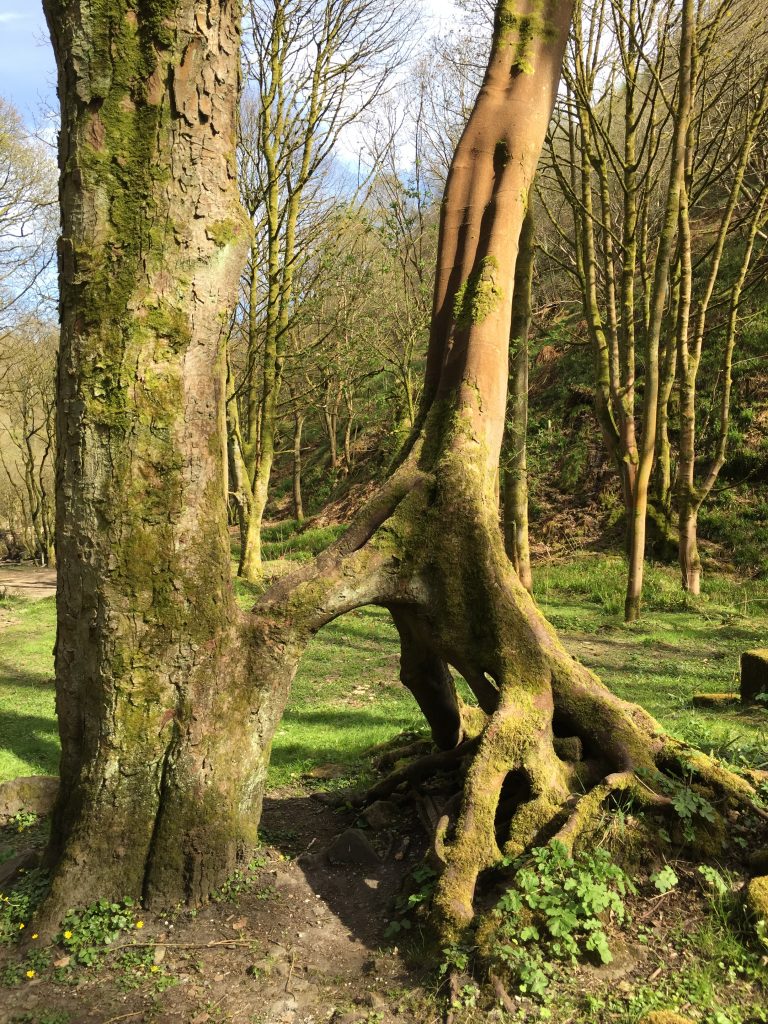
The second coincidence was my visit to the ruins of Lower Lumb mill yesterday where I sat for half an hour, doing a little sketch of mill chimney and bridge. And this morning I rediscovered, quite by chance, my noters on Jabez Hart and his family. Jabez had been born, like me, in Bolton, Lancashire. He was born in 1826 and married at the parish church in Bolton in 1844. In 1851 he was a factory operative living on Blackhorse Street, Bolton. Then sometime between 1861 and 1863, judging from the birthplace of his children he moved to the Calder Valley, and was living at Lower Lumb mill as a cotton carder with his wife and five children. The oldest child, also Jabez, was working in the ‘cotton blowin room,’and the other children were worker as cotton doffers and carders – even the 11 year old.
Lumb Mill School was founded in 1845 by the owners of the mill. In 1851 there was one school room, 20’ by 16’, with 34 girls and 17 boys, who were taught reading writing and arithmetic. The children would have worked half time, with one group at school in the morning and another in the afternoon. Half timing ended only with the Fisher Act of 1917.
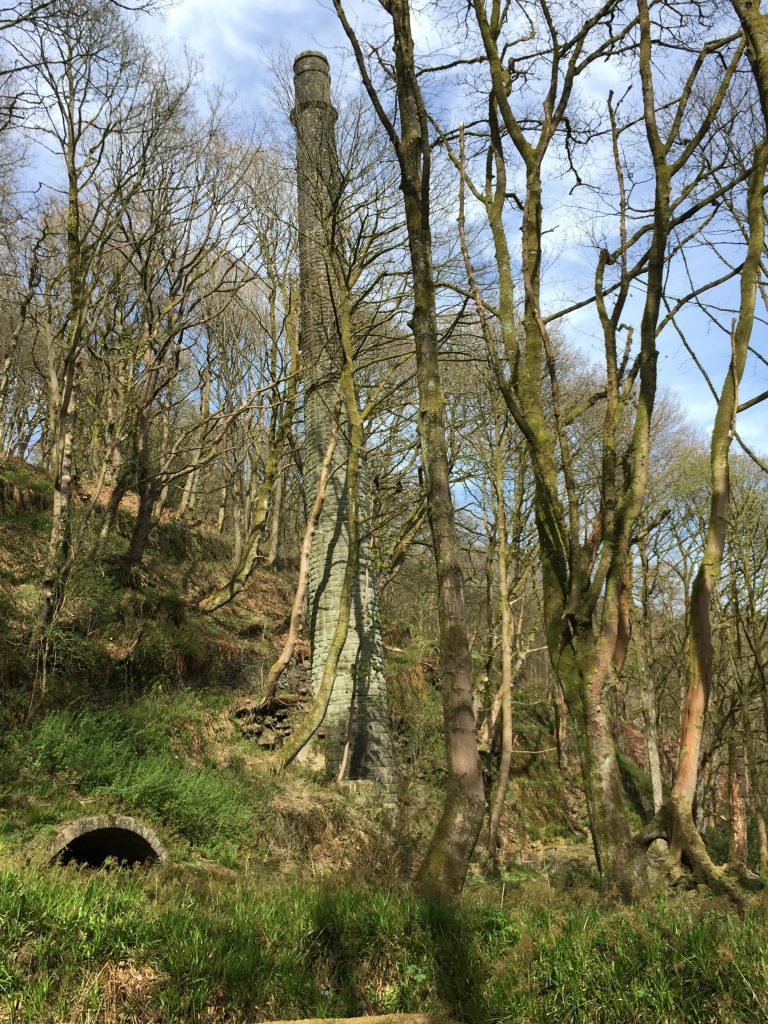
In 1851 Lower Lumb Mill was advertised to let with 4000-5000 throstle spindles – interested parties were to apply to Richard Sutcliffe at Lumb Bank. (This was the son of the Richard Sutcliffe mentioned above.)
Higher Lumb Mill closed in about 1876, but Lower Lumb Mill was sold to the Lower Lumb Cotton Spinning Company who ran the mill until about 1907.
In 1894 the outbuildings included a warehouse, cottages, blacksmiths shop and lumber rooms, also a bowling green and club house.
Phyllis Wrigley married Abraham Moss’s son Walter Edward. Walter had been born at 13 Melbourne Street in 1888. In 1914 his sister Phyllis Moss died at Brooklyn aged 12 years. By 1911, at the age of 22, Walter is head dyer of fustian, still living at Brooklyn, and he’s still at Brooklyn in 1918. On March 19, 1919 he married Phyllis Wrigley, daughter of John Edward Wrigley of Rose Grove, Oak Leigh and Beech Mount.
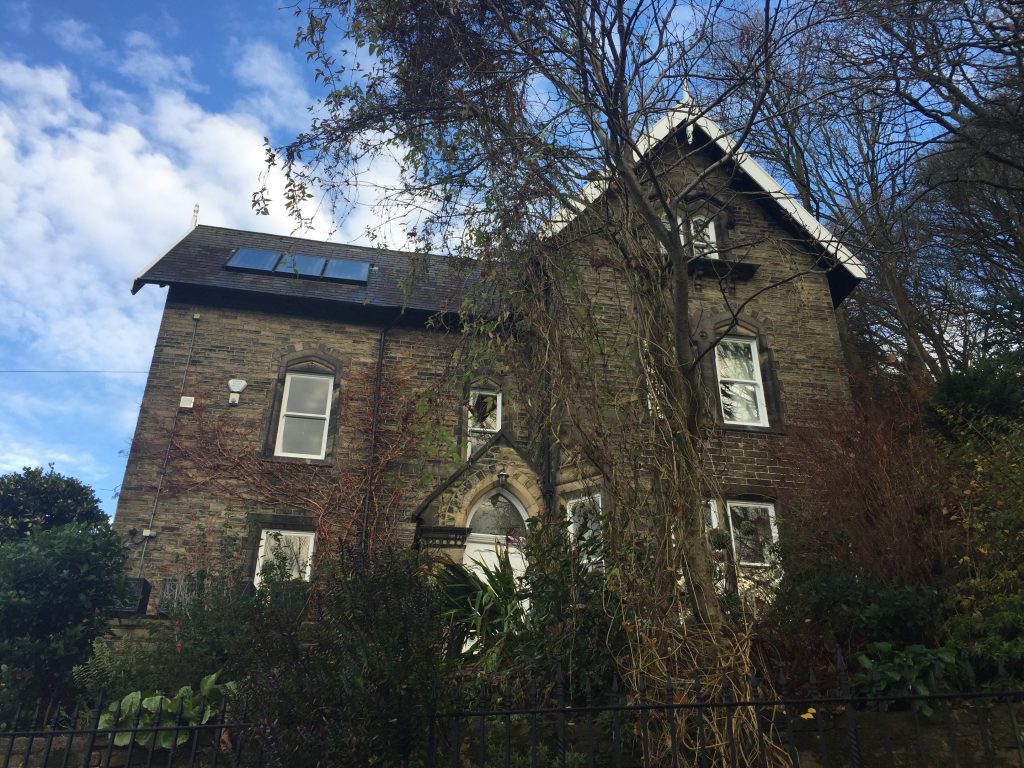
Beech Mount 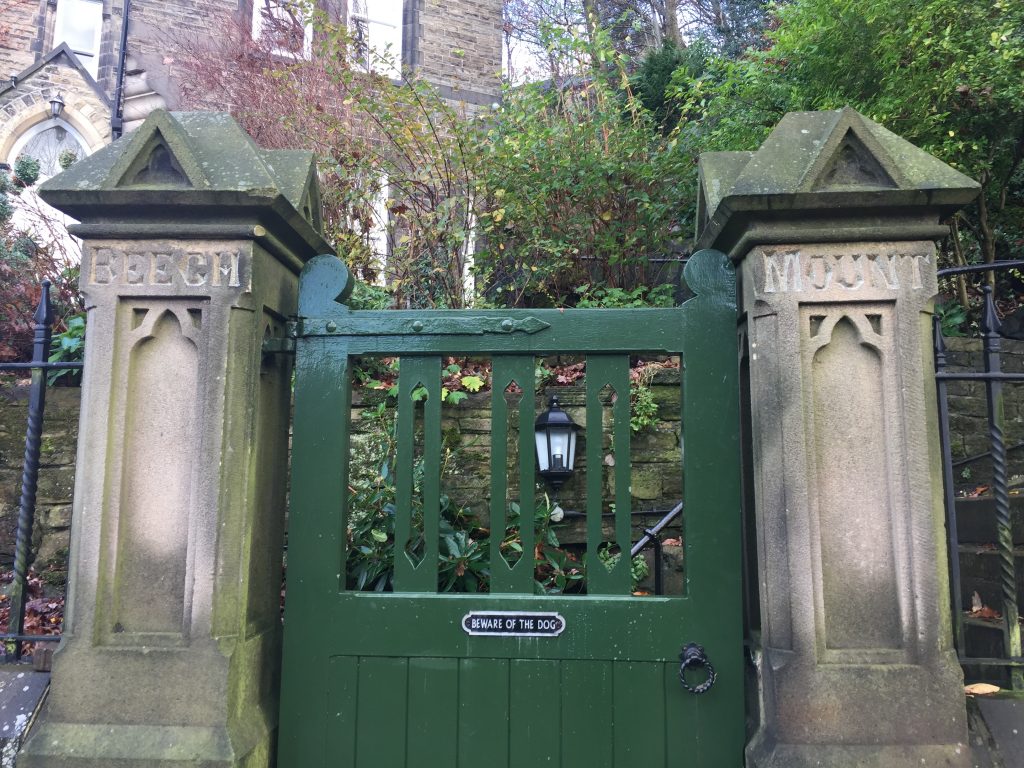
Beech Mount 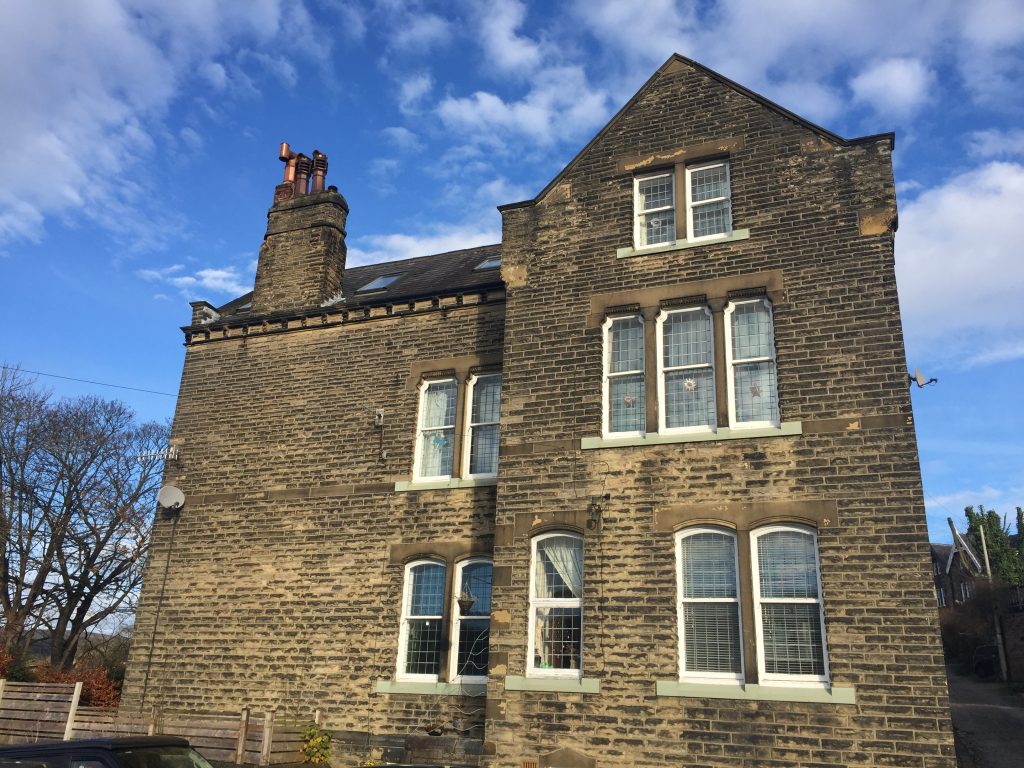
Oakleigh
John Edward died at Oak Leigh on Oct 17, 1929 and his funeral was at Heptonstall. He left 7096pounds in his will – painter and paper hanger?
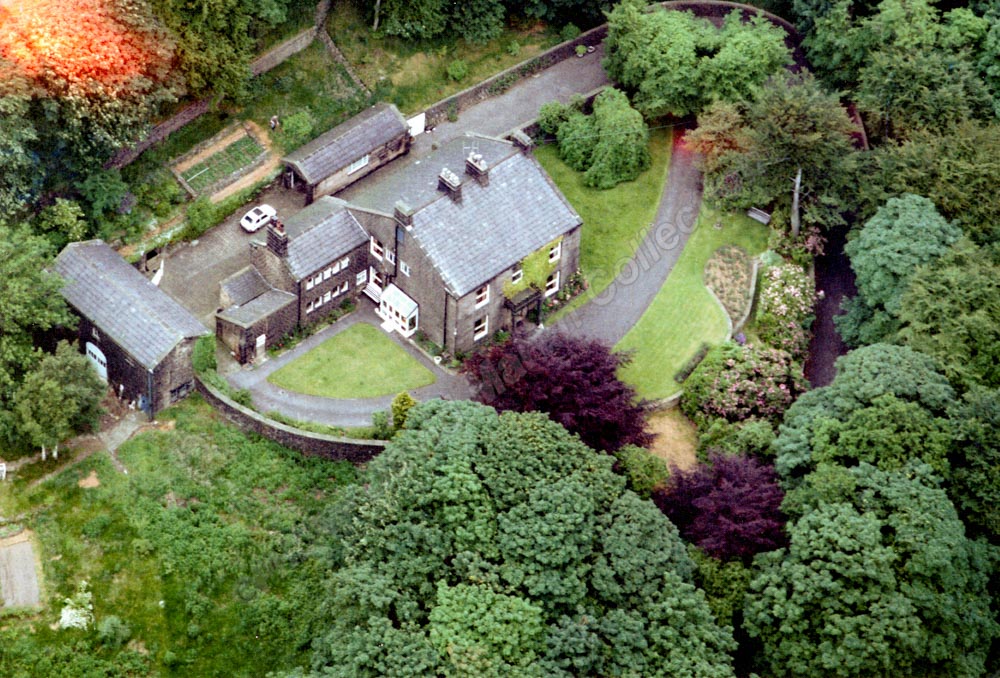
Todmorden Advertiser and Hebden Bridge Newsletter – Friday 23 August 1929
Burnley News – Wednesday 21 August 1929
2nd great-grandfather of husband of my 3rd cousin 2x removed!
Great-grandfather of Abraham Moss (see post)
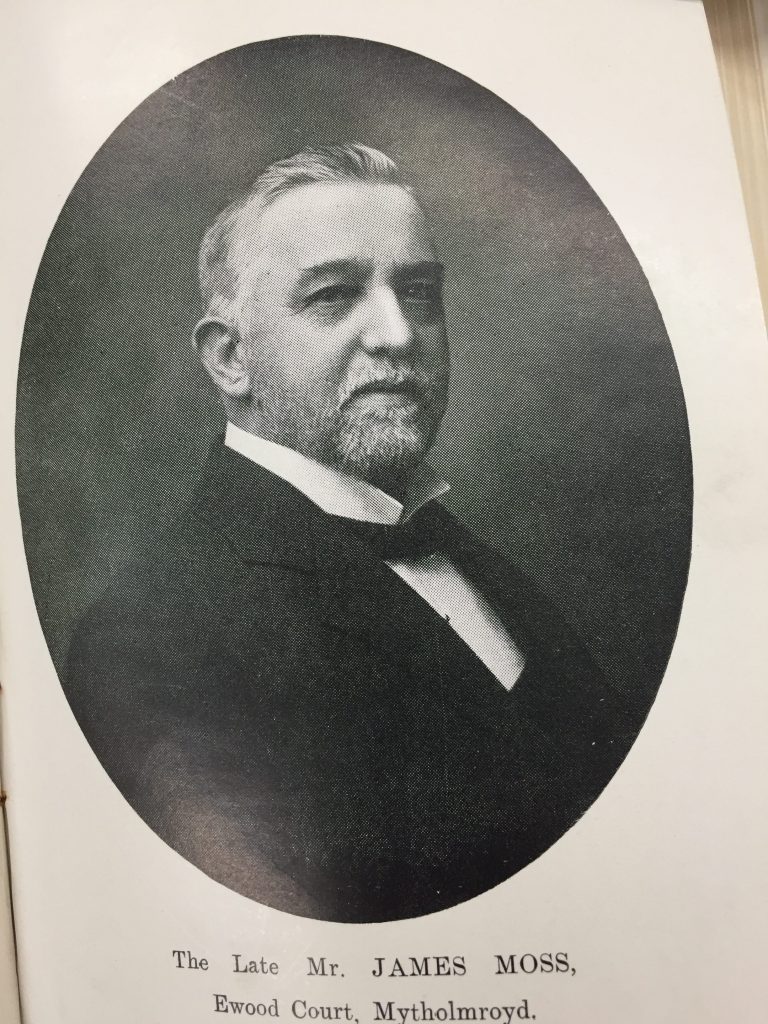
James Moss married twice. His first wife, Mary Hague, possibly came from Burnage (unsubstantiated –ancestry.com) after whom Joseph was obviously named gave birth to 11 children, and his second wife, Grace Ashworth had five children. Mary and James were married at Manchester cathedral in 1790 and it was in Manchester that Joseph was born, ( and baptized at Canon Street chapel) though by the birth of their second child a year later the family had moved to Hebden Bridge and were living on King Street. Three of their children died within their first year, and they even named a newborn daughter Esther after their previous daughter Esther had died. Looking at the timing of Mary’s death it’s likely that she died in childbirth since she died almost two years after the birth of her last child at the age of 49. It took James six years to remarry at the age of 46 but even then never more than 2 years elapsed before another child was born until he reached the age of 54 and his wife, Grace Ashworth, was 41. They married at Halifax minster.
James had been a silk weaver in Manchester at the time of their marriage. Middleton, where many of my Denton ancestors lived, was the centre of the silk weaving industry but I’ve not been able to trace where in Manchester James Moss lived.
By January 1806 the family had moved from King street to Machpelah. It has been written: “I don’t think it would be an exaggeration to say that Machpelah was the little acorn from which the mighty oak of the fustian industry in Hebden Bridge grew.” From his obituary in the almanack I discovered more about his life. His first recorded job was as a bookkeeper at Breck Corn Mill, owned by James Bairstow, and he became a riderout, or traveller. In his 20’s he joined his brothers who had commenced business as fustian cutters and manufacturers at Hebble End. James became a member of the Sanitory Authority, 1888-1902, chairman of the council, 1899-1900, Vicechairman of the council 1888-1901. His funeral service was held at Zion Chapel and the casket bearers were his employees. The almanack has a photo of the man taken by Mr Illingworth of Halifax.
He died at Ewood Court, Mytholmroyd from pneumonia, leaving 5 daughters.
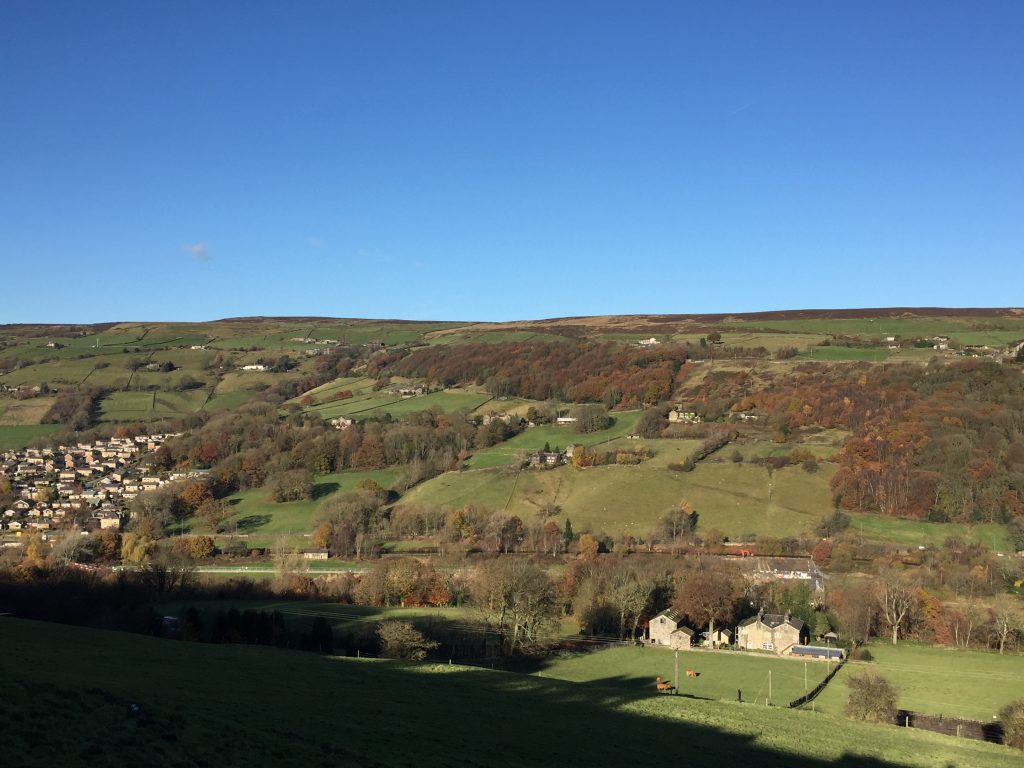
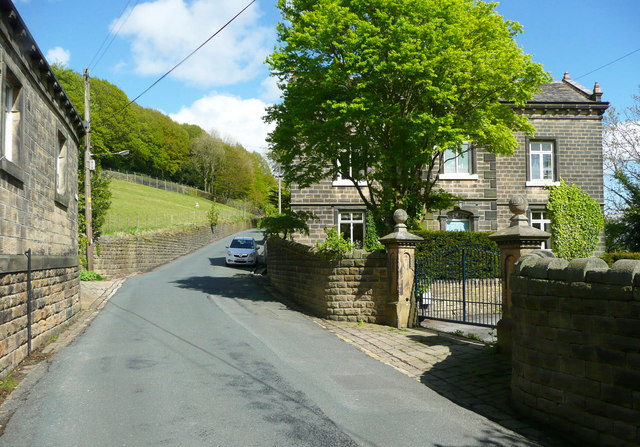
He became the senior partner in Messrs Moss Bros and chairman of the English Fustian Manufacturing Company. James’s epitaph at Wainsgate chapel reads:
….also of the said James Moss aged 57 who on the morning of April the 5th departed this life after patient endurance of accumulated suffering, which he knoweth no more.
But freed from sorrow, sin and pain
to golden harps above
Worthy the lamb that once was slain
is now his song of love
and while eternal ages roll
shall glory beam upon the soul.
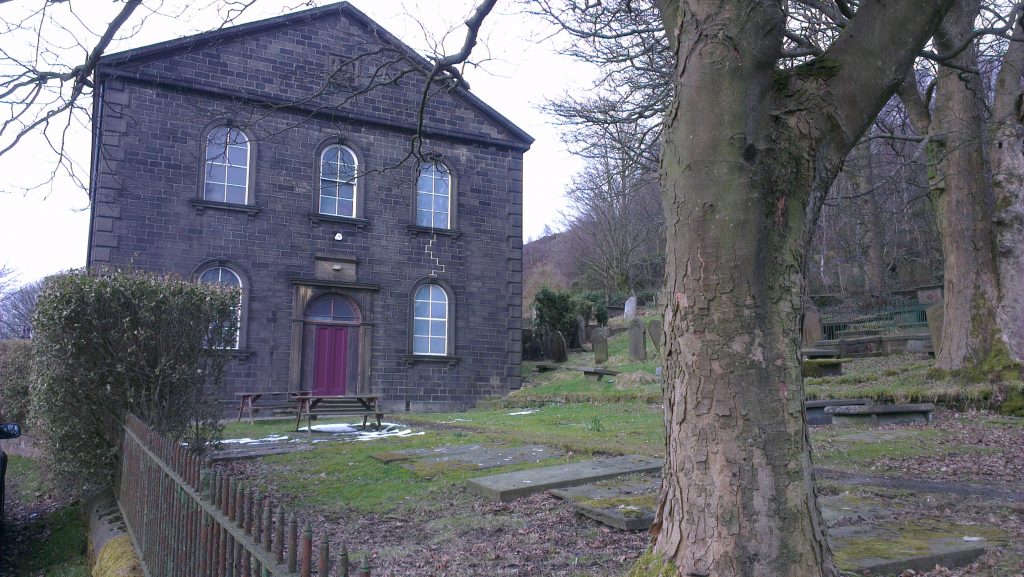
One of his sons – probably Joseph Hague wrote this elegy:
…“All die,- but not alike on all,
Devolves the fatal strife;
Some bow beneath a sudden call,
And some thrown back on life,
Breathe o’er again their parting breath,
And linger at the gate of death.
The faded cheek, the fallen eye,
Betoken’d quick decay:-
But so my father could not die,
And slowly pin’d away;
The pains he bore from week to week,
Made the flesh quiver on his cheek.”…
One of his descendants has offered to show me the location of the Moss graves at Wainsgate, a remote location high above Hebden Bridge. According to Ken Stott James had a “refined taste for music and conducted in the worship of song. His services in this department were deemed almost indispensable. He was remarkable for the energetic manner in which he conducted the choir, singing heartily “as unto the lord.” According to ‘antiquarian’ “at Machpelah the only houses were those belonging to Mrs Stephen Fawcett and occupied by herself, Mr T. Wade and Miss Moss. The plot of ground adjoining, upon which is now built the house of Mr Abraham Cockroft was Mr Fawcett’s garden. Fawcett’s wife and one grandchild were buried here. That’s when he named the place Machpelah. The bodies were but later reinterred at Wainsgate.
James became a friend of John Fawcett. James would have worn the same type of clothing as Fawcett in his portrait. According to Wikipedia John Fawcett (6 January 1739 – 25 July 1817) was a British-born Baptist theologian, pastor and hymn writer. Orphaned at the age of 12 Fawcett became apprenticed to a tailor and was largely self-educated. He became a Methodists at the age of sixteen under the ministry of G. Whitefield, but three years later united with the Baptist Church at Bradford. Having begun to preach he was, in 1765, ordained Baptist minister at Wainsgate, near Hebden Bridge, Yorks. Ebenezer Chapel, now an art gallery, was built by Dr John Fawcett of the Wainsgate Baptist Church in 1777. It could accommodate 500 to 600 people – for the growing population in the valley at Hebden Bridge. In 1786, work began on a Sunday School. This was one of the first Baptist Sunday Schools in the country. By 1856, the building at Ebenezer was too small and the current church, Hope Chapel, next door to my building was built at a cost of £3,750 and in a prominent site in the developing town. The former building, Ebenezer, was used as the Sunday School and a lecture room. It was at this time that the name Hope was adopted. Each of James Moss’s children was registered at Ebenezer Chapel and in December, 2019 I attended a lecture about the building given by the couple who now live in the rear apartment above the chapel.
In 1772 he was invited to London, to succeed the celebrated Dr. J. Gill, as pastor of Carter’s Lane; the invitation had been formally accepted, the farewell sermon at Wainsgate had been preached and the wagons loaded with his goods for removal, when the love and tears of his attached people prevailed and he decided to remain. In 1777 a new chapel was built for him at Hebden Bridge. This was Hope chapel, which is next door to my building. About the same time he opened a school at Brearley Hall, his place of residence. One of my Moss ancestors lived at Brearley Hall, as did Branwell Bronte! In 1793 he was invited to become President of the Baptist Academy at Bristol, but declined. In 1811 he received from America the degree of D.D., and died in 1817, at the age of 78. Dr. Fawcett was the author of a number of prose works on Practical Religion, several of which attained a large circulation. In 1762, Fawcett joined the Methodists, but three years later, he united with the Baptist Church and became pastor of Wainsgate Baptist Church.
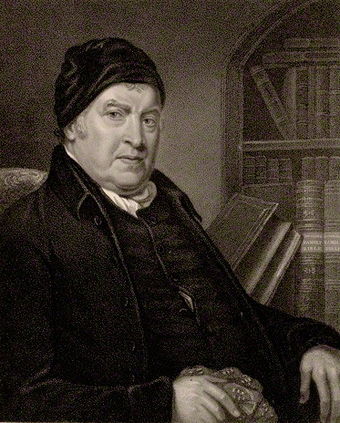
Fawcett served for seven years, despite a small income and a growing family.[ It seemed only practical that he move to a church that paid a larger salary. When he received a call in 1772 to the large and influential Carter’s Lane Baptist Church in London[2] he planned to accept the call. But at the last minute he changed his mind, and remained at Wainsgate where his salary was £25 a year. To commemorate this event,[3] in 1782 he wrote the words to his “Blest Be the Tie that Binds” hymn,[4] his most famous hymn by far.[5]
Fawcett’s grave in the graveyard of Wainsgate Baptist Church
In 1777 a new chapel was built for him at Hebden Bridge, and about the same time he opened a school at Brearley Hall, his place of residence. In 1793 he was invited to become President of the Baptist Academy at Bristol, but declined. In 1811 he received a Doctor of Divinity from America. Fawcett wrote that James was a deacon at the baptist church in Hebden Bridge when Fawcett was the pastor there. All James’s children, apart from Joseph Hague were baptised there.
Grace continued to live at Machpelah, surving her husband by 31 years. She is buried at St James, Hebden Bridge where I have played the organ for occasional services.
Todmorden Advertiser and Hebden Bridge Newsletter – Friday 02 March 1906:
DEATH OF MR. JAMES MOSS, OF HEBDEN BRIDGE. It, is with sincere regret we chronicle the death of Mr. James Moss, of Ewood Court. Mytbolmroyd, and head of the well known firm of Moss Brother., Fustian manufacturers, Hehden Bridge, and Bridge-royd, Eastwood, who died on Monday forenoon last, after short of a week’s illness. He was at his usual place of business on the previous Monday, apparently all right. He was slightly indisposed on the Tuesday, and Dr. Herbert Thomas, of Hebden Bridge, was called in. The illness unfortunately developed into that dangerous complaint, pneumonia, in rather an acute faun. This was the report on Thursday night. Friday morning his relatives and friends were relieved of some anxiety by the report that he had experienced a better night, and was breathing more freely. After that be varied, but the worst does not seem to have been feared until Monday morning, when a bad night had left the patient somewhat exhausted. Dr. Thomas was at Ewood Court early that morning. He recognised the gravity of the case, and suggested that extra medical advice should be called in. But, as it turned out. there was no time left for that. Before anything could he done Mr. Moss hod a bad attack of coughing, and within ⢠few minutes of that, time he departed this life, hie end being somewhat sudden and unexpected. The sad news quickly spread and was received with profound sorrow and regret. It had not been generally known that Mr .Moss was seriously ill, and to those who were ignorant of it the news of his demise came like a shock of consternation but his nearest friends who were acquainted wlth his temperament had not been free from anxiety from the time they learned the nature of complaint. He was taken away in the prime of life, for be was only 55 years of age. He had led an active and energetic business life, and was indeed a business man all through, regular and methodical in hls habits as clockwork, one who made t hobby of his business and really enjoyed it. His place will not be easily filled. He took a deep interest In anything which affected the welfare of the district, and was for more than a dozen years one of the most active members of the Hebden Bridge Urban District Council. A widow and five daughters survive to mourn for the loss of him; but his loss will also be felt in circles far beyond his own family. His business relationships gave him a wide personal acquaintance he was affable. sociable, mid approachable to all. As senior partner in the firm of Messrs: Moss Brothers, fustian manufacturers and dyers and as chairman of the English Fustian Manufacturing Co (a combination of several large business undertakings in the fustian trade), Mr. James Moss occupied an important and influential position In the commercial life of Hebden Bridge and dlstrict At all the branch establishments of the combine flags have floated at half-mast during the week. As a boy Mr. Mose attended his relative’s seminary. familiarly known as “Moss’s school.” at Salem and Slater-bank. His first occupation on leaving school was that ‘of book keeper at Breck Corn Mill, then in the ownership and occupation of Mr. James Bairstow. There he remained for several years. and became the rider-out, or traveller. for the firm. The time came when through declining health Mr. Bairstow wished to retire from the business Mr. James Moss had won the confidence of his employer who entrusted him with responsible posts while still comparativeiy young ; and he was still in the twenties when the Bairstow family made him an offer in conjunction with another employees. to hand over the business to them and find the necessary capital wherewith to work in. For some reason or other Mr. Moss declined the offer, and decided to join his brothers. who had commenced business as fustian cutters and manufacturers at Hebble End. Mr. Hague Moss, their father, seems to have trained the lads in sound business habits. They got on very well together for some time, and not many years had elapsed before it was necessary to take larger premises. Through a local failure they became possessed of the business premises in Brunswick street which still( considerably enlarged,) form the centre of the firm’s various undertakings. One of the brothers had withdrawn previous to that, and the eldest brother, Mortimer, withdrew later, and the business was eventually left in the bands of Messrs James, Fred. and Abraham Mom. From small beginnings it developed Into a great concern, thank. to good business skill and close attention. Some five years ago there sprang into existence the English Fustian Manufacturing Co, a combination of local firms of which that of Messrs Moss Bros was the greatest. Of that combine Mr. James Moss became the chairman. The change made no difference in the regularity and punctuality with which be attended business. Commercial travellers and others who had occasion to call at Brunswick-street were fairly sure that they would find Mr. James Moss at his post. Even the trams knew him for his regularity. He was quite a pattern of punctiliousness in his business affairs. Mr. Mose was first elected a member of the Hebden Bridge sanitary authority, then known as the Local Board. in 1888. He remained a member until 1902. Din ing period he was associated chiefly with the sanitary department, and be certainly took great interest in this and In all the affairs of the Council. He served us chairman of the Council in the years 1899-1900 and as vice chairman in the years 1888-1901.. In this connection he was proudest of hie connection with the Sewerage Committee, with which he was identified on chairman from the time of its formation in 1891 until he was appointed chairman of the Council. And it was during his chairmanship of the council when these works were opened in 1900. Reference war made to his demise at the Hebden Bridge Urban Council meeting on Wednesday night. THE FUNERAL took plain yesterday afternoon. and was of a very imposing character. After a short religious service at the house the cortege left Ewood Court at 12.30, and all along the route from there to Zion Baptist at Hebden Bridge tradesmen drew their shutters and private residents their blinds in silent sympathy with the bereaved. There were mourning coaches following then hearse in the first seven of which, were the chief mourners. Wreaths were sent by Mr. and Mrs. John Crowther, Mr. and .Mrs Young (Heaton chapel), Messrs R. Crabtree & Sons, Sons. Mrs, J. Hutchenson (Bury) Mr. and Mrs. Rose, Miss West, “Rosie” and Messrs. Ashworth Bros. The workpeople connected with Bridge Royd works in a subscription for a floral tribute, but a when it became known that It was the desire of Mrs Moss that there should be no flowers, it was resolved to institute scholarship open to children at Eastwood school, and of the value of 5 pounds.
The bearers were all old employees of the firm of Moss Brothers. The coffin was of polished oak, with solid brass mountings. and the brass plate bore the following inscription JAMES MOSS Born July 11. 1850 ; Died February 28, 1908 At the chapel there was a crowded congregation comprising many of the regular worshippers there, the bulk of the employees of the firm, representatives from business houses and friends of the Hebden bridge UD Council, the English Fustian Manufacturing Society, The Prince Frederick Masonic Lodge, Local War Fund Committee etc. Mr Joseph Smith, who officiates as the regular minister of the church delivered an oration.
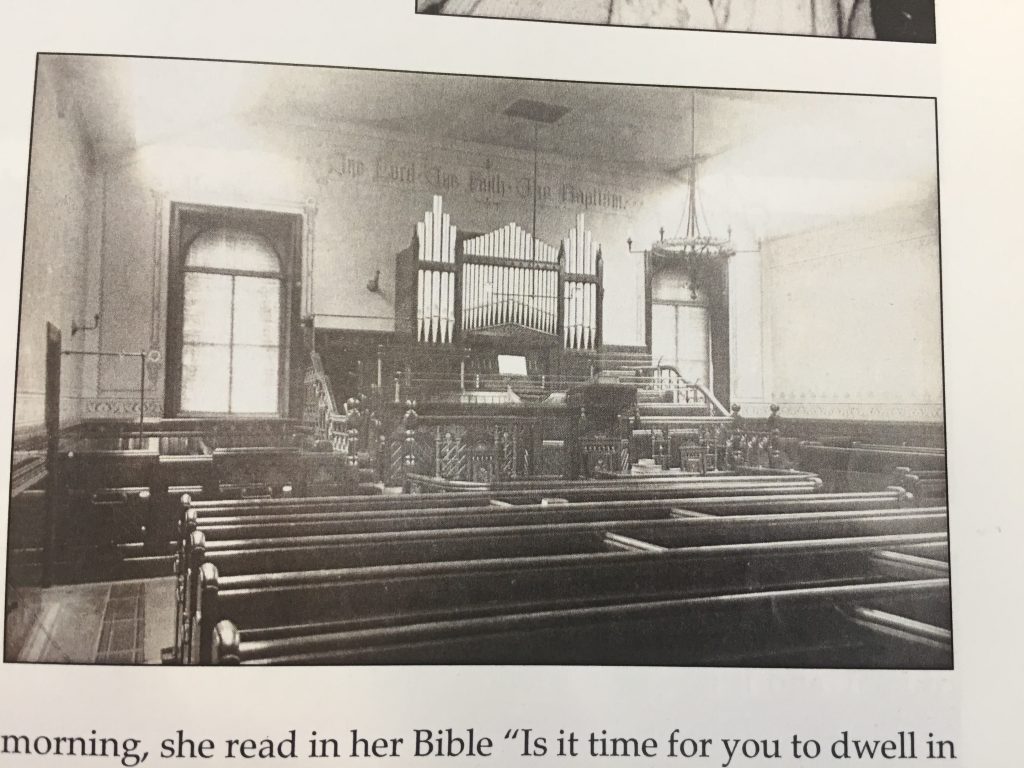
- Joseph Haigh (Hague) Moss 1791-1861
Joseph was baptised at Cannon Street chapel. Manchester in 176. The chapel no longer exists but Jonathan Schofield has this description of its location and history: “After widening and damage in World War II, all trace of old Cannon Street was finally removed as the Arndale Centre emerged in the 1970s. The street had been built on what was previously open land from the middle of the eighteenth century and several Georgian period properties survived until 1907. Cannon Street Independent Chapel, one of the first buildings to arrive from 1760. At the rear of the building there were several tombs. The last interment had been that of Dugal Mann, tape manufacturer, in 1788. The building closed as chapel around 1860, by which its congregation had long disappeared from the city centre.”
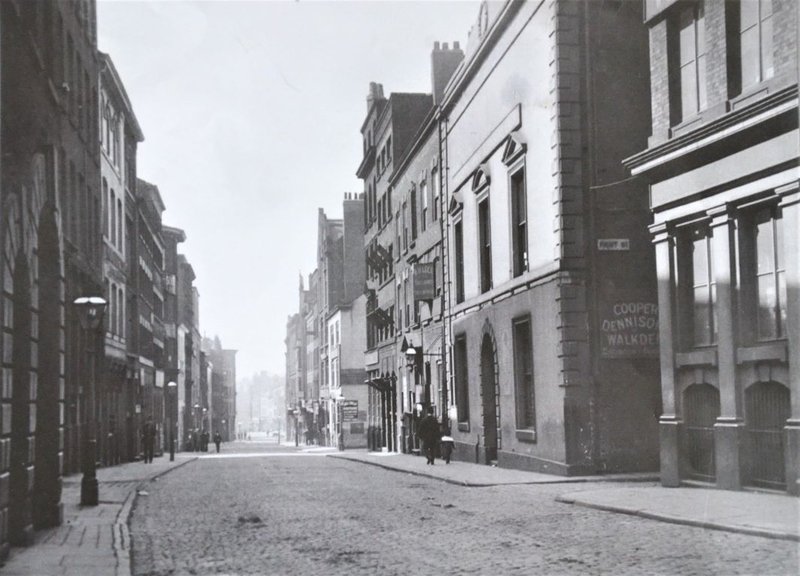
Joseph’s mother (Mary Moss, nee Hague) died when he was 18 and 4 years later he married Jane Moorhouse in Halifax Minster. I’ve not been able to find out anything about her. Within a year their first child was born and, keeping on the family tradition of giving the first son the surname of the mother as a Christian name, he was named Moorhouse Moss. They went on to have 10 more children, two of whom died in their first year and it’s possible a further 2 fell into this category. At the time of his marriage he was a fustian cutter, just like his father, but the next mention of him is as a schoolmaster, aged 50, at Calderside on the 1841 census. It’s the last entry in the census and appears after Hebble End but I haven’t been able to locate the building. The 1851 census route is Bridgegate, Toll House, Hebble End and Bridge Lanes. The Moss school is the only building listed at Hebble end.
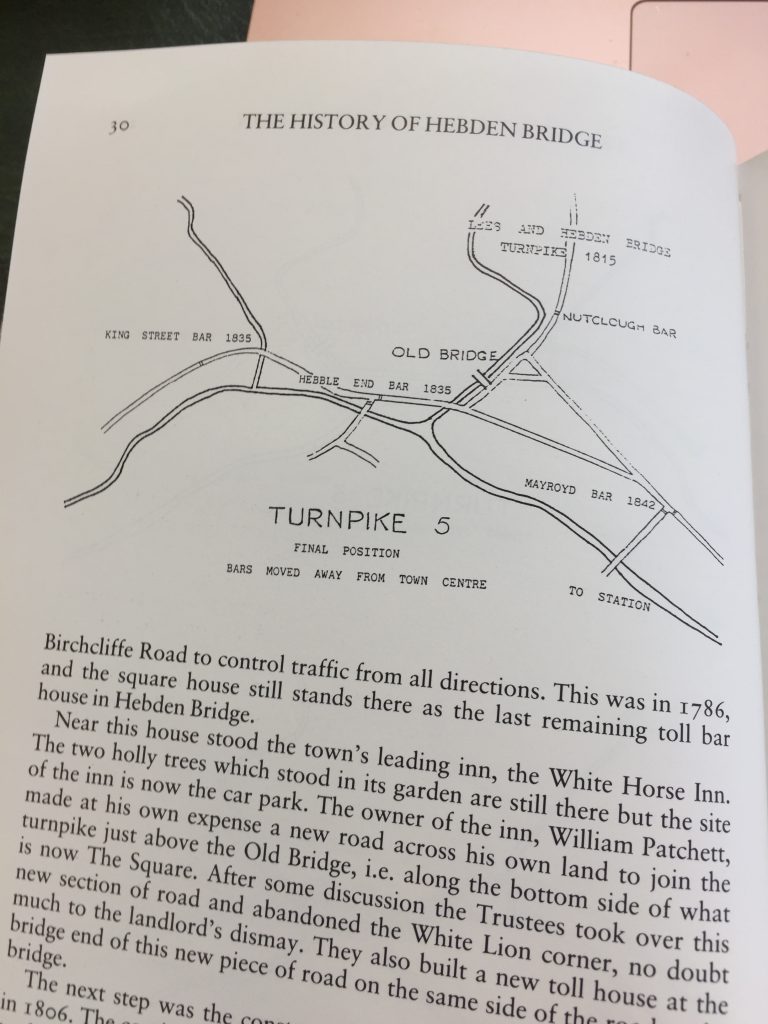
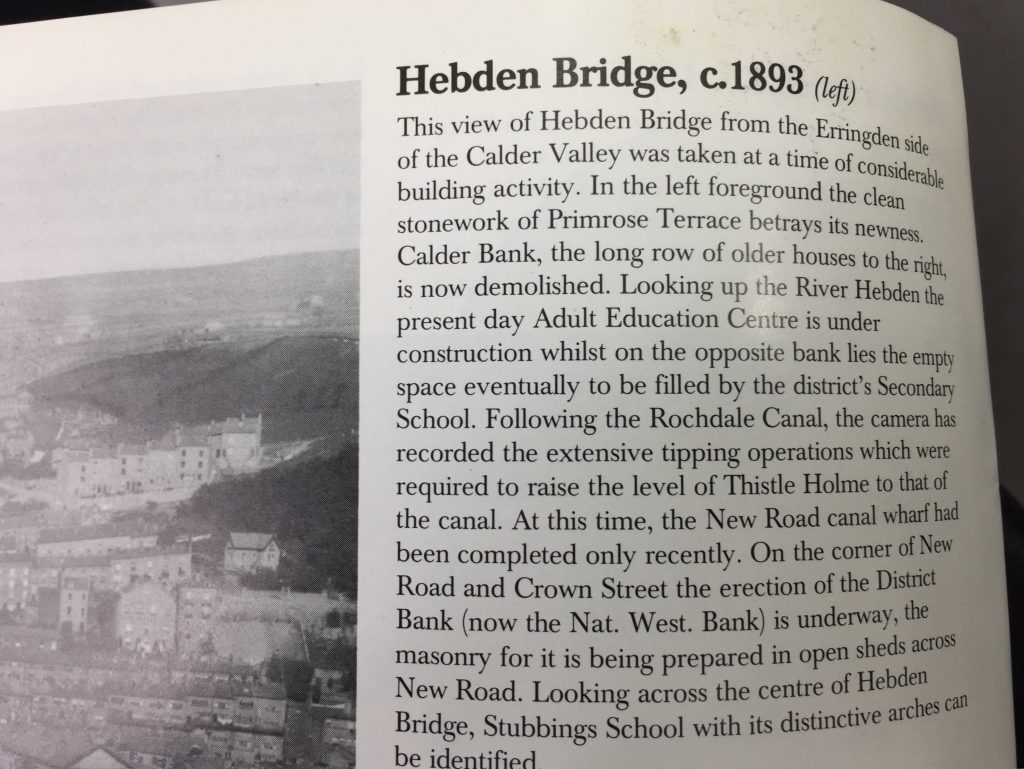
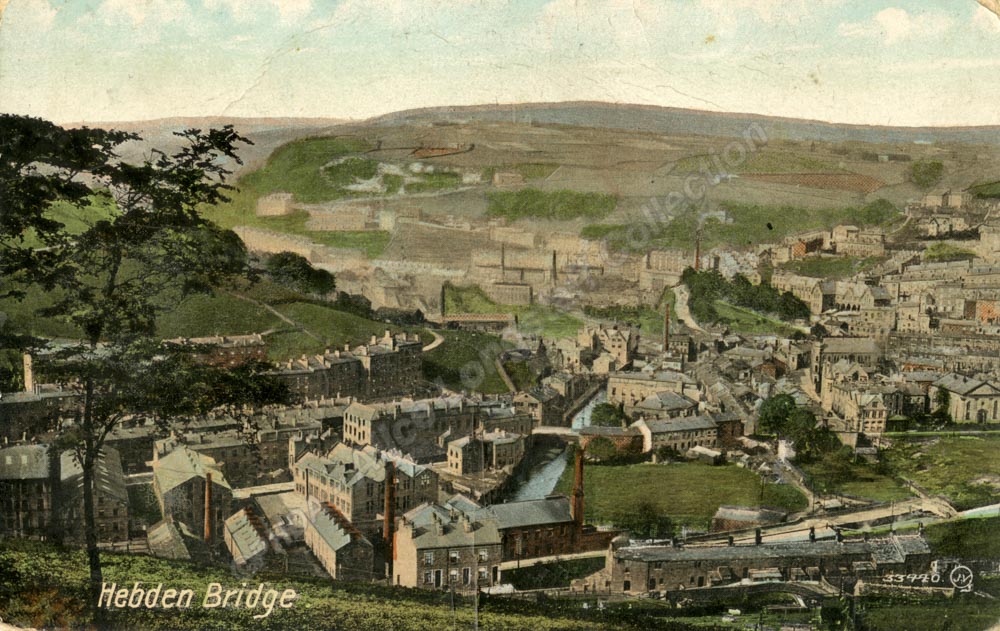
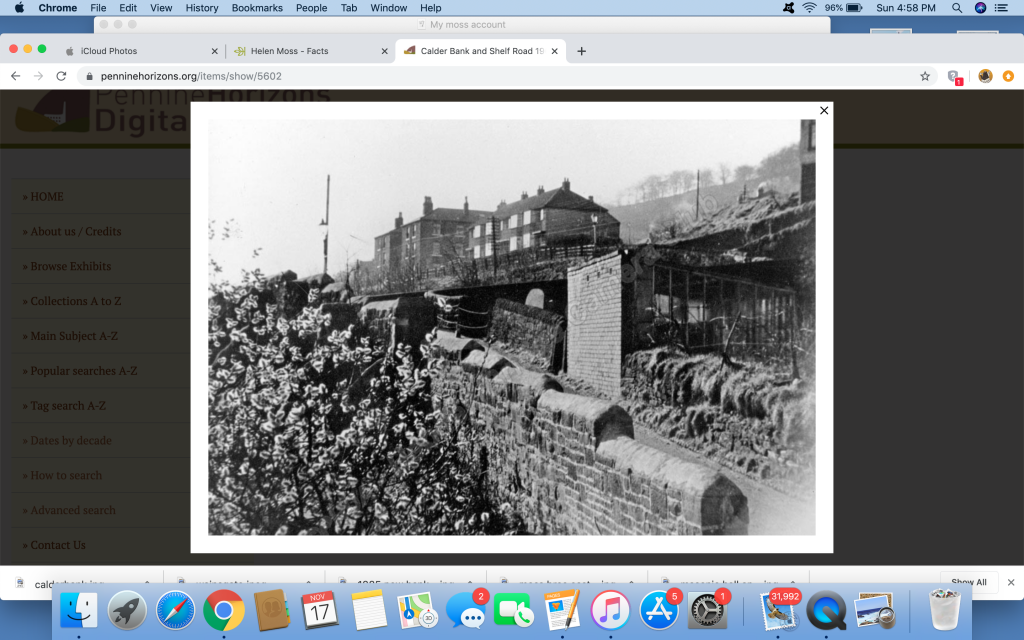
The only students listed are his own children. Perhaps this was Hebden Bridge’s first Home Schooling experiment! By 1851 He was running his own school and his wife, Jane was named as the schoolmistress. They had 9 boarders from age 11-13 all born in Lancashire or Yorkshire.
1851
Joseph Moss. 59. Schoolmaster. Manchester
Jane. w 58. Mistress. Wadsworth
Mary. d 35. Wadsworth
Grace Fielding. 10. Scholar. Todmorden
Eliza Ann Brewer. 12. Brad.ford
Mary E. Tiffany. 10. Halifax.
John Chadwick. 13. Bacup.
John Worrall. 12. Cheshire.
James Hardman 11. Bacup.
Samuel Atherton. 10. Bacup
John Smith. 12. Pontefract.
William Firth. 1. Todmorden
Susannah Greenwood. 14. Servant, Heptonstall
However, by 1861 the school had moved to Slater bank and there are 26 students. So at this point I need to talk about the Moss Schools:
SCHOOLS
There’s a school listed at buttress bottom in the 1851 census run by Henry Bourne Smith , b. Heptonstall, and his wife Mary Ann, b Stansfield. Again, the only 4 listed scholars are their own children. I can’t find them on any other census or in marriage records. There is a Henry Smith on Bridgegate, a shoe maker and boot maker married to Mary on the 1861 census.
Before the coming of the Board schools (ed. in 1870) there were several private schools in Hebden Bridge, attended by fee-paying students, some of them boarders. When New Road was made in 1806 a schoolroom was demolished and rebuilt. George Mellor, whose school it was, moving into Bridge Gate and Samuel Chambers taking over the new building. There was also a Mr. Moorhouse (ed. JH Moss married Jane Moorhouse. Any relation? Can’t find) who kept a school in part of the White Horse Inn, but the best known of these schools was Moss’s Academy. from Research done by Colin
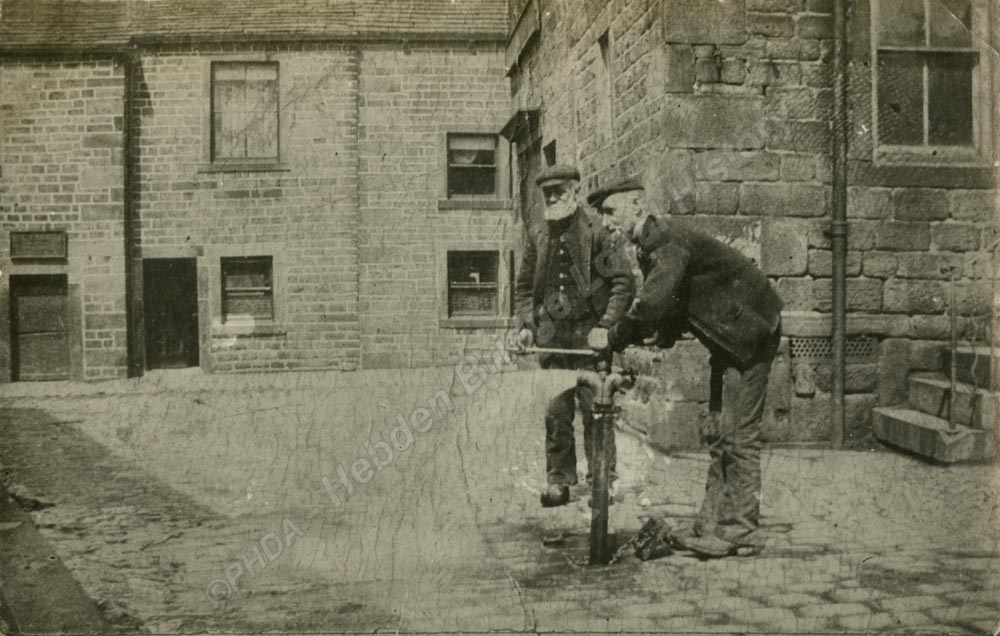
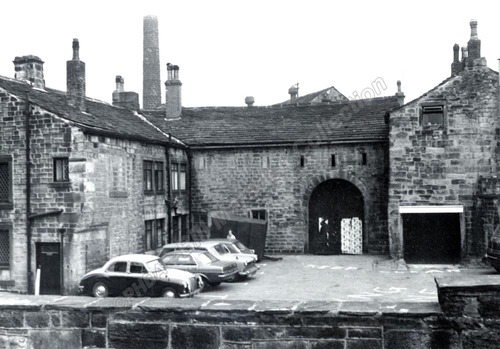
From M/S4/4 Sketches of Old Hebden Bridge and its people by Antiquarian 1882, chapter 2 (transcribed?) by Ken Stott. The author was born in 1804 and this series of sketches was published in 1882 in Hebden Bridge Times and Calder Valley Gazette in installments between January and June.
“ In the minute book of the turnpike trustees for that time occur the following entries:
April 3rd. 1805. Meeting held at Wm Patchett’s, HB, the trustees treated with Patchett for land in the Holme, the Ing and the Brink, for 11p per yard. The trustees agreed to take down a building (ed. This must be the old school) in Appleyard’s land, in the occupation of George Mellor, and rebuild it upon a convenient place thereby.
Aug 7, 1805-paid $76 to Appleyard for 1,562 yards at Hebden Bridge, and $52-10-0 for re-building the school-house, to John Butterworth, mason, and for railing off the ground $4-0-0. .
Upon the school-house being pulled down Mr Mellor seems to have removed his school near The Shoulder of Mutton where I remember it being: the school-house mentioned as being rebuilt is now the building converted into four cottages, at the bottom of New Road, opposite Mrs Appleyard’s house, and occupied by Stansfield Riley and others. A Mr Appleyard left in his will, dated 1826, many buildings in town, including the White Swan. There’s another William Appleyard 1768-1829 who was an innkeeper and yeoman. In 1881 his daughter Ann was living at Holme House, and she died there in 1884. This is directly across from the current florists and so this substantiates the idea of the florists being the old school. I have a plan for the sale of land for the erection of my building. The land was purchased from Dr Appleyard.
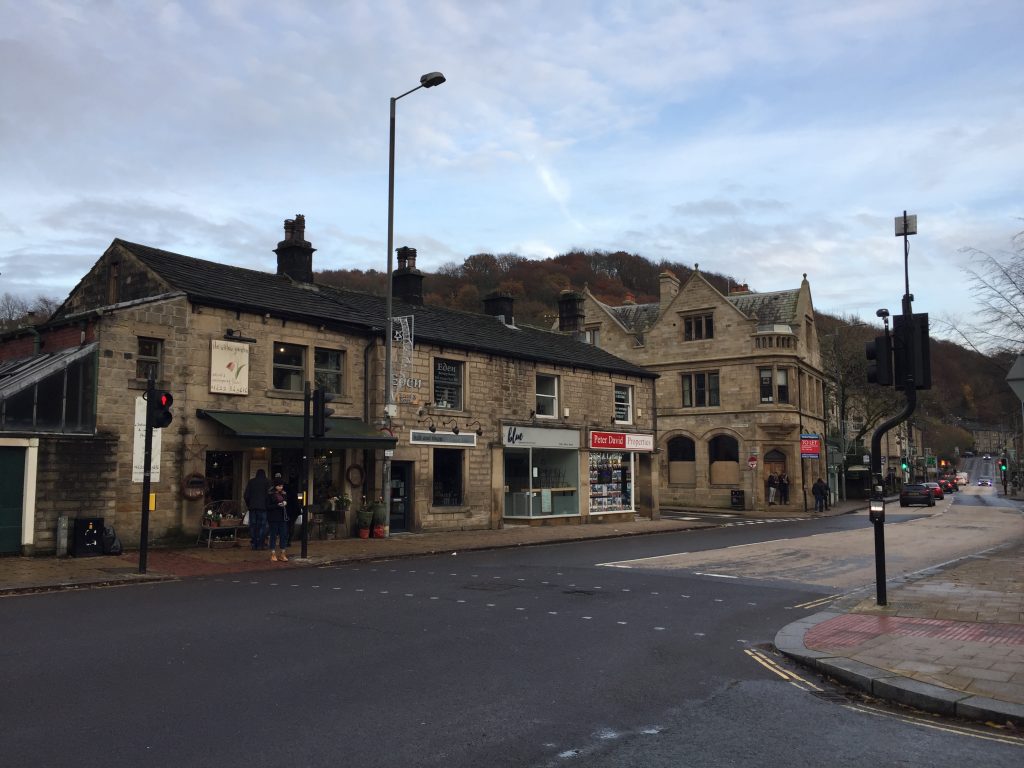
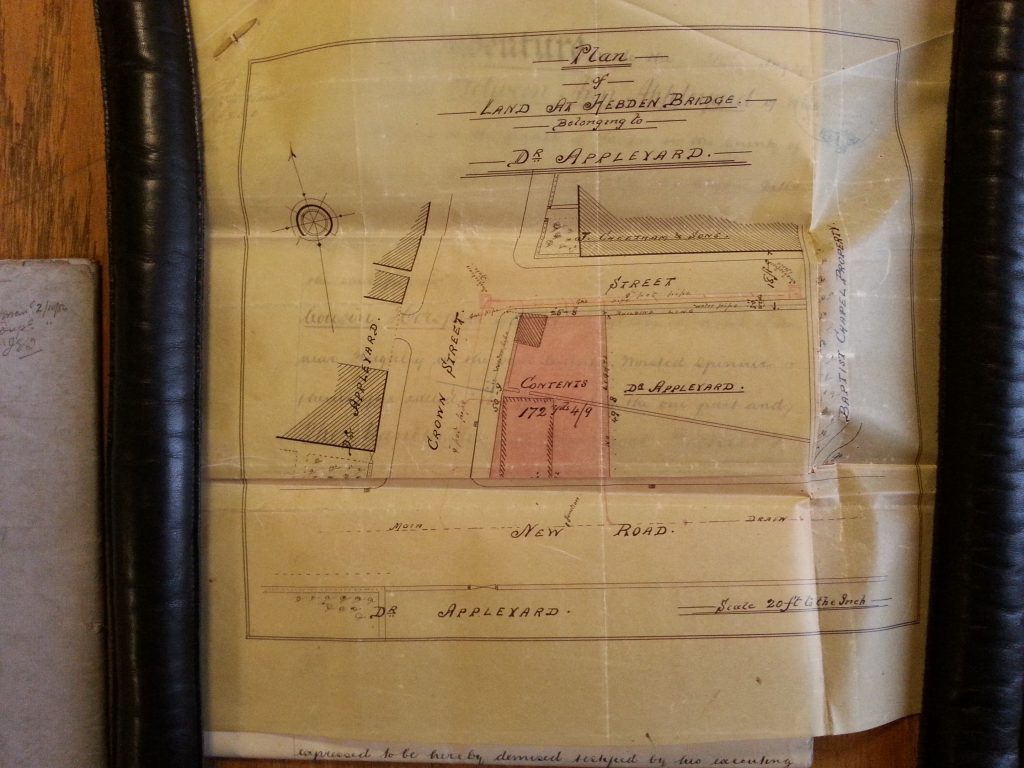
Whether Mr Mellor ever went bank to the new school-house or not I cannot say positively but I remember a Mr Samuel Chambers keeping a school there. This building in my time was the only one on New Road, with the exception of those opposite Croft Terrace in New Road, one of which is occupied by Mr James Wheelhouse.
Joseph Hague Moss, son of James Moss of Machpelah started a school about the year 1817 in a room in Lees Yard (the site of the present car park). It must have been successful as a few years later he moved into better premises at West End and then on to Hebble End. (Probably listed as Calder bank – or calderside???in 1851 census)
He was also involved with Salem Church and Sunday School, and he had the use of a room there as a classroom. [Calder House Academy in Salem Sunday School 176 on roll in 1851 Education Census.]
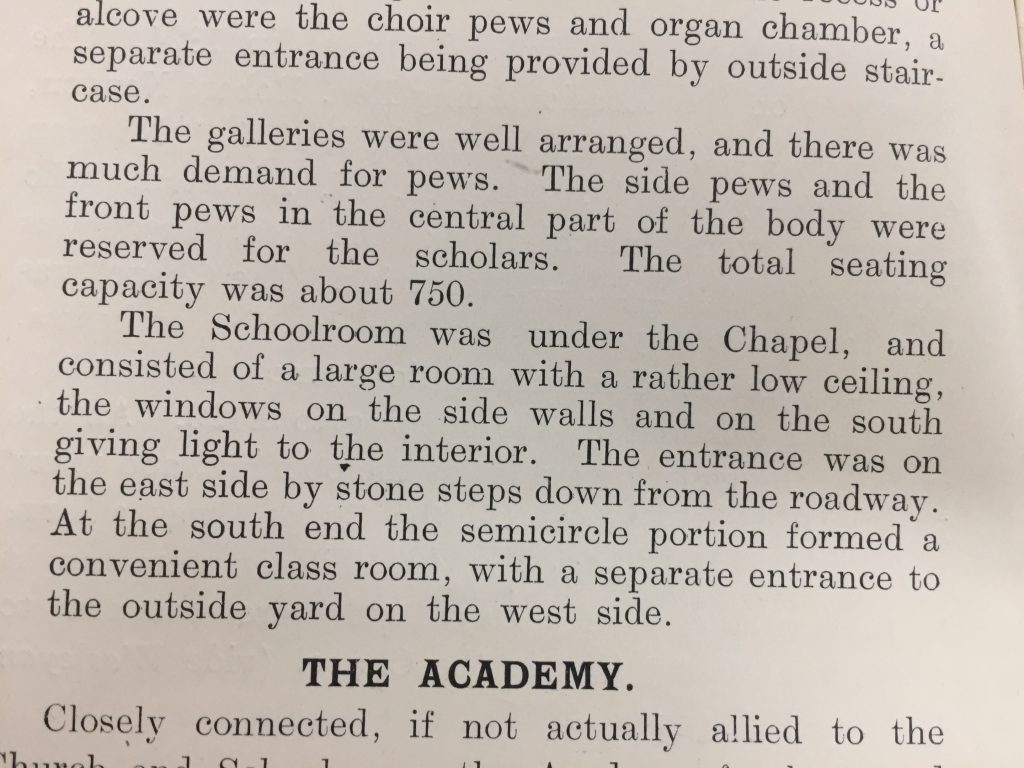
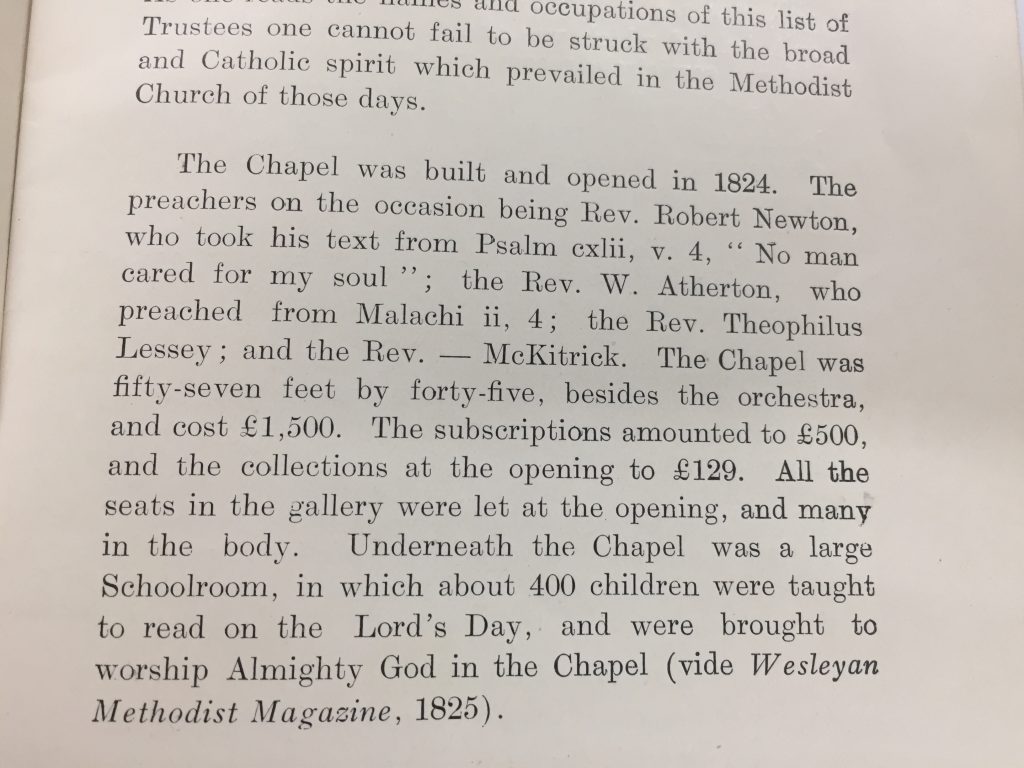
Salem chapel
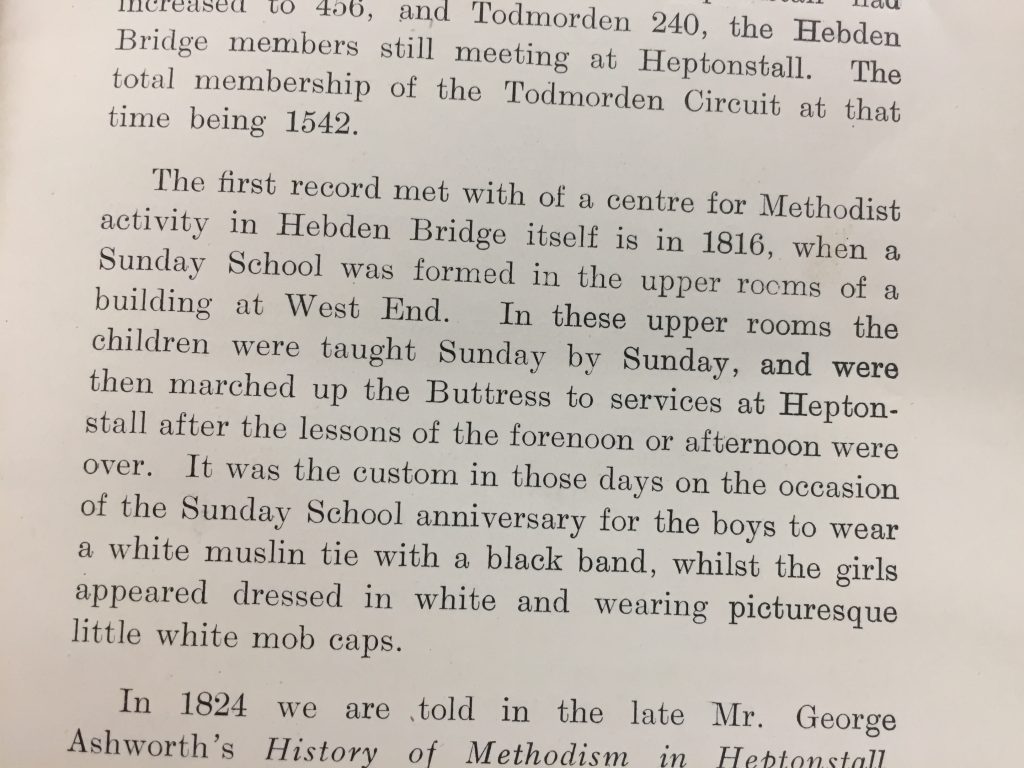
The
1851 Census shows him, aged 58 and born in Manchester, living at Hebble End, next to the toll.. house, with his wife, Jane, aged 58 and born in Wadsworth, and nine boarders.
Hebble End.
Joseph Moss. 59. Schoolmaster. Man.
Jane. w 58. Mistress. Wads.
Mary. d 35. Wads.
Grace Fielding. 10. Scholar. Tod.
Eliza Ann Brewer. 12. Brad.
Mary E. Tiffany. 10. Hx.
John Chadwick. 13. Bacup.
John Worrall. 12. Cheshire.
James Hardman 11. Bacup.
Samuel Atherton. 10. Bacup
John Smith. 12. Pontefract.
William Firth. 1. Tod.
Susannah Greenwood. 14. Serv. Hpt.
At the same time his son George Hague Moss was keeping a school at Slater Bank, aided by his sisters Ann (32), Esther (21) and brothers Alfred (19) and Edwin (17) and they had five boarders. In both schools the boarders were aged nine to 12 and lived fairly locally, the furthest away being Cheshire on one side and Pontefract on the other.
Joseph Moss died about 1860 (No) and George took over the two schools as “Moss’s Academy for Boarding and Day Students”. The building later used as the Masonic Hall was used as the school and the boarders lived at Slater Bank, and walked from there to Salem in procession every Sunday. The boys were known as “Moss’s Bulldogs” which suggests that they had occasional disputes with the local lads!
2. Mosses set up schools
1861- he’s now aged 70 they are living at Slater Bank with 26 students. There are 2 servants. -check. Apparently this was where the students boarded and they attended school in what is now the masonic hall on Hangingroyd Lane where I go to the Camera Club meetings. Joseph and his daughter Hannah and son Edwin are school teachers and assistant schoolteacher is Oscar Cockcroft. Some students come from as far away as London. The school Act giving every child the right to free education was passed in 1870.
1863 book of poems published. “The Orphan Boy” was very popular and was printed and sold throughout the country. I’ve held a copy of his Miscellaneous Poems at Birchcliffe.
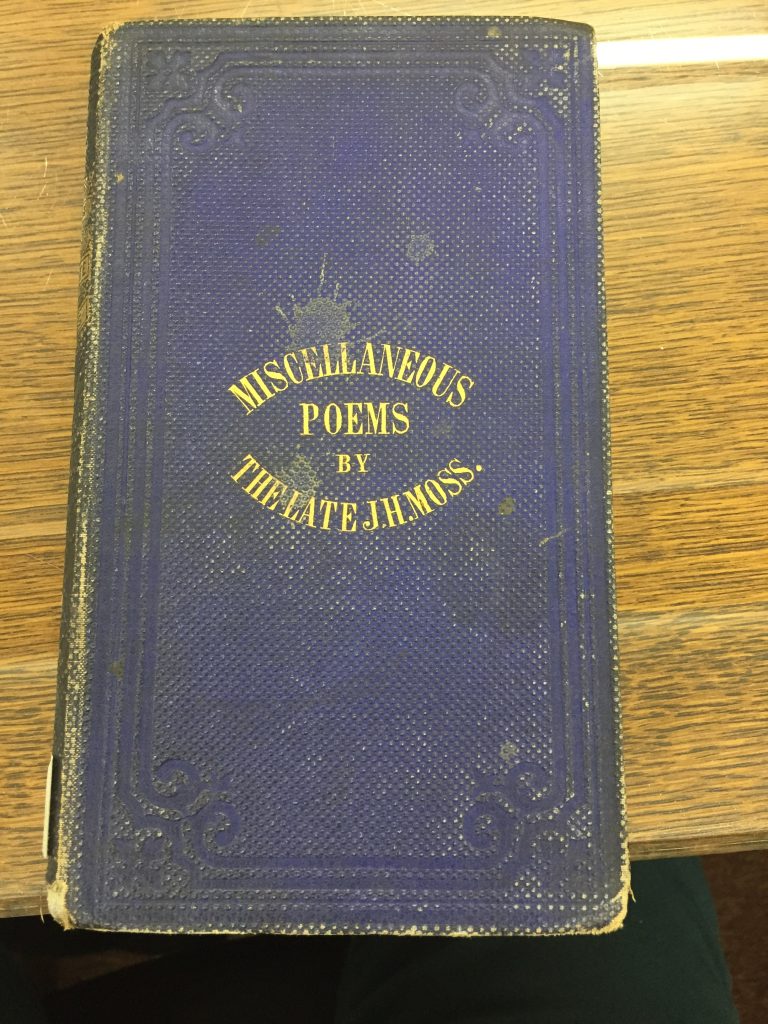
Bandmaster of Hebden Bridge Brass band?
Lived with his son William at Lee Mill cottages.
1871
RMP214 Birchcliffe 1812
Handwritten letter from Joseph Hague Moss to Mr Edward Ramsden – Jumples, Mixenden. This is likely to be the Rev Edward Ramsden, 1791-1853, son of John Ramsden
| Ramsden, Rev Edward | Ref 56-R115 |
[He was educated at St John’s College Cambridge [1813], ordained Deacon (Chester for Lichfield) [5th April 1817], and appointed Perpetual Curate of Lower Darwen, Lancashire [1829-1839] before becoming Perpetual Curate of St John’s Church, Ovenden [1838], the first incumbent of Bradshaw [1839-1853], and Curate of Illingworth [1841]. He wrote a number of collections of verse including The Christian Minister [1842] and Christ the Foundation [1844]. The family lived at
Jumples House which was demolished in 1961.
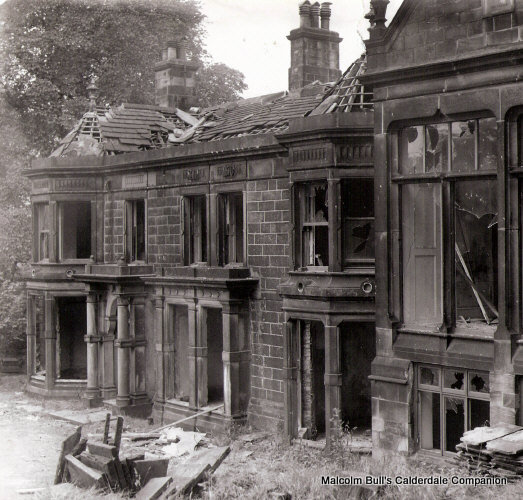
Dear Sir, Having frequently seen your poetical productions in the Wakefield Paper I have long waited for an opportunity to make myself known to you. Being roughly the same age with yourself I have ___ the muse but with far less success than you appear to have done. For only a few days ago I was mightily pleased with a small pamphlet that fell into my hands entitled the Practicing Woman but lo! When I got to the end I found the following lines inscribed on the back – they seem to be the production of no mean pen- and perhaps the writer may be an offended methodist. Let that be as it may the cause of truth has nothing to fear- even from a more extensive satire if the foolish writer should determine to persevere. However, I will present you with a faithful transcript of what I have seen and believe me to be a friend desirous of your interesting correspondence – Joseph
I’ve read this book and sure enough
It is a lump of labored stuff
Which. Bit by bit at various times
Has all been moulded into rhymes
Most of the lines from bad to worse
Would make for b better prose than verse
For if one smoother word be found
To suit another is the sound
It must be shifter to the end
The broken parts of rhyme to mend
And yet poor thin g in thoughts so deep
He may have lost some nights of sleep
And doubtless may have had to seek
Full oft a quarter of a week
For words well suited to explain
The needless nonsense of his brain.
But after all for pity’s sake
We must some small compassion take
And do him justice in advance
He is a Poet born by Chance.
RMP:215
1813 Letter from J.H. Moss to Ramsden
Dear friend, March 5, 1813
Includes a letter he wrote ‘just as it stands’ in my 17th year
Oh love! Fond tempter – could I find in thee
That blest alliance to each virtuous aim;
That truth unrivaled, formed alike to know
A bliss in sorrow and a hope in woe;
With morbid pleasure would I grace thy name
And give myself they suppliant boast to be.
But ah! Too oft with formal joy elate
Th’unwary victims proudly meet their fate;
While long delay and hope derived at last,
Misplaced the future and revenged the past.
Ah! Then no more with joy the bosom warms
Ot trusts tomorrow hopeful of its charms.
But black despair, fast brooding drinks that quivering breath
And spreads a gloom on every avenue but Death.
I am now about 21 years of age, the oldest in a numerous family of motherless children who are continually pouring out their little prattling invectives against my singularity of action and appearance.
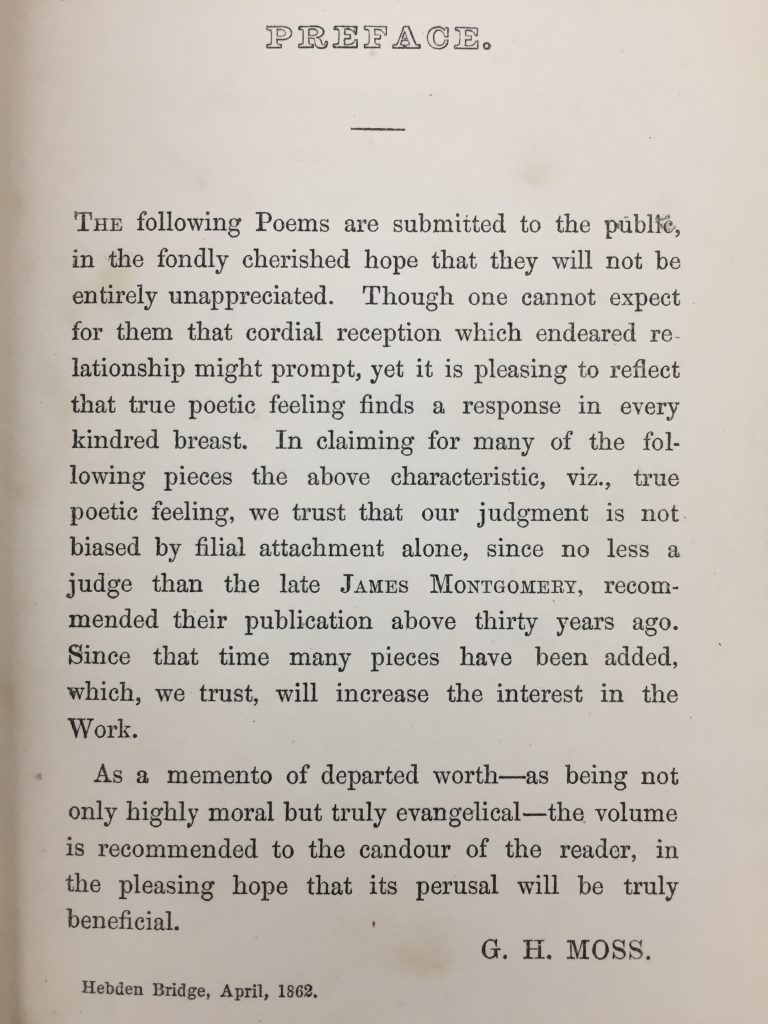
This post is my Happy Easter greeting to family and friends
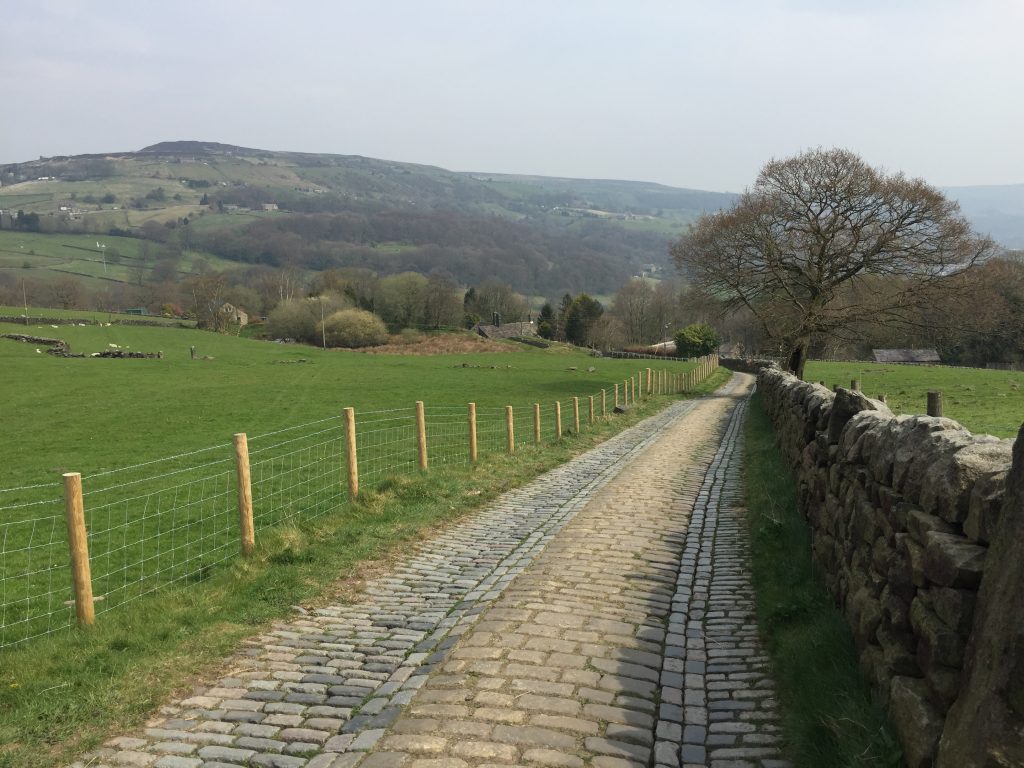
So it’s been two weeks now that I’ve been confined to walks that I can do directly from my living room. As the days have gone by I’ve found that this valley supplies enough new vistas and previously unexplored areas to keep me busy. It’s a wonderful feeling to explore a new footpath, see the town from a new angle, or notice a sign or building that I’ve passed many times but not noticed before. In the past people stayed more within the vicinity of their home, and it’s often seemed strange that people sometimes lived their whole life, never stepping out of a 10 mile radius of their homes. But during this last 2 weeks as I’ve explored I’m coming to understand that idea much more. And if I find myself on a path, looking at a view, passing a house where one of my ancestors lived, however distant a relation they might have been, I arrived home excited and eager to find out more about what I’ve just seen.
Take yesterday. I’d spent a couple of days downloading and transcribing newspaper articles, around 20 of them, mentioning one of my distant ancestors Stansfield Gibson – “quite the lad.” I’d been working on that in the morning and by lunchtime the fine weather on this Good Friday beckoned. I thought of the times when, as a young teen, living at Windermere Street my family had got up early, walked to the Tramways pub and boarded a bus to some distant place. I think these were excursions from my dad’s fishing club but I remember going as far as Symonds Yat in the Wye valley. I recalled these trips on always on Good Fridays and Easter Mondays.
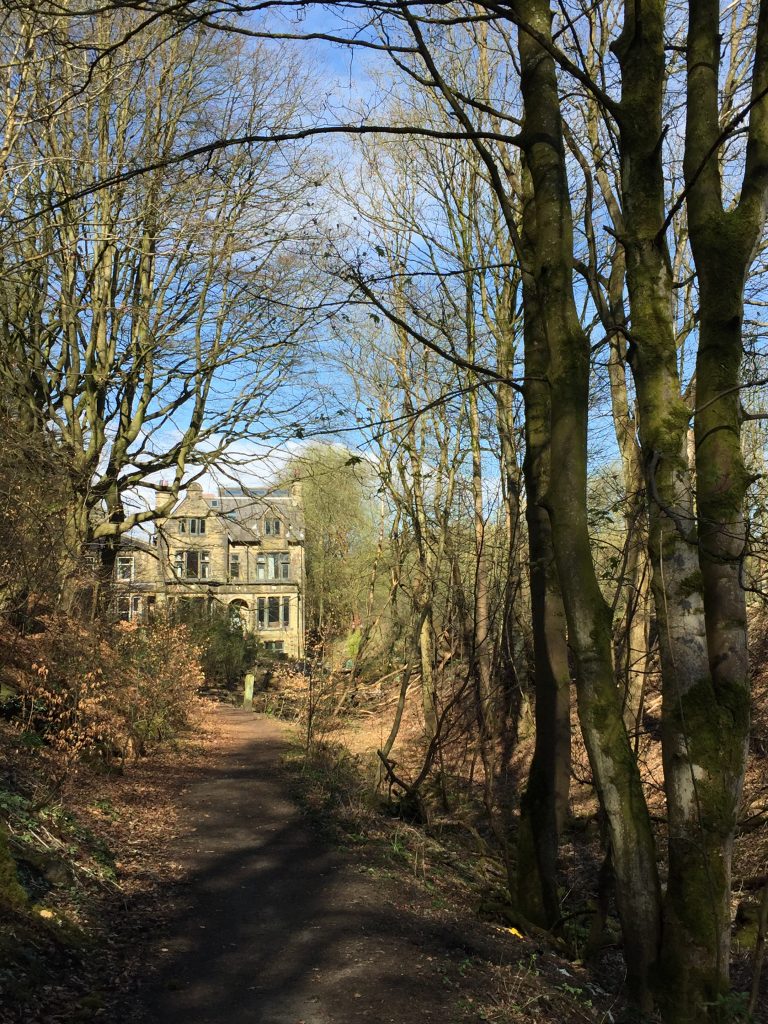
At the beginning of the lockdown I discovered a trail, new to me, that runs from behind Hebden Bridge railway station, following close to the railway track towards Mytholmroyd and leading to the bridge on Carr Lane. It felt magical. I felt as if I was the first person to discover this trail. At first I thought the track only led to a large imposing victorian house that is right up against the railway lines and which acts as my cue to alert me to get ready to get off the train when I’m coming in from the Halifax direction. But then, one afternoon, quite by chance I noticed a small yellow arrow on a post indicating ‘footpath.’ So off I trundled. The house, Crow Nest house is an imposing edifice. There’s something spooky about it.
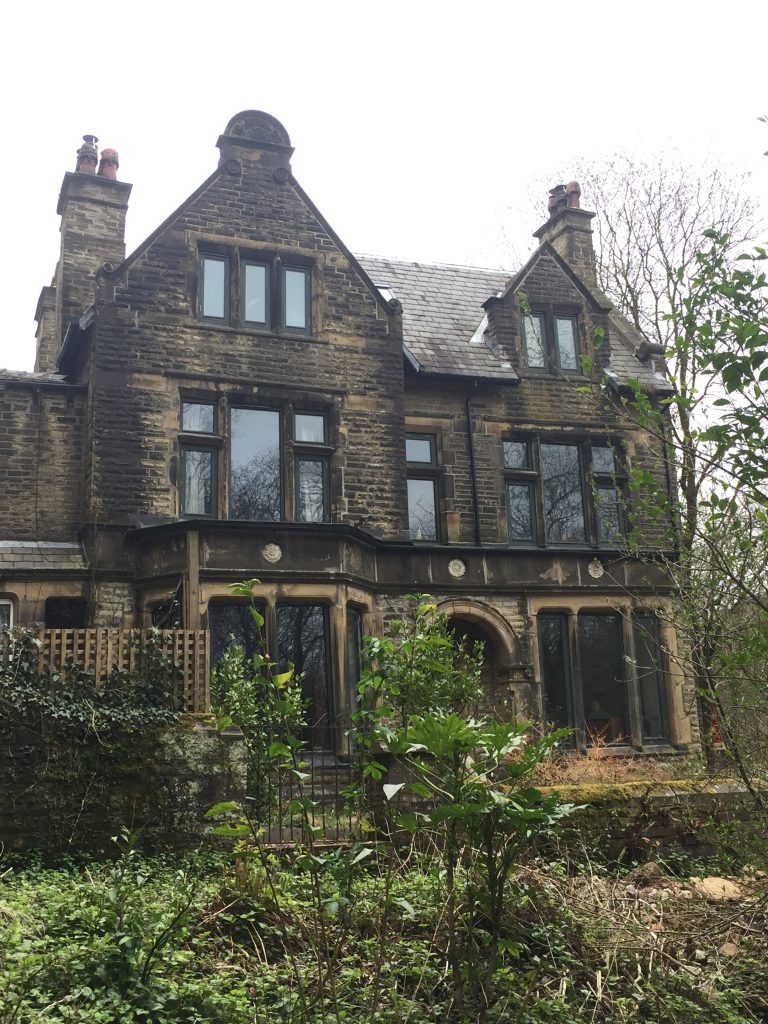
It reminds me of Fall of the House of Usher or the house in Debussy’s Pelleas and Melisande or Henry James’s Turn of the Screw. Most days since this first discovery I’ve taken this walk. I’ve seen 20 nappies on the line many of the days, I’ve witnessed someone giving instructions of camera usage over the garden fence at the requisite 2 metre distance. I’ve noticed the ‘Beware, cocker spaniel at large’ sign on the garden gate, and a man chopping logs.
(Update, Oct 7. Reading ‘A Century of Change’ tells me that the house once belonged to the manager of the Hebden Bridge gass works). The path passes through the bottom of Crow Nest Wood. To my right a steep bank is covered in trees whose varied barks fascinated me and lead to me take photos just of tree bark.
http://blog.hmcreativelady.com/wp-admin/post.php?post=10981&action=edit
I peered into a hole in a tree stump and was delighted to see a dim world filled with toadstools – for the little people, no doubt.
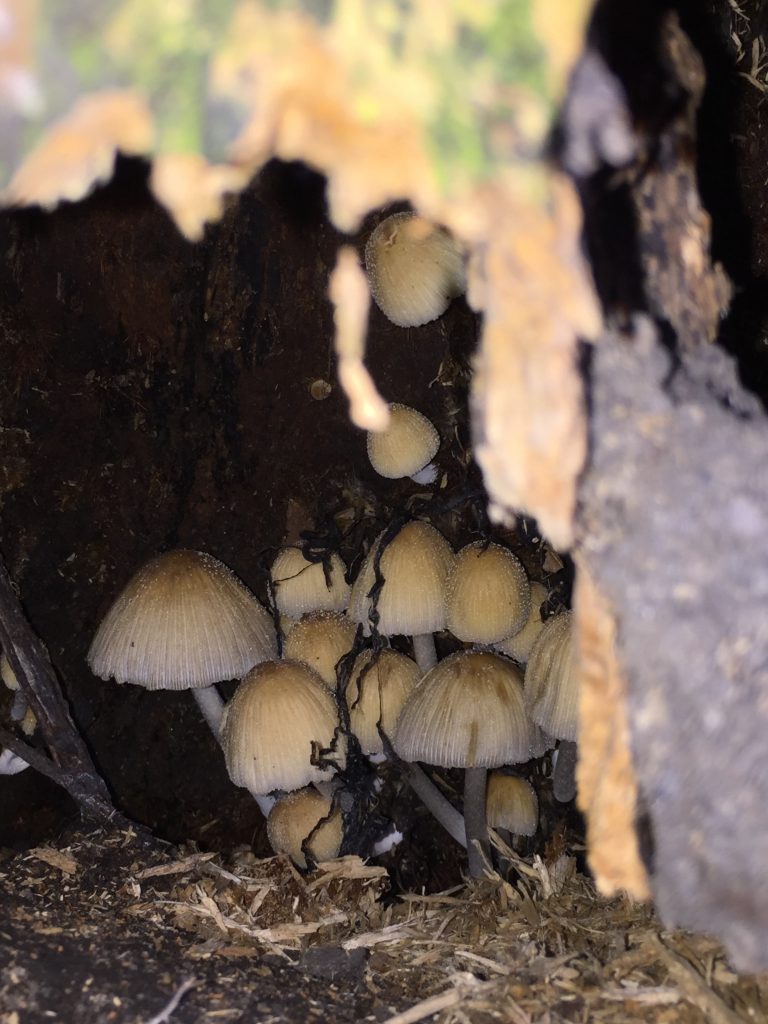
Occasional traces of man’s intrusion on this natural landscape bring half hidden pipe lines and broken fences. Two steep brick walls career down this hillside, one of them covered in now faded graffiti. To my left there’s a big boggy area running the entire length of the path. I think this suggests that the railway track is laid on a man made embankment. Occasional trains pass by within 30 ft of me: one passenger, maybe two on board what would normally be standing room only services between Leeds, Manchester and Preston.
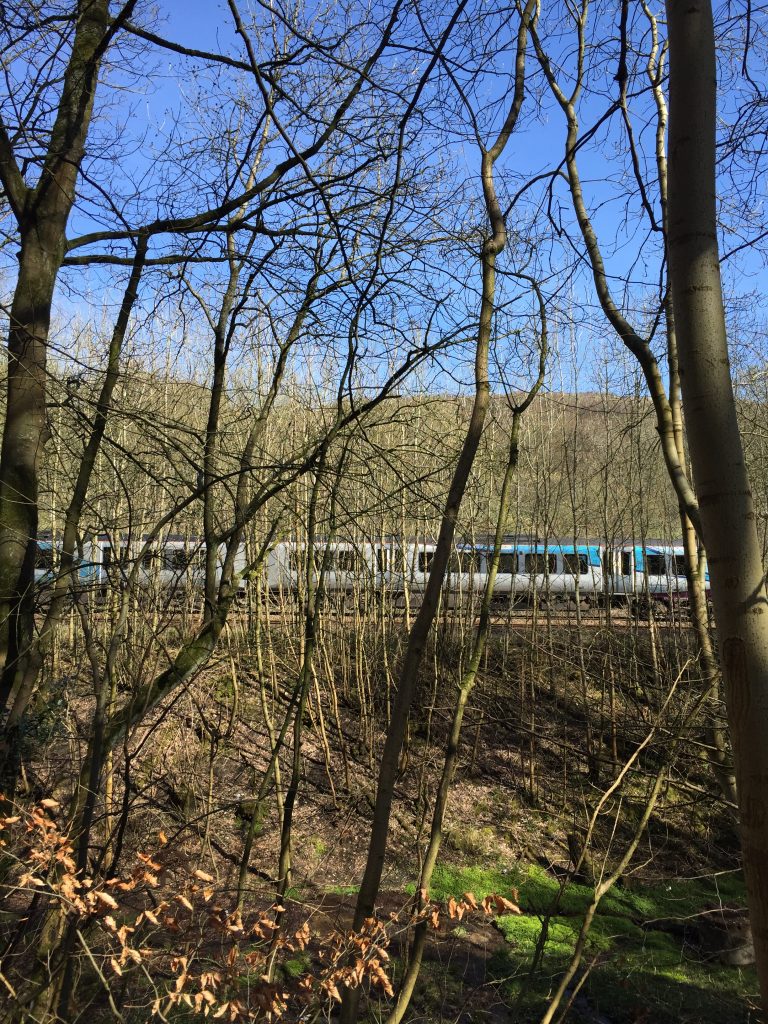
At my side of the boggy land is the remnants of a wooden fence, created, I think from old railway sleepers. I wonder, idly, if it would be silly to give some of my favourite trees names. I seem to be getting to know them intimately. One afternoon sees me taking photos of trees that resemble other things – a goose in flight, or maybe it’s a pterodactyl, Siamese twins, and intimate human body parts! I post a photo of a tree knocking down a wall onto Facebook and I immediately get a response from someone saying that it looks like a man with his hand in the air – so obviously I’m not alone in seeing ‘other things’ in these tree parts.
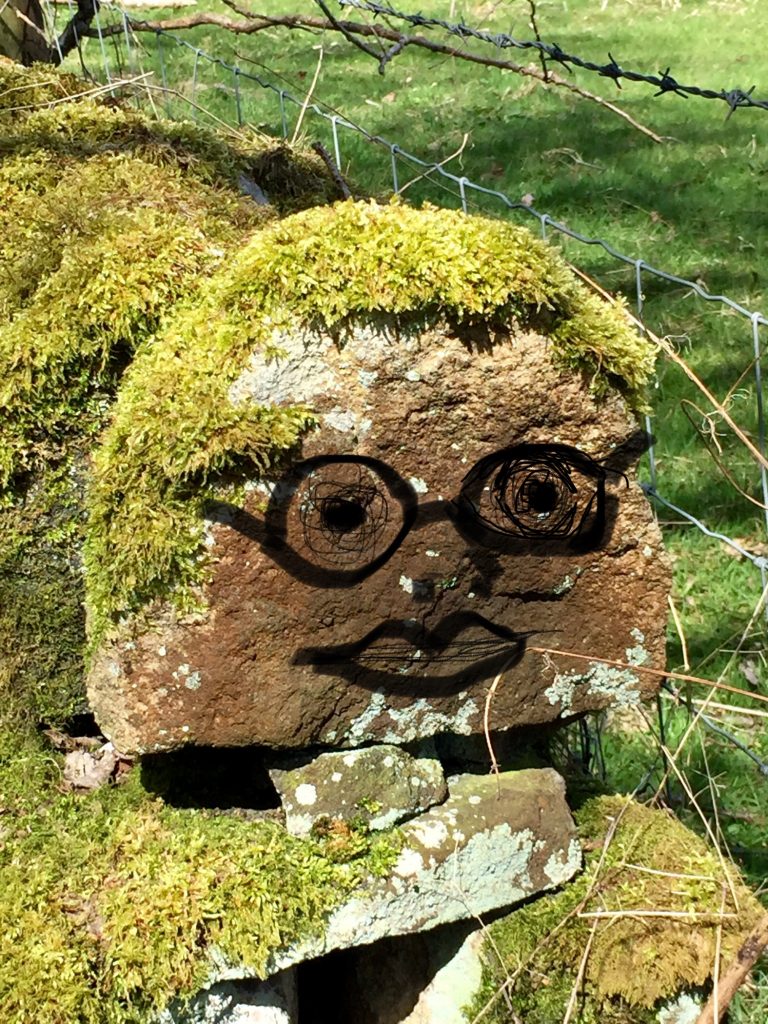
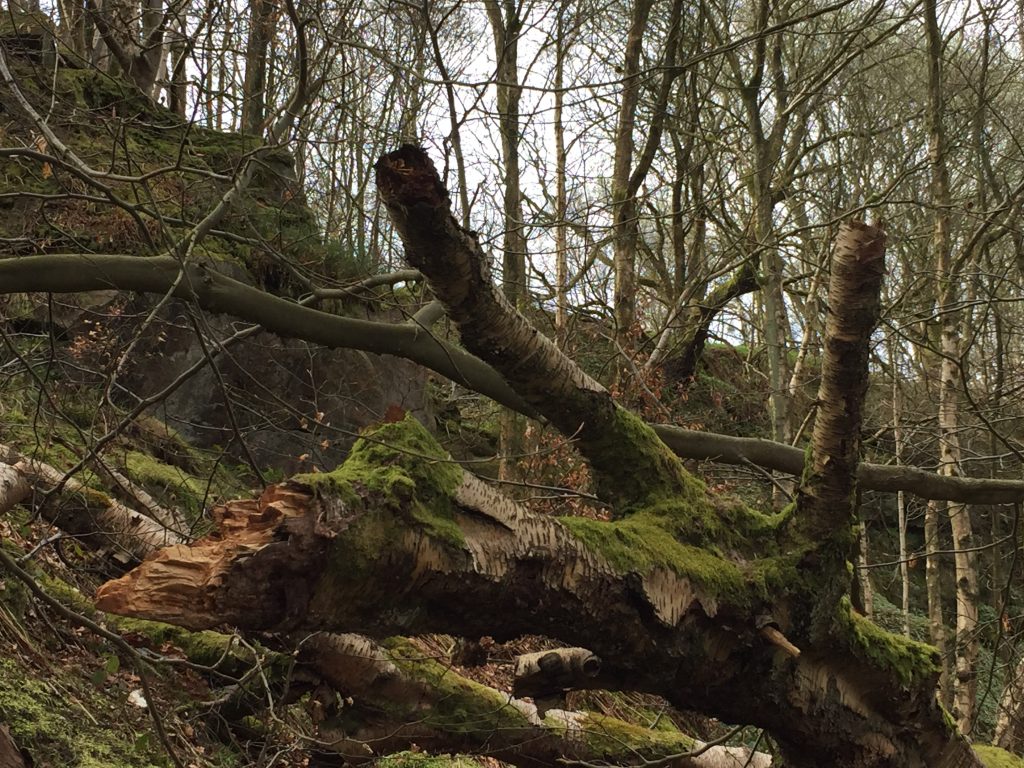
Flying pterodactyl?
After a couple of days just walking along the track and back the same way I venture onto Carr Lane and find Carr Lane farm, obviously a working farm, and to my right a large grand newish house with beautifully laid out garden and conservatory.
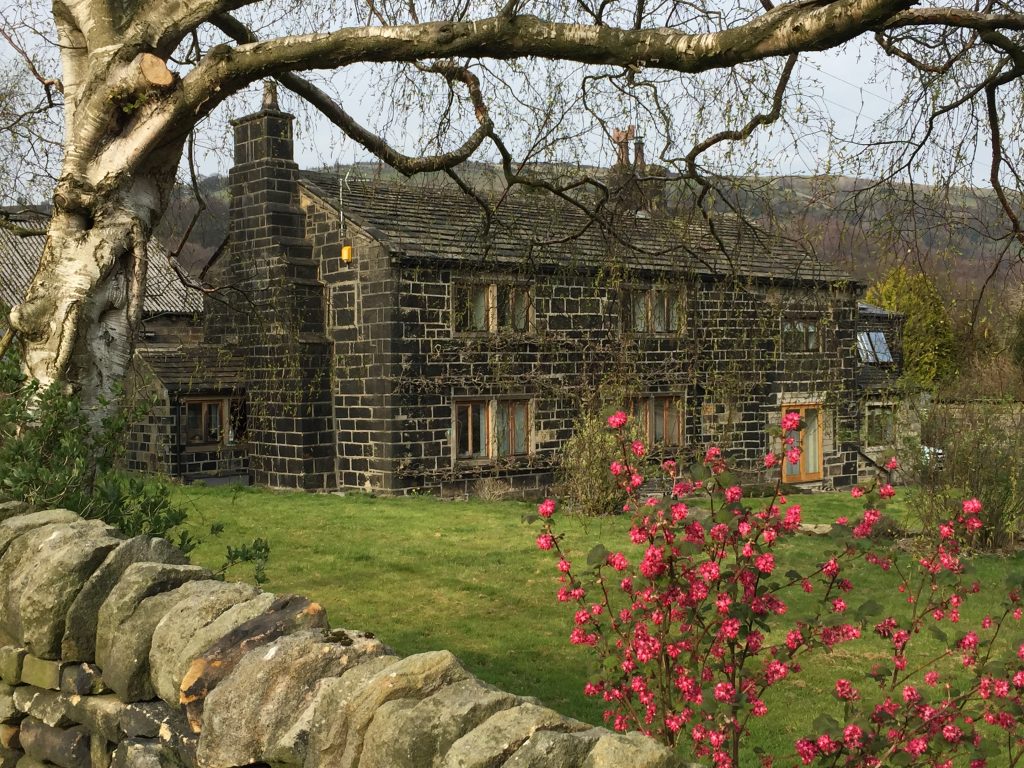
I have a shufti at what lies beyond and find that I’m in open countryside, above the treeline but with another layer of hills above me. I watch a shepherd on the opposite hill gathering his flock with the help of his sheepdog. I can see the brick houses of Mytholmroyd to my left. In the early days in this area all settlements and buildings were situated on the hilltops, where everyone lived, raising sheep and spinning and weaving, taking their woven cloth to the Cloth halls, such as the one in Heptonstall, and the Piece hall in Halifax, via packhorse routes. The only time anyone came into the valley was to cross the rivers, because the Calder Valley was one big marsh, unsavoury and unhealthy. When the industrial revolution was born the mills had to be built in the valleys because all the mills were powered by water. This led to the building of houses for the mill workers being built in the valleys. In the post-war years brick built housing estates were created creating, in many cases a link between the hilltop communities and the valley floor terraces. These brick houses in Mytholmroyd are perfect examples.
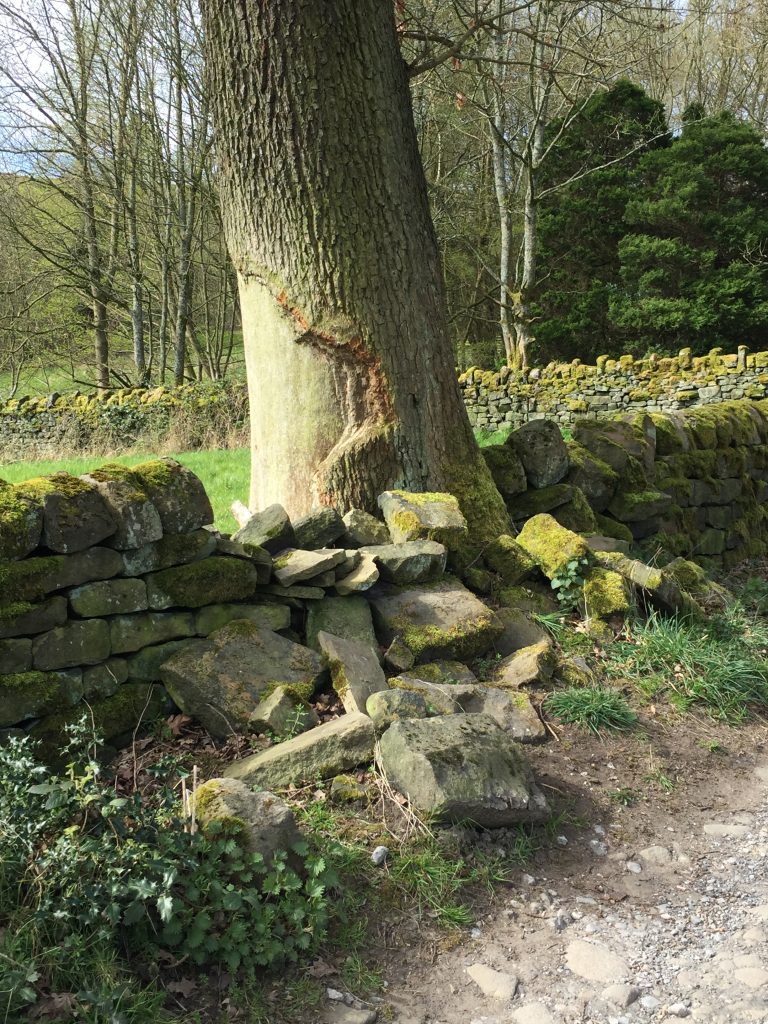
. . .and the tree won. Someone said they can see a man with outstretched arm
The next day I followed the path above Carr Lane farm, a lovely bridleway with extensive views to my left and woodland to my right. A stone wall ran along the edge of the path and had been ‘attacked’ by several of the trees lining the path. The trees always won. In front of me was the tiny hamlet of Wood Top. Now I’d visited Wood Top a couple of times before. The first time I’d got the name mixed up with Wood End. I’d an ancestor who had lived at Wood End but I’d gone to Wood Top by mistake. But, once there one of the current residents had shown me round, pointing out the raised area that had once been the mill pond. Wood Top was an old hand-loom weaving hamlet; by the late nineteenth century, it produced fustian – hard-wearing cotton material. Its inhabitants included the Saltonstall family; John was a fustian dyer, and one of his daughters, Lavena, a fustian clothing machinist, later became the best known of the local suffragettes. The house, built in the mid C17 with an added early C19 cottage and barn now converted to form a dwelling is a Grade 11 listed building.

Today I watched a herd of goats enjoying their breakfast, served in a big basket. The baby kids were clambering up the slope and jumping over the wall, and I realized that their breakfast was being served on top of the former mill pond. From Woodtop there are two choices, one being down the road suitable for cars, and I took that one day, finding myself at the top of the brick walls mentioned earlier, or the footpath that leads behind Fairfield, so I took that another day, leading me past the former Catholic church, now apartments, that my ‘naughty, naughty’ ancestor Willie Wrigley designed. (See Willie Wrigley post). http://blog.hmcreativelady.com/wp-admin/post.php?post=7462&action=edit
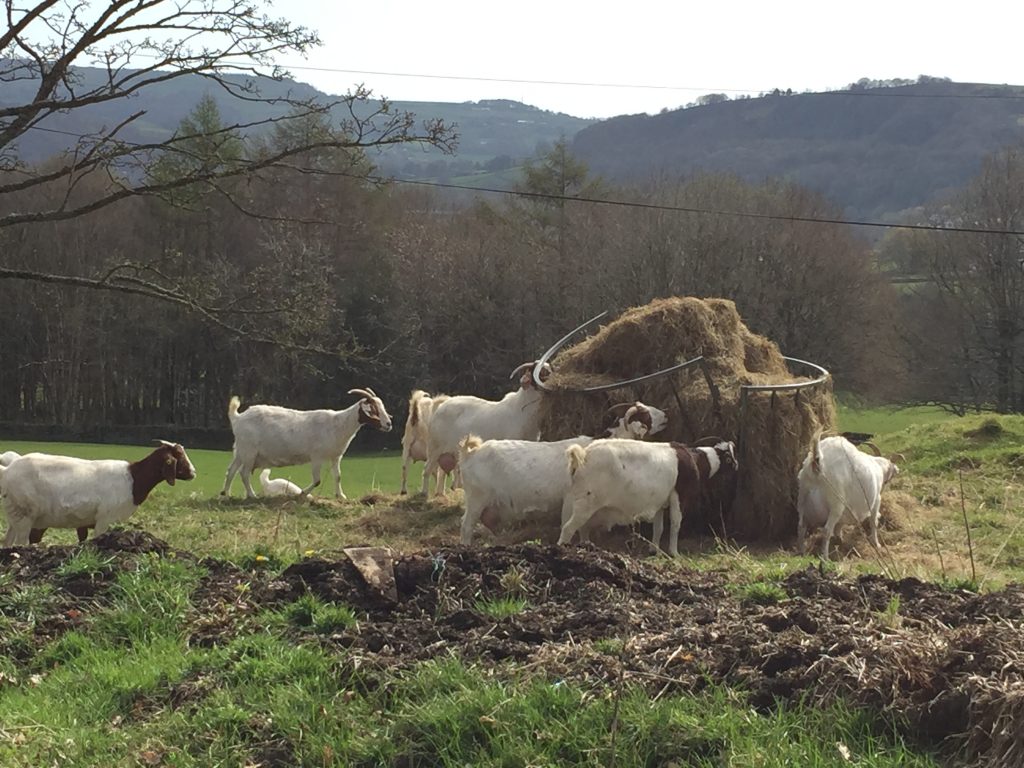
Yesterday, getting to Wood Top was my only intention, but the weather was lovely and I couldn’t resist extending my walk, this time up the second set of hills to Old Chamber. I’d only ever been to this area once before and that was on a hike down from Stoodley Pike in Sept 2018 when I’d stopped at the Honesty Box – a little hut where walkers can stop in, make themselves a drink, buy some homemade cake, and put a coin or two in the honesty box. But the Honesty Box is just past the tiny hamlet of Old Chamber so I hadn’t seen the rest of the settlement. This time I was coming up to it, up a very steep path with beautiful sets. If it hadn’t have been for a couple a long way in front of me who looked a lot older than me I probably wouldn’t have attempted it, but it was too lovely to miss.
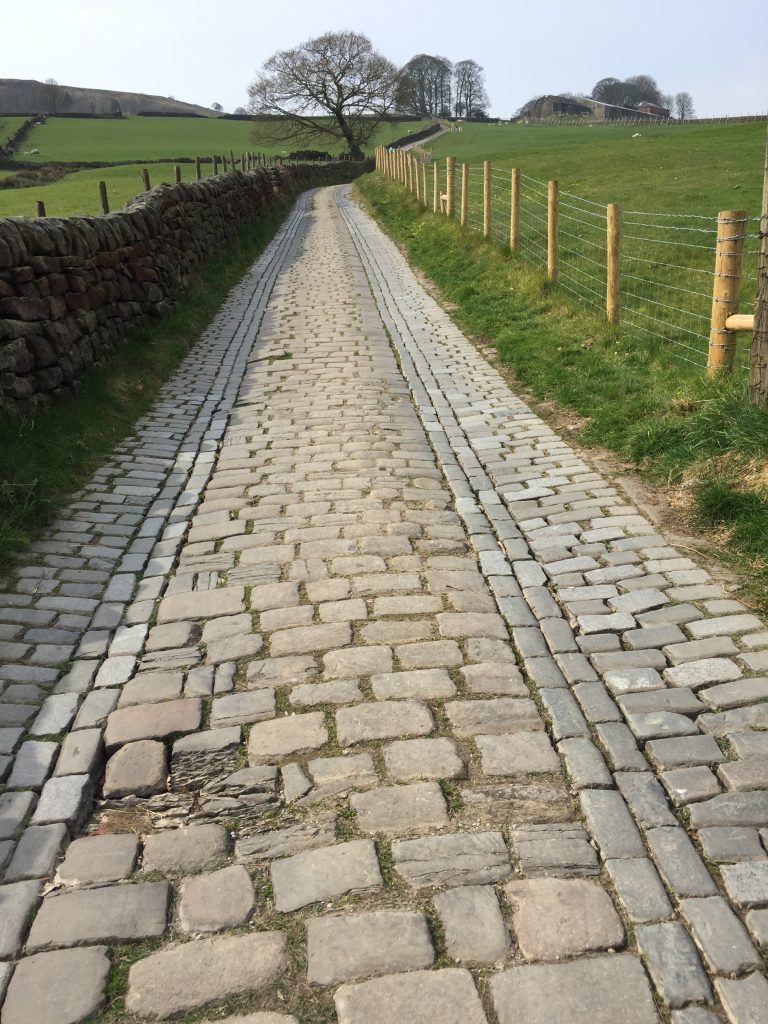
Another couple with two small children were coming down. They had stopped to let the two little girls play in the ‘sand pit’ by the side of the road – which was actually the grit for icy weather. “It’s not as nice as the sand in our sand box at home” the little girl volunteered.
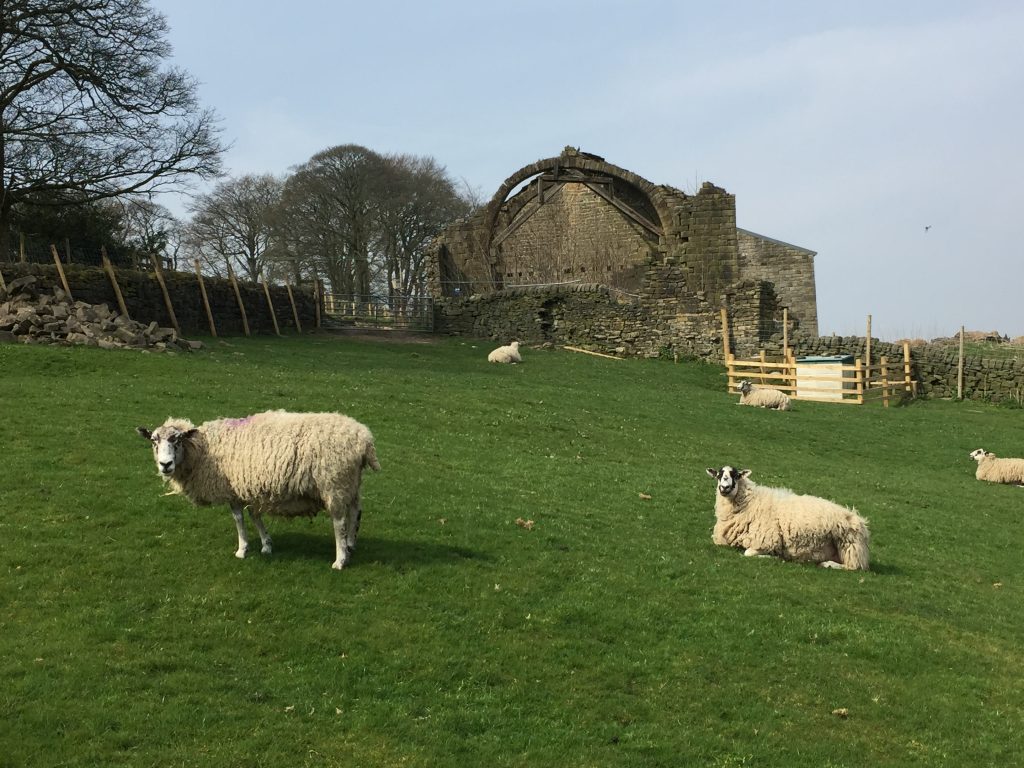
I could see a massive rounded arch atop a derelict barn at the top of the hill and, with my love of all things ruined, I increased my pace. Though the barn was surrounded by a wire fence I could see the old fireplaces, reminding me of the barn in our field at Affetside where I grew up. Perhaps that’s why I have a ‘thing’ about old buildings.
This got me thinking of a very early memory I have of my dad and some other guy removing the roof from our ruined barn one very hot day and my dad getting terribly burned by the sun. They were taking the roof off so that it wouldn’t collapse on me when I played in there. It had a huge stone fireplace too – and a date stone of 1842 (?) . At Old Chamber there were huge rotted wooden sliding doors into another barn, this time a brick one, and from the sound of it there was possibly some lambing in progress. Across from the barn a dead baby lamb was lying on the grass. I passed a water trough covered in moss where the only colour was a couple of plant pots hanging on the side, bursting with colour.
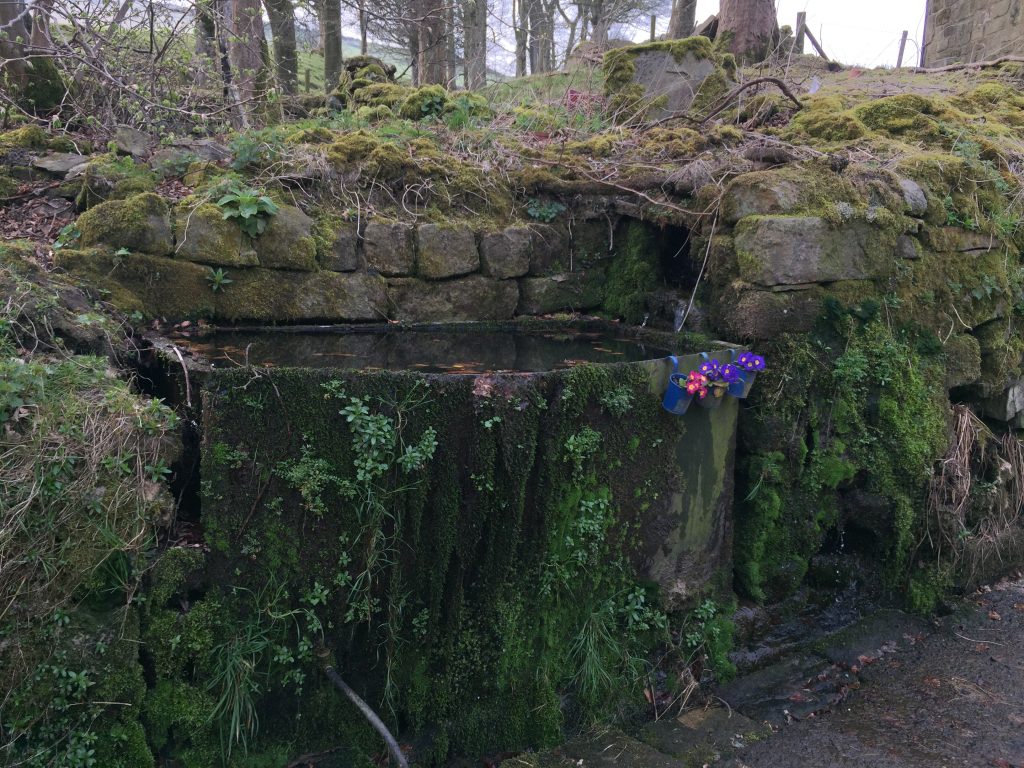
Delightful. I saw several signs advertising Bed and Breakfast and a couple were sitting in the garden drinking an afternoon glass of wine overlooking what must be one of the best views in the valley. Old Chamber is on a level with Heptonstall, which you can see across the Calder Valley. I must find out more about this settlement – and how it got its name. I came to ‘The Lodge’ and as I was taking a photo of the date stone above the porch, 1642, a man approached me from the next cottage where he’d been sitting on a bench. “If yer think that’s impressive, wait til I show you t’ door.” And he came around the pulled the door to. “But that’s not old,” I said, gazing at what looked to me a new very solid looking carved door. “Cost three thousand pounds did that door,’” he said. “It’s brand new.” “They wanted to put new winders int’ back, an awl, but they weren’t allowed t’put 9 glasses in. ‘T council towd ‘en they couldn’t. ‘ad t’ be 4 an’ 4.” I did wonder how they’d got planning permission to renovate ‘the lodge’ with the new stones.
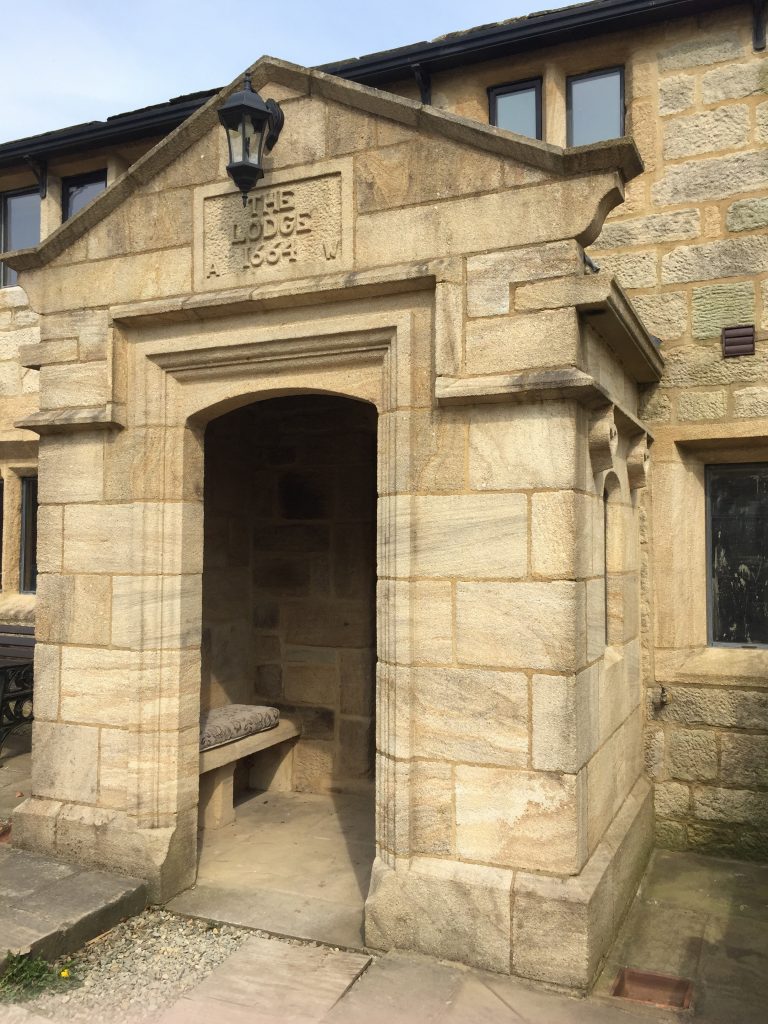
I continued on my way, taking ‘New Road’ according to my map. This proved to be a cart track, with the cobbles mostly worn away and it was slippery with loose stones but I took my time.
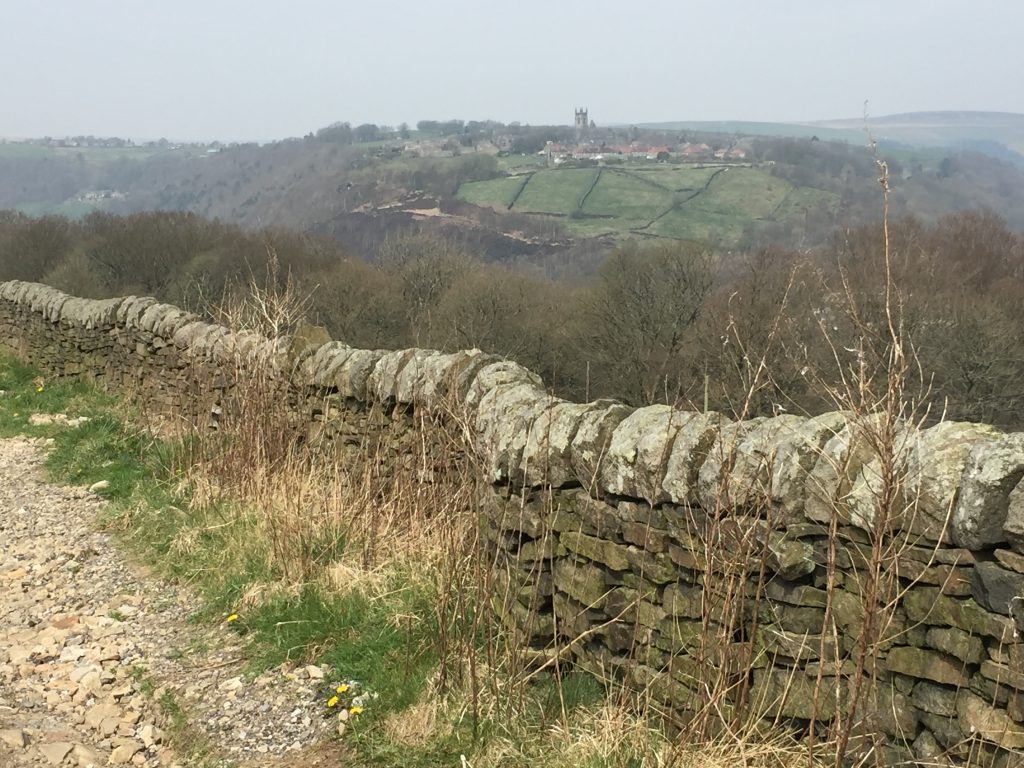
I was shown the way by two butterflies who kept fluttering in front of me and landing on dandelions. The previous night I’d attended a Camera club online lecture about Macrophotography by Tony North. His close ups of insects were amazing and he described how he would get down on his stomach so as not to frighten the butterflies. So I gave it a go!
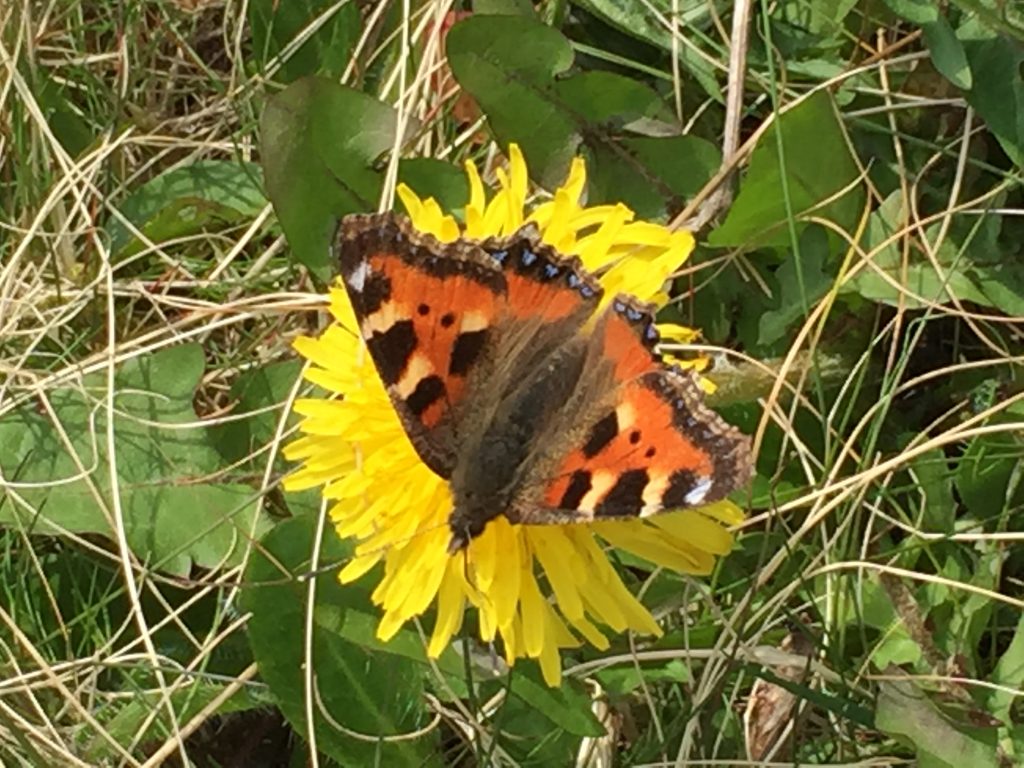
When I came to the mast of the TV transmitter I realized that I was now directly opposite my apartment. For a few weeks I’d been wondering if there was access to the top of the hill directly in front of my living room window and now here I was – without trying! I followed the steep road down and suddenly found myself at Weasel Hall where, in December 2017 I’d gone to explore since one of my ancestors had lived there: http://blog.hmcreativelady.com/?s=weasel
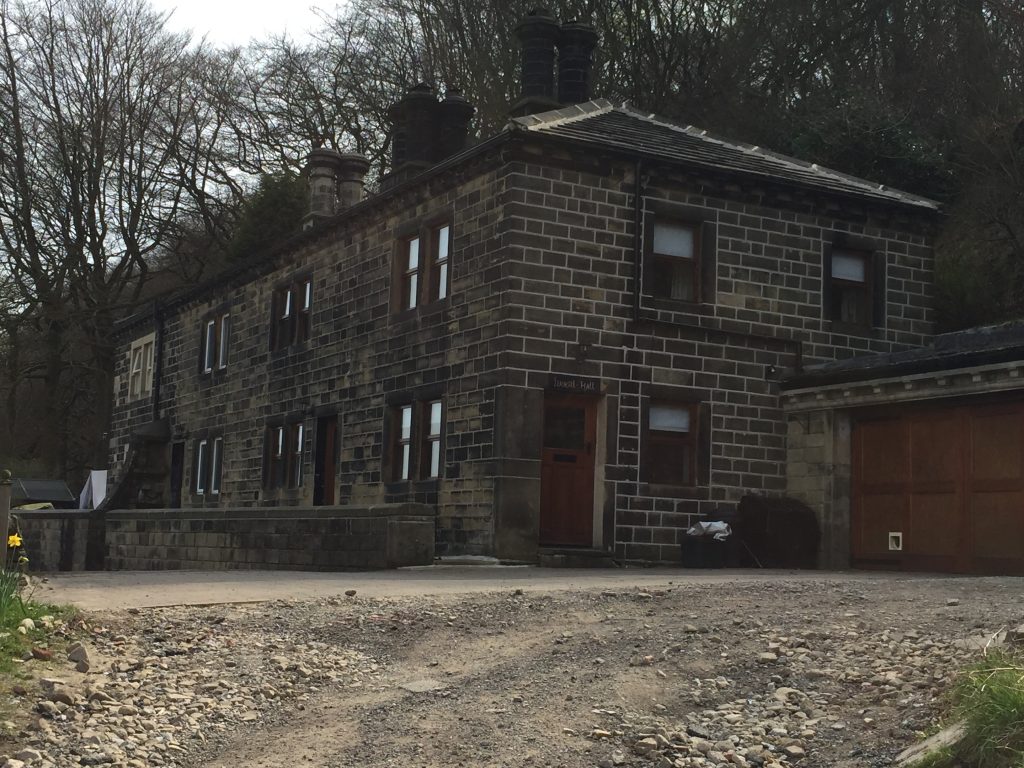
I reached the canal, crossed the river by a rarely used bridge and found myself an Easter bonnet. What do you think?
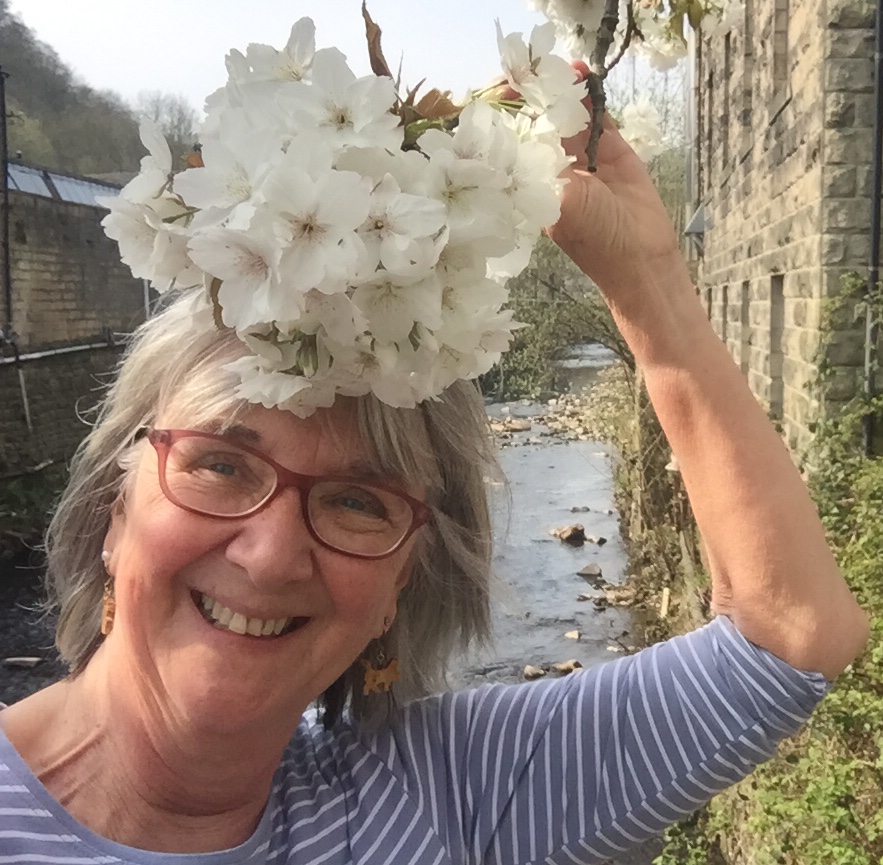
HAPPY EASTER
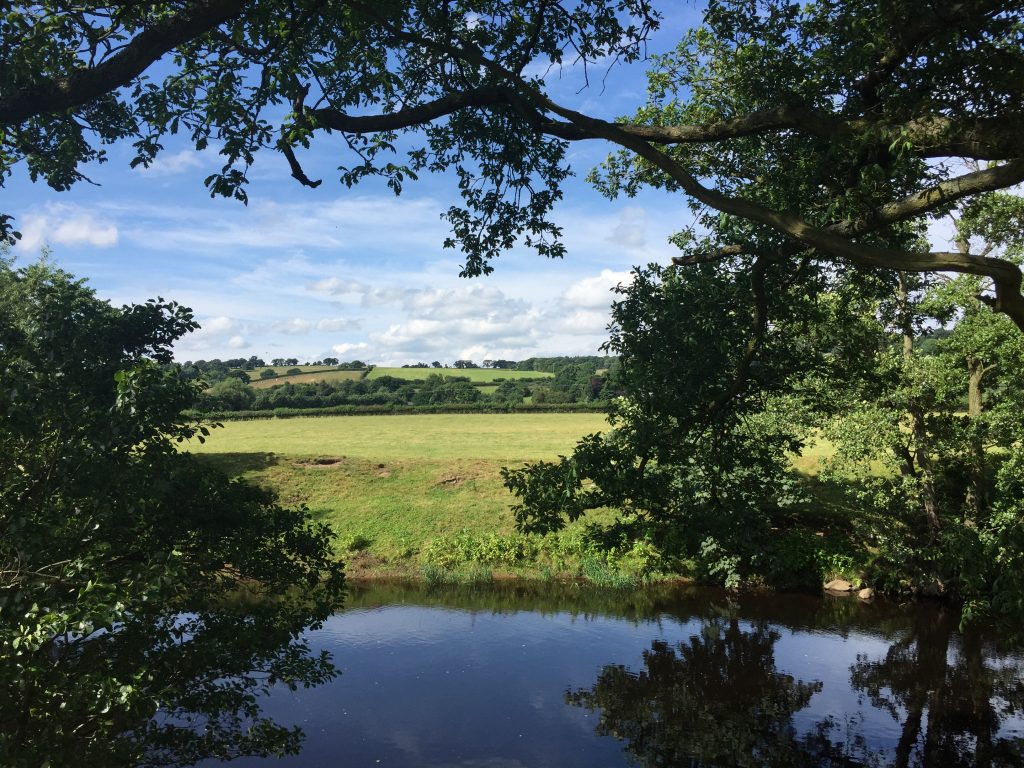
As part of the growing number of theatre productions and music performances being broadcast online during the country’s lockdown I was looking forward to seeing National Theatre Live’s production of Jane Eyre. Now Haworth, where Charlotte wrote the book is only a hop, skip and a big jump from my home in Hebden Bridge. In fact I’ve actually hiked across the wild moors from the parsonage at Haworth where the Brontee family lived back to my home in Hebden Bridge. So it wasn’t surprising that seeing the show got me thinking about my personal connections with Charlotte and Jane Eyre.
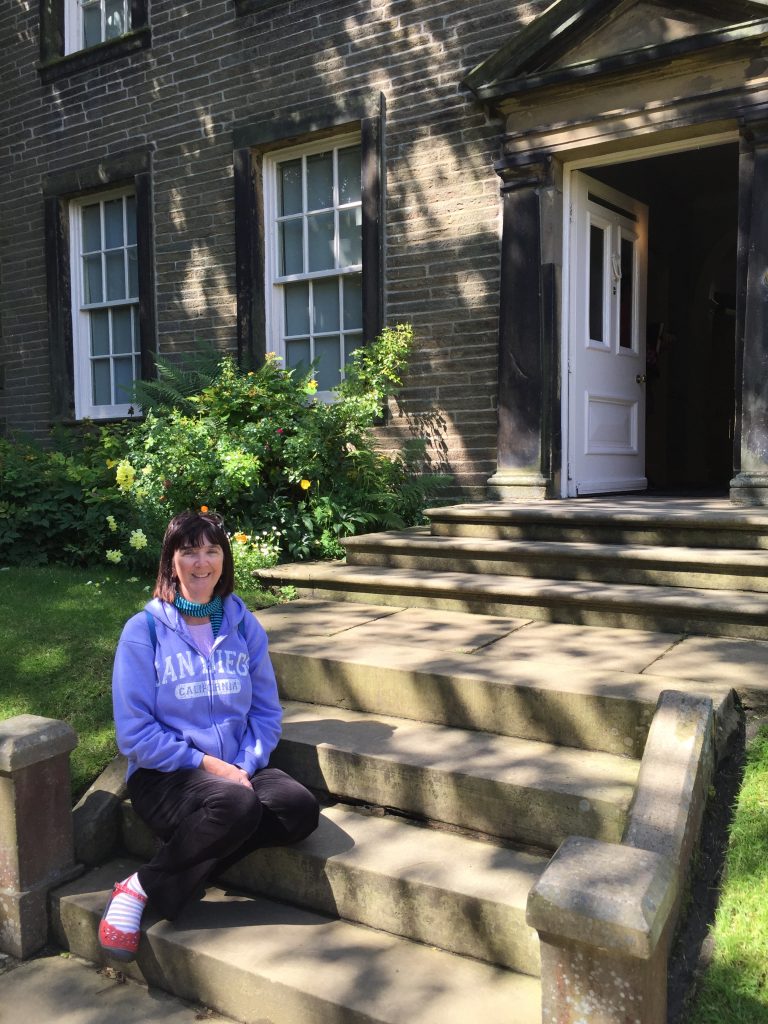
I first managed to find an account in which I came face to face with Mr Brocklehurst! This is from my dairy of 2012. I’d being working on my own research project to discover the first piano that came to California and this had led me to the home of Mr Scott, after whom Scott’s valley is named.
I made an appointment to see the Scott House in Scott’s Valley, just outside Santa Cruz, California. I called by phone one Saturday evening, around 10 p.m. expecting to get an answering machine. Instead my call was answered directly by Virginia Hooper who told me I could have a private viewing the following morning at 10.30.
I’d never been to that part of the town, even though I’d had students along Civic Drive. The old building looked inviting and Virginia had left the door open for me. It turns out that Mr Scott had spent very little time in the house. it’s furnished with an eclectic mix of furniture and photographs donated by people in the town, including Virginia herself. She took me upstairs (not on the official tour) where there were remnants of Santa’s Village.
I noticed a book ‘Scotts Valley: As it was and as it would become’ by Donald E. Seapy which looked like a useful resource. There was a photo of a waterwheel on Laurel Hill at the Babbling Brook B & B and Virginia told me that this has been mentioned as the original wheel from Joseph Majors mill on Escalona. However, when I called the B & B later they told me that the wheel dates from the 1920’s when the establishment was a tannery.
However, the most unexpected outcome of the day was the fact that Virginia’s husband is a direct descendent of William Carus Wilson, proprietor and headmaster at the school the Brontees attended and who became the prototype for Mr Brocklehurst in Jane Eyre. Virginia and her husband have visited that area, staying in Casterton Hall. She invited me to visit her at home sometime and see her Brontee memorabilia which I did. My calendar records the date of my visit, Nov 16, 2012 but I have no photos of that visit.

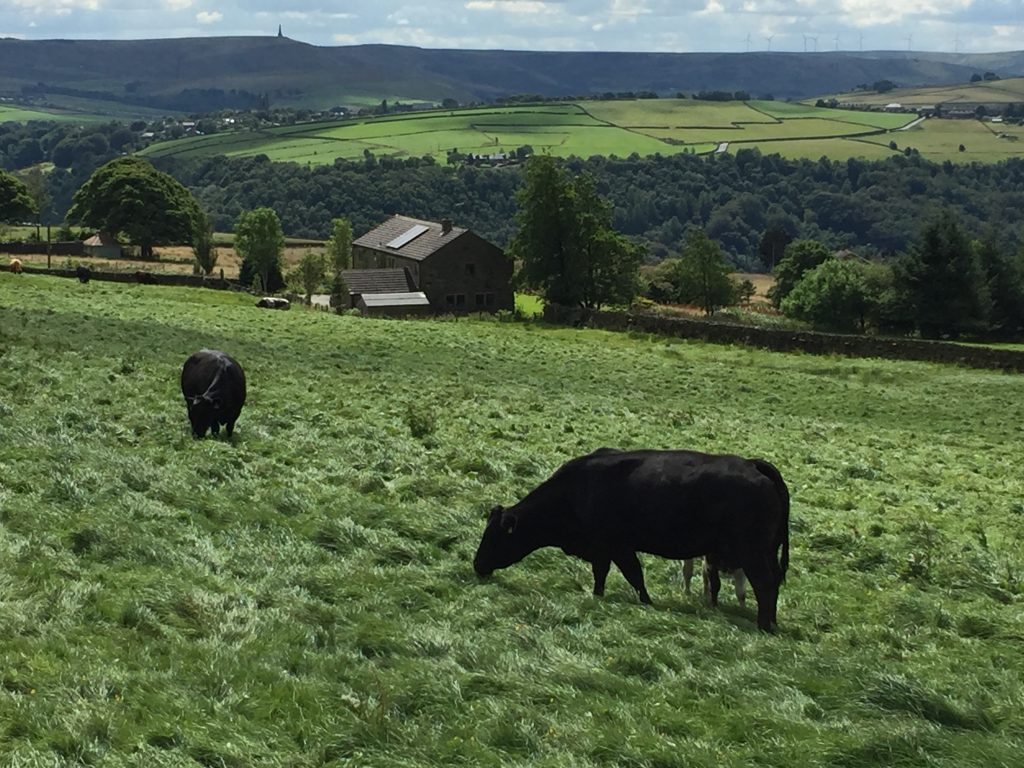
My second connection was on a trip to Birstwith near Harrogate in 2016 when I was visiting England for the summer. Here’s my journal entry:
In The Footsteps of Charlotte Brontë July 20, 2016
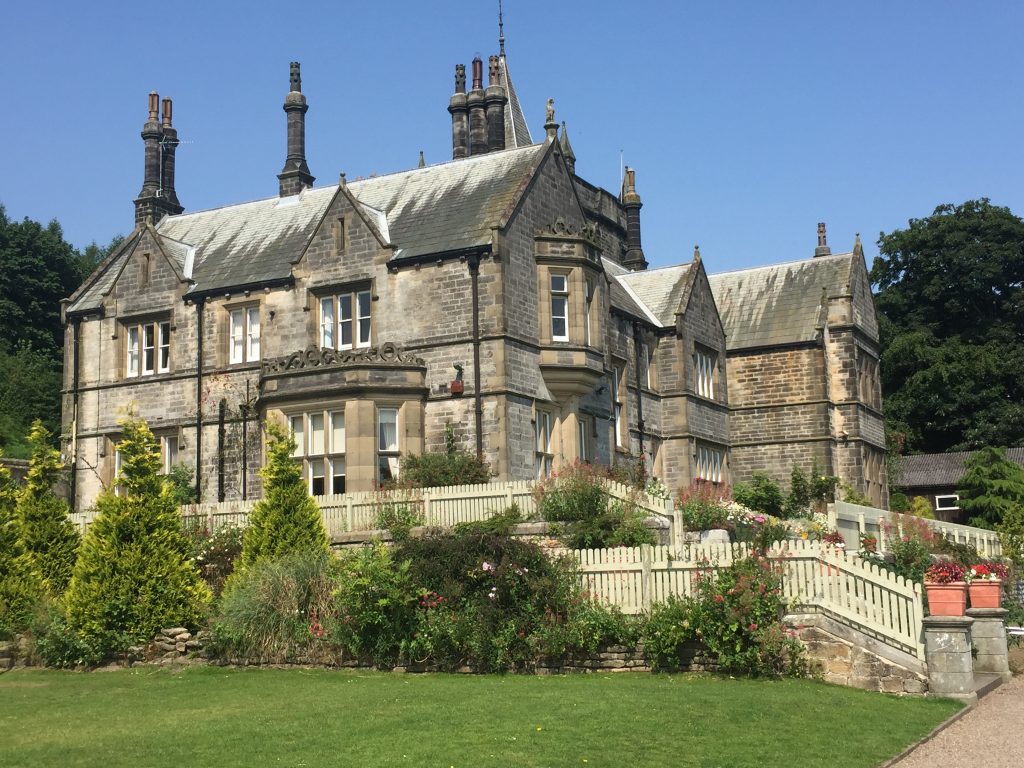
Swarcliffe 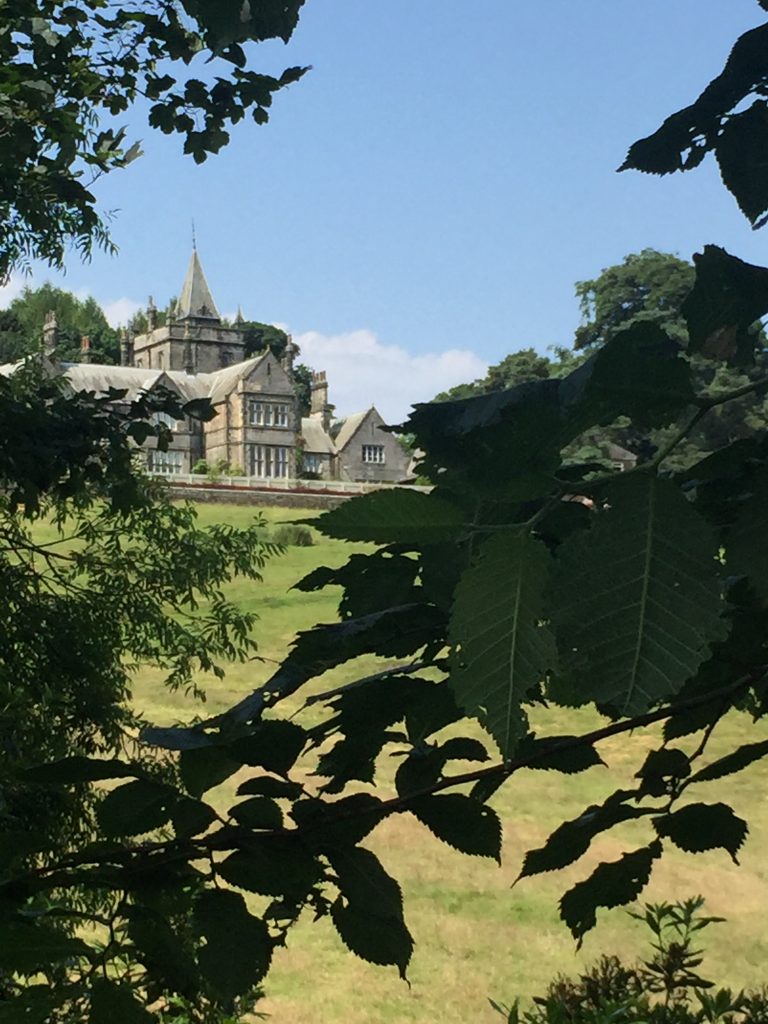
Last year when I stayed with a friend in the tiny estate village of Birstwith I had commented on the large mansion on the hill above the village. Originally the entire village belonged to the Greenwood family and all the buildings were constructed for the people who worked at Greenwood’s cotton mill. Their family home, Swarcliffe, had turrets and towers and looked very imposing. She told me that it once belonged to the mill owner but was now a private school. It was only when I got back home and read about it that I discovered that Charlotte Brontë had resided in this house for the summer of 1839 when the Sedgwick family for whom she was a governess to their two small children moved here for the summer. The home belonged to Mrs Sedgwick’s parents. So on my visit this year I wanted to see if I could get a closer look at the building. As luck would have it my friend knows someone who works there and so we arranged to meet. She provided me with a copy of a letter that Charlotte wrote to her friend Ellen Nussey, describing how dreadfully unhappy she was at Swarcliffe. Charlotte just wasn’t a ‘people person’ and what with the entertaining of guests and the care of the youngsters (she was not fond of children either) she felt very lonely. “As it is I can only ask you to imagine the miseries of a reserved wretch like me thrown at once into the midst of a large family – proud as peacocks and wealthy as Jews – at a time when they were particularly gay, when the house was full of company – all strange people whose faces I had never seen before – in this state of things having the charge given me of a set of pampered, spoiled and turbulent children, whom I expected constantly to amuse as well as instruct.”
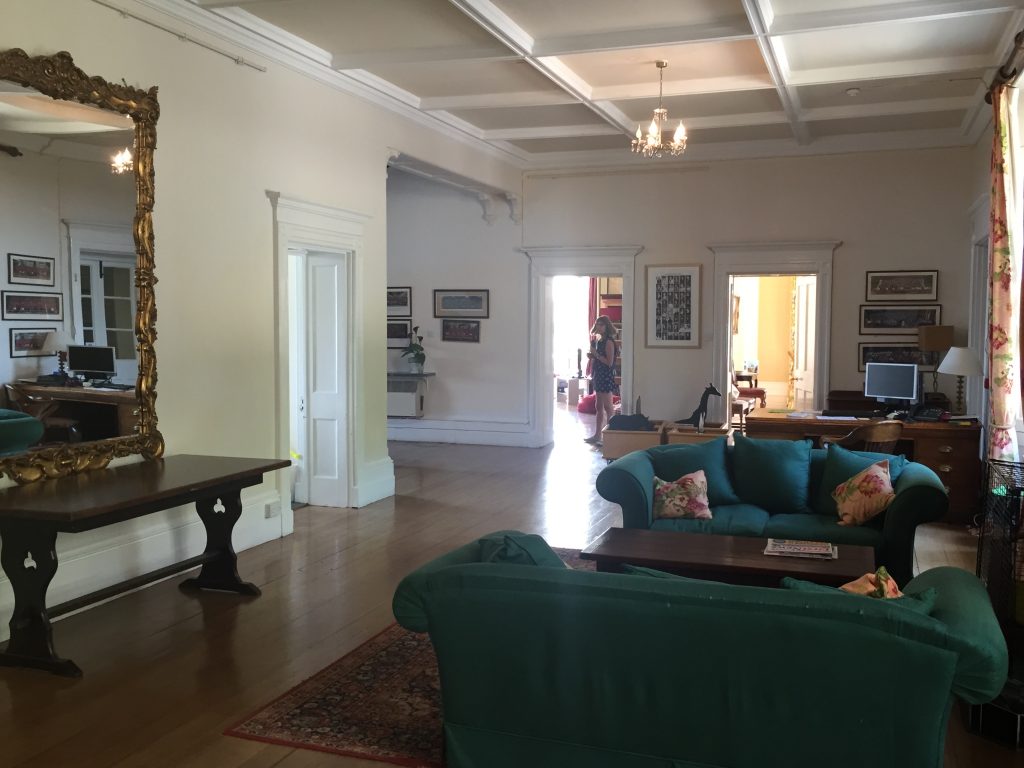
Inside the school today 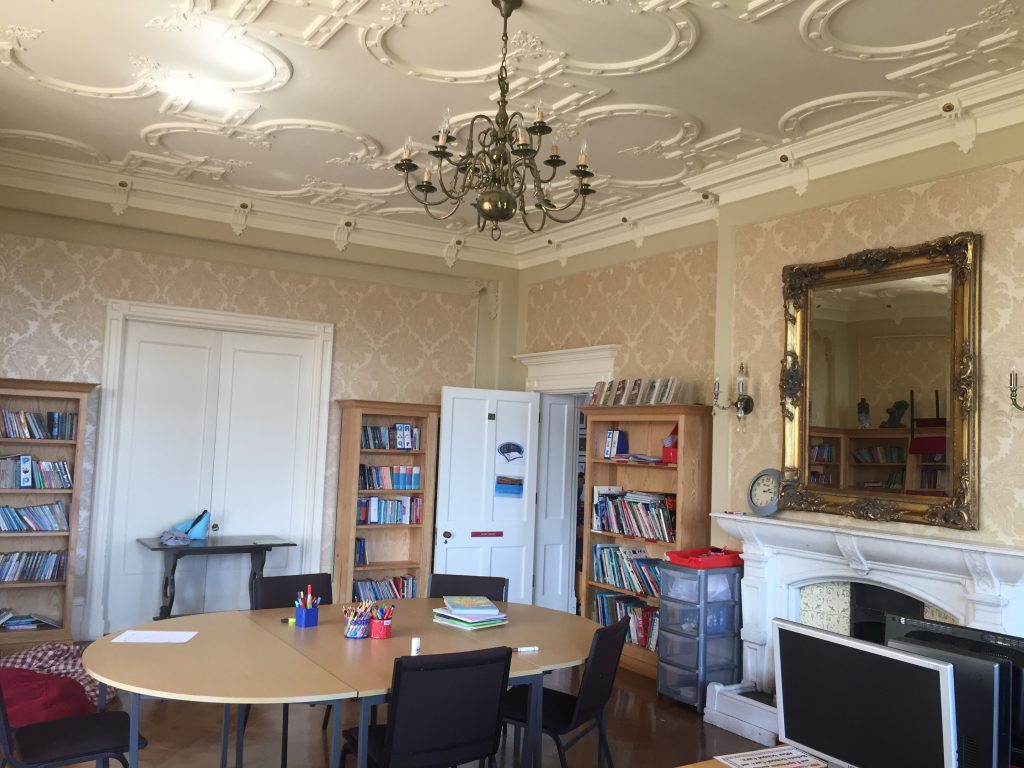
It was a steep climb up to the school, passing the church. Once a boys’ boarding school it is now an expensive day school for children from nursery school age to eleven years old. Fees are £10,000 per year. Little of the original building that Charlotte would have known remains. In fact, probably only the stable block (which is now a classroom) remains, which may account for Swarcliffe having no’ blue plaque,’ but for me to simply take in the views that she would have looked out on was simply magical. Again it was a very warm day – 80F – and the scenery and extensive grounds looked idyllic, but in poor weather (i.e most of the time!) chaperoning the students from one building to another between classes is an arduous duty for the staff. I glimpsed a noticeboard with the names and successes of about twenty students who had recently taken their ABRSM music exams. I think I could teach here! I suspect that most of the students go on to ritzy boarding schools and there were some fliers on hand for places like Sedbergh and Uppingham, though some transfer to local schools too.
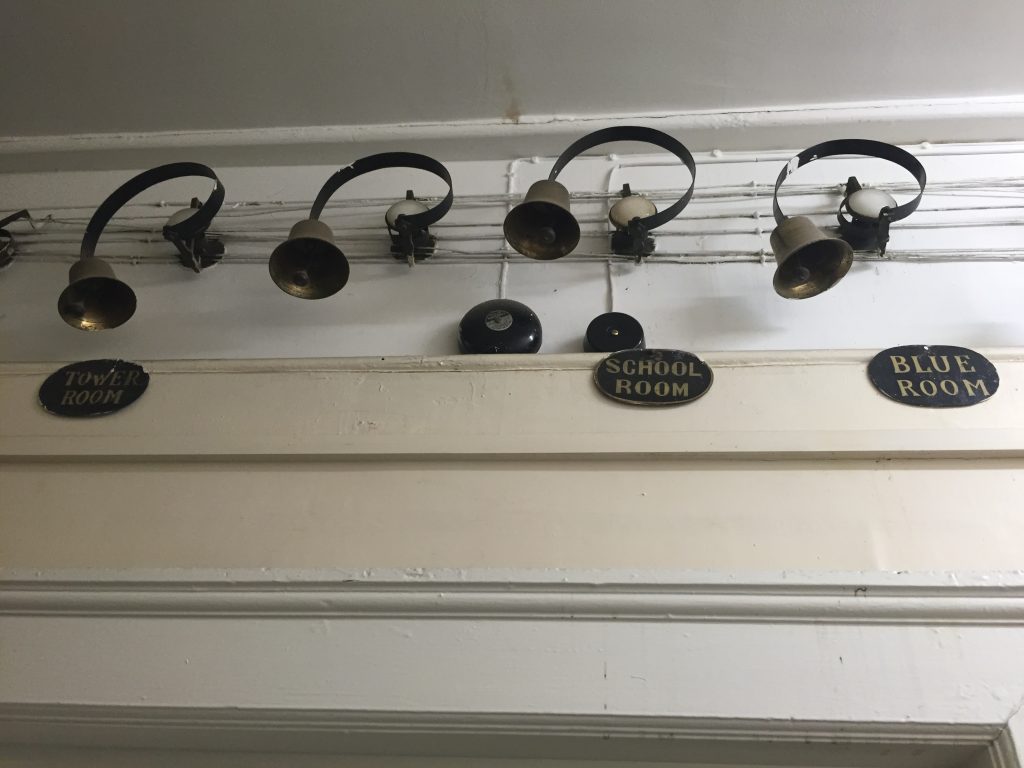
The interior retains its stately home appearance, though the children won’t see how unusual a school it is until they leave. The ornate ceiling and large mirror in particular caught my eye, as well as the amazing views, sometimes as far as Middlesbrough, 70 miles away, on a very clear day. The maid’s bells were mounted in a corridor. One was labeled the ‘school room,’ a place which Charlotte must have been rather too familiar.
In the afternoon we took a stroll along the river Nidd passing Mr Greenwood’s old mill, now a fertilizer factory, which make a very intrusive noise, and then we drove about five minutes to Cold Cotes, the Bed and Breakfast. The extensive gardens were open to the public as part of a fund-raiser for the Royal Gardens. I met the owners, who moved there quite recently. The property was listed for £1million. There are eight rooms for BnB, beautifully landscaped gardens and lovely spacious views in all directions. What a difference from Hebden Bridge where the population is all squished together on the steep hillsides. Here we were greeted a lady from the Royal Gardens with a plum in her mouth. Visitors were showing up in their BMWs and Mercedes convertibles. I sipped a glass of wine and took in the scene.
For our evening’s entertainment we watched Brassed Off, one of my family’s favourite movies, and I was surprised to see places that I now recognize – the Piece Hall in Halifax, and I’m sure I caught a glimpse of Stoodley pike in the distance. 7 miles today.
Little did I suspect then I’d within 2 years I’d be living in Hebden Bridge, within walking distance of both Stoodley Pike and Haworth.
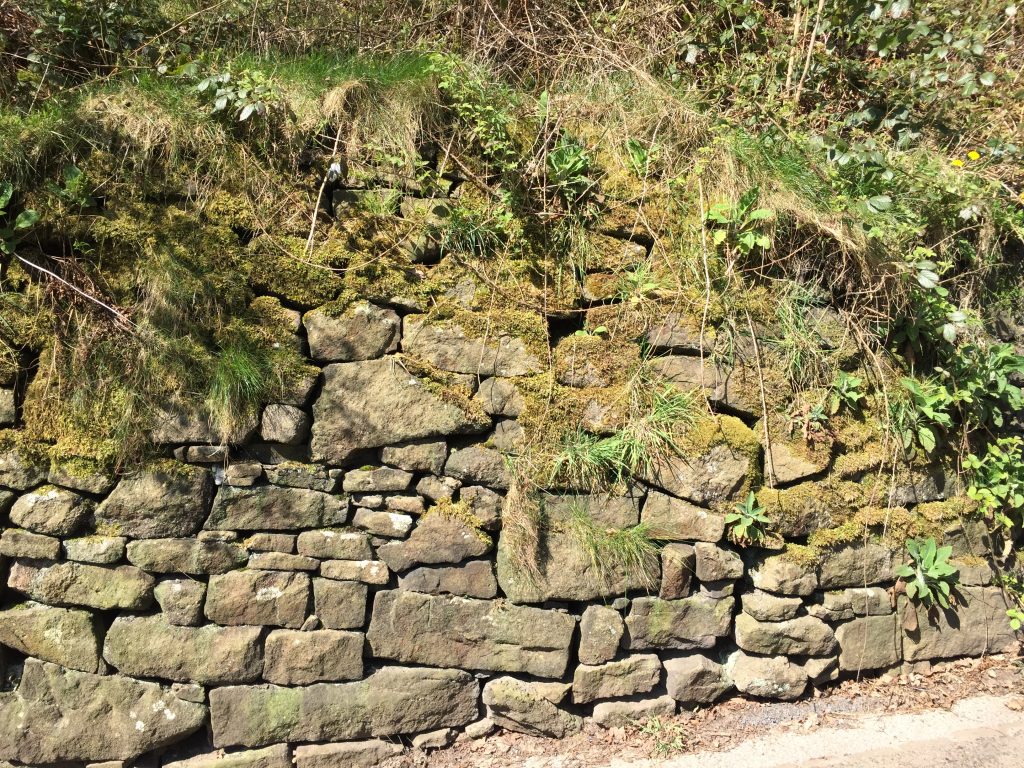
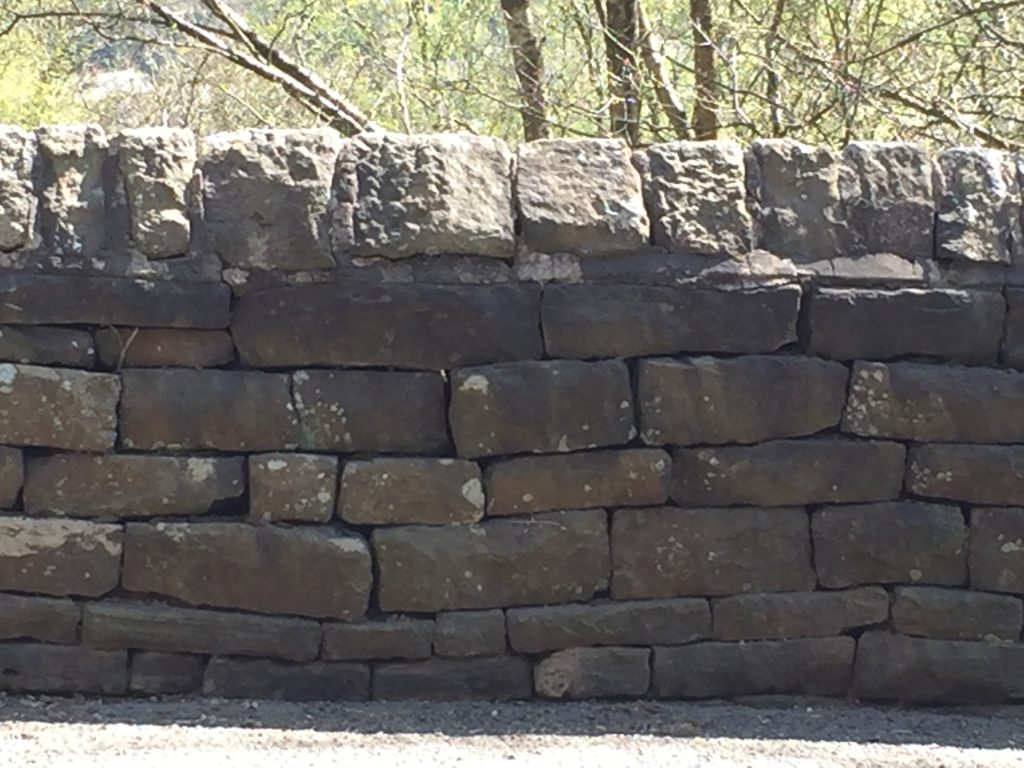
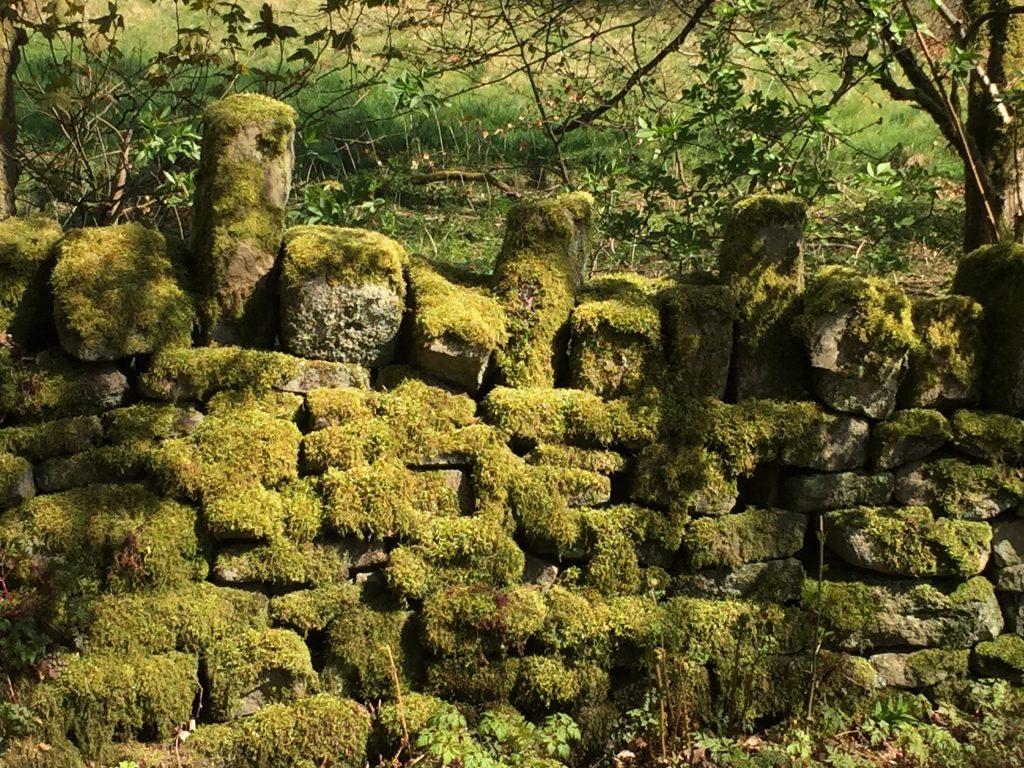
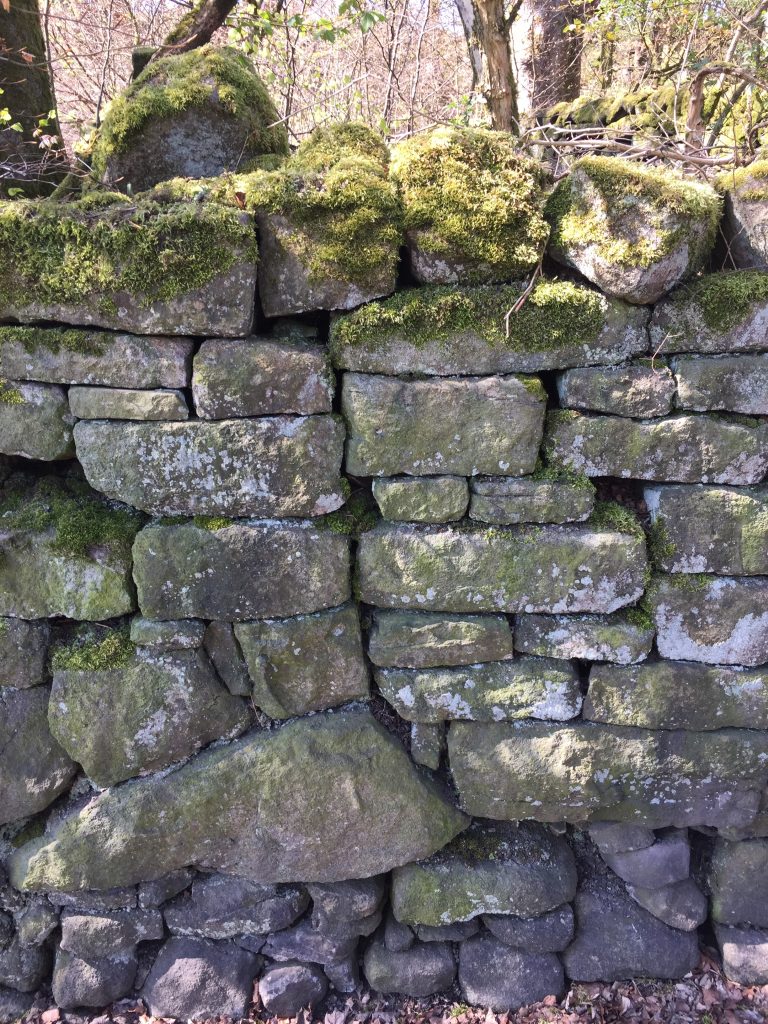
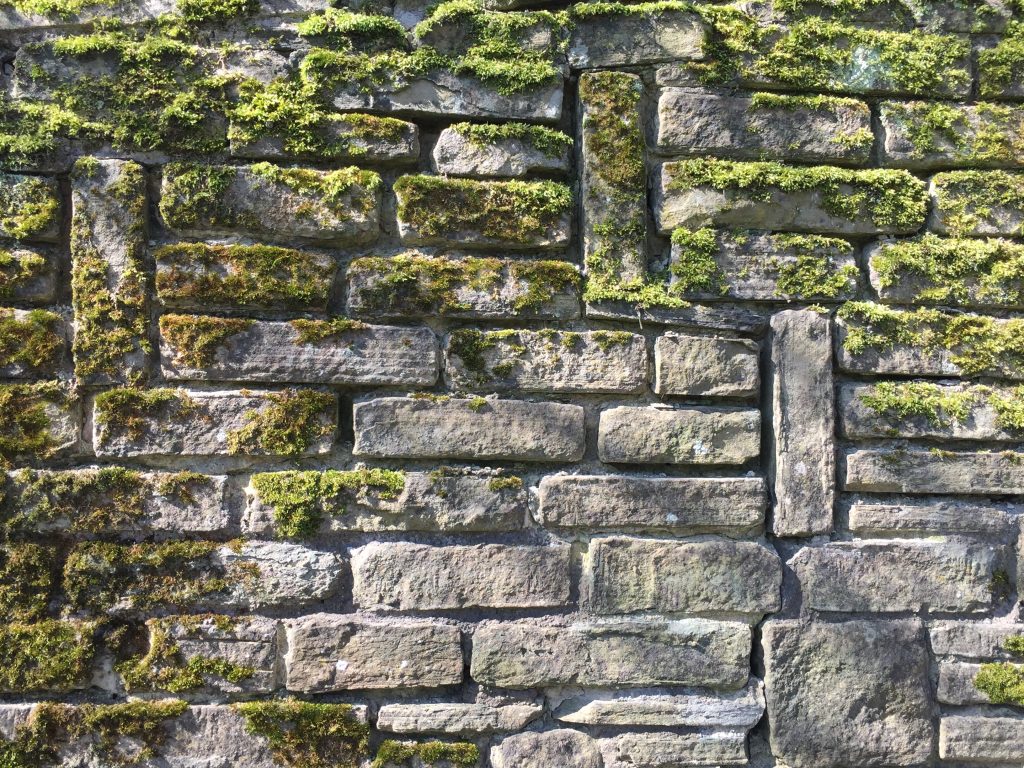
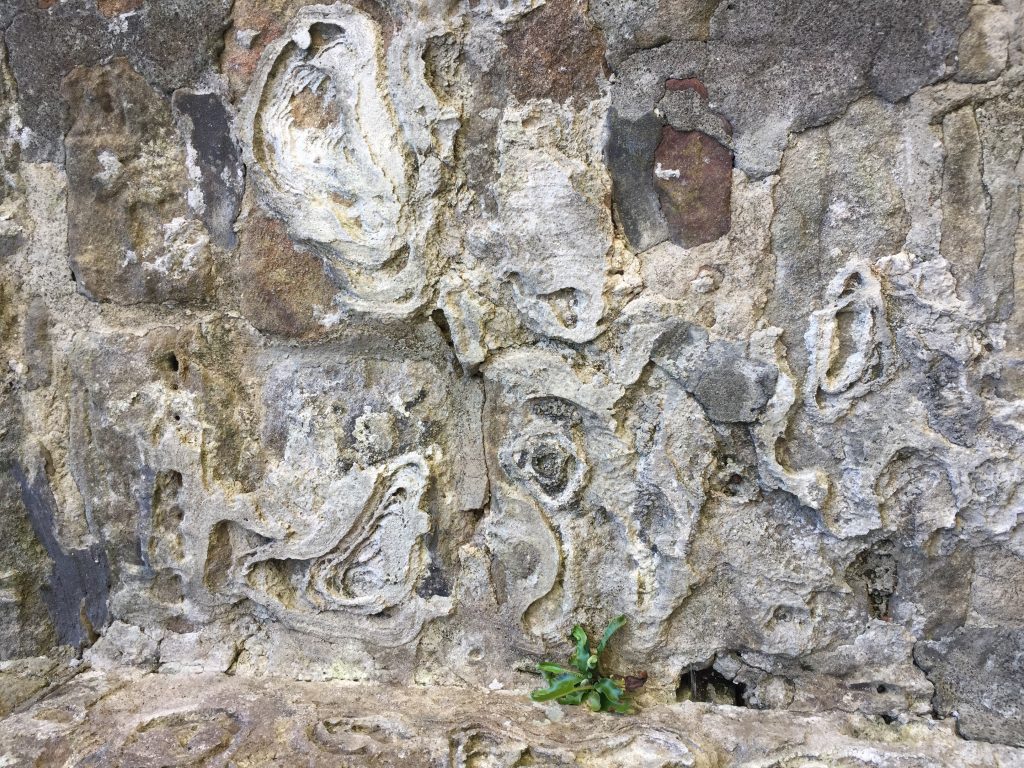
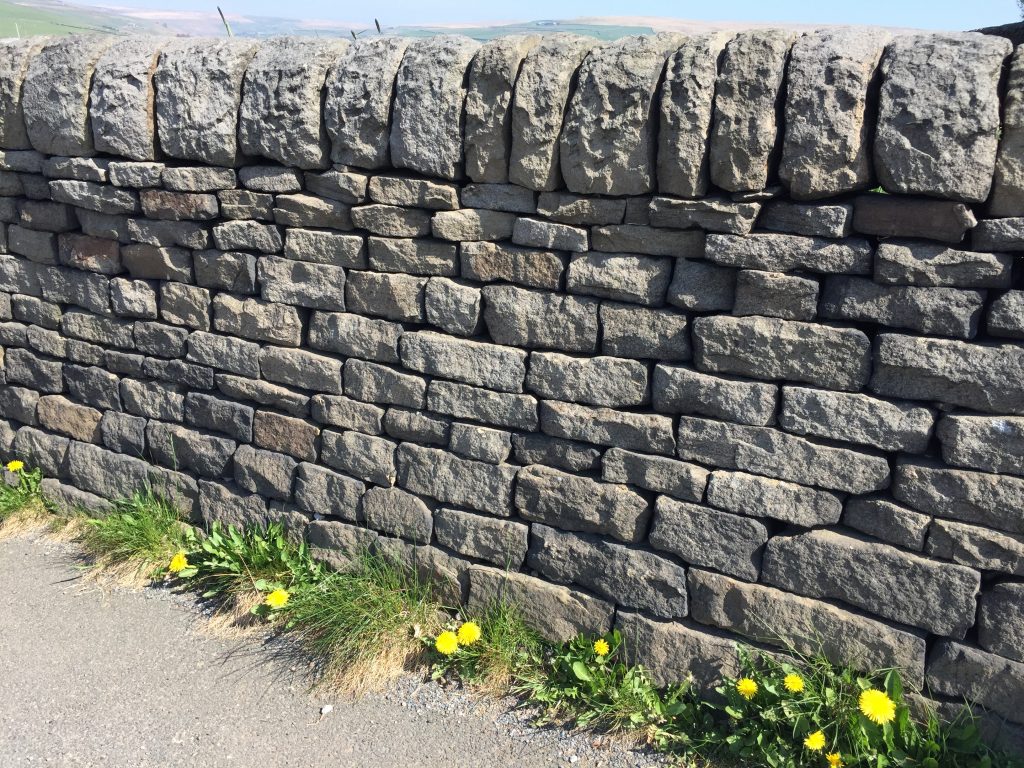
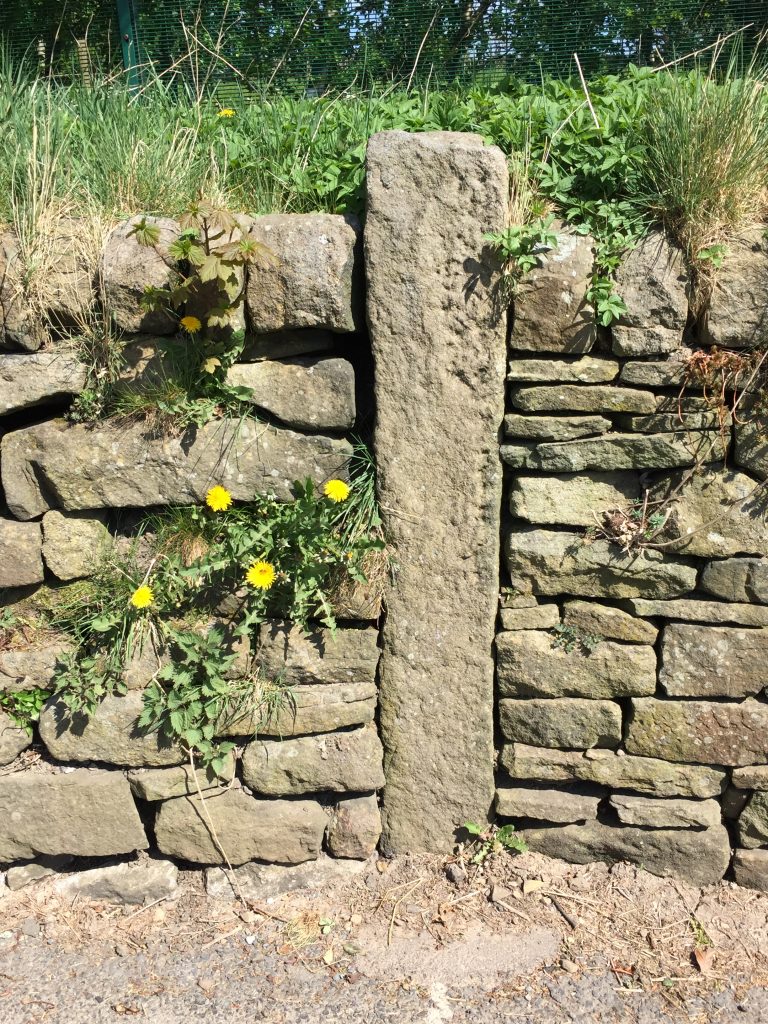
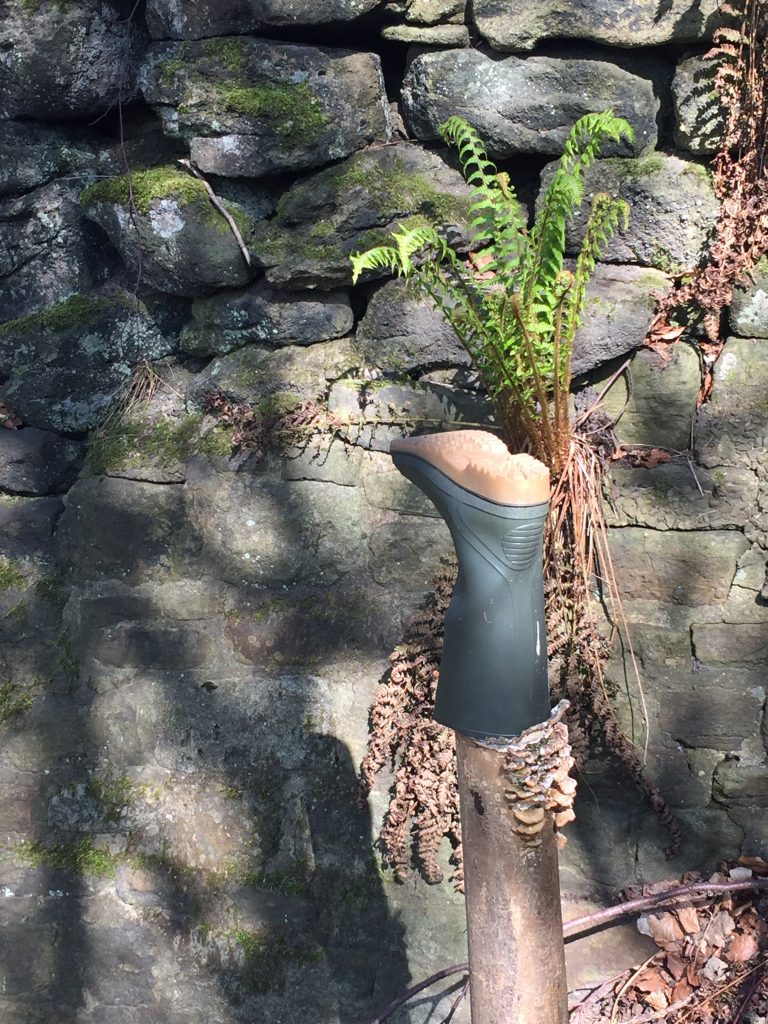
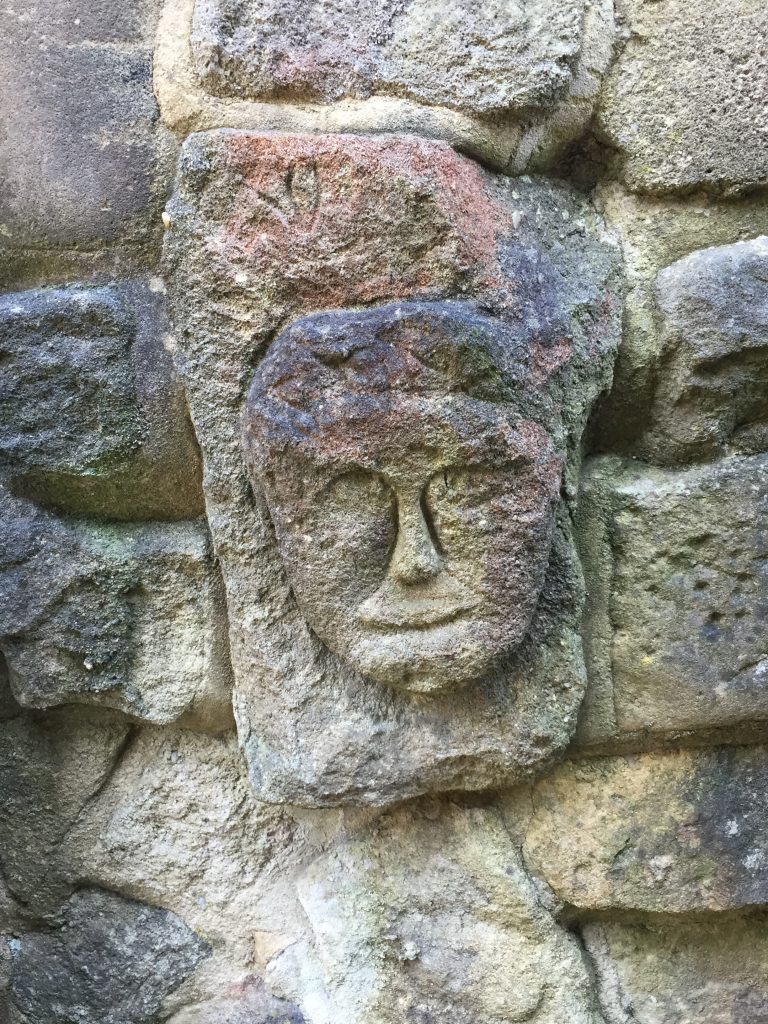

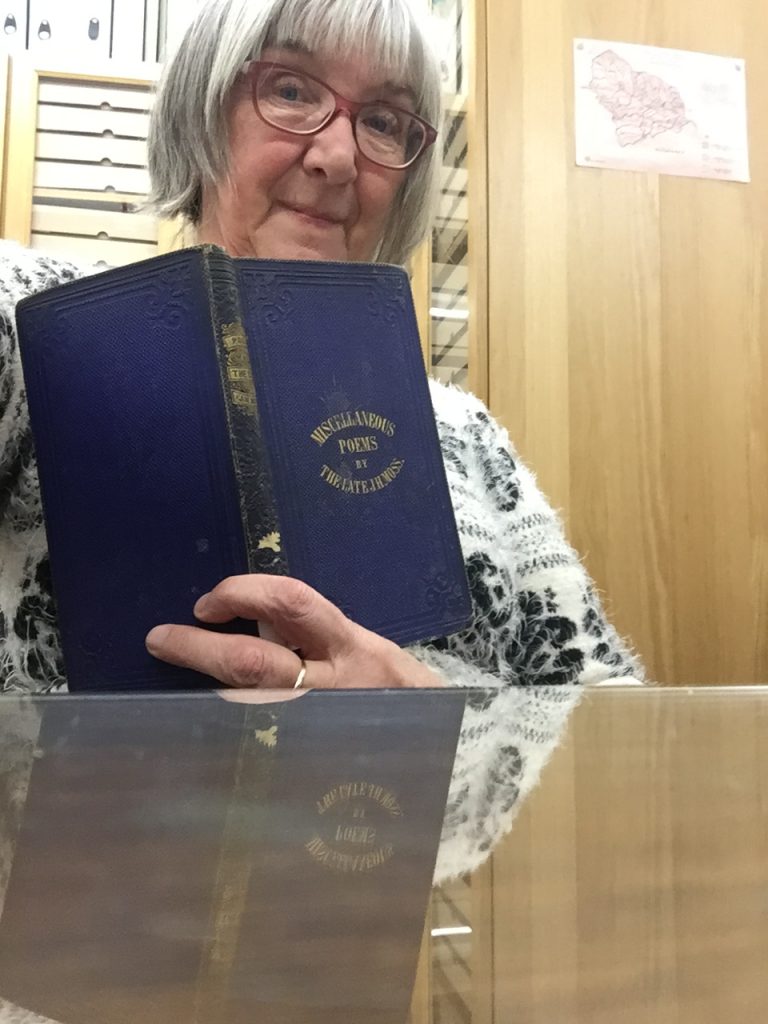
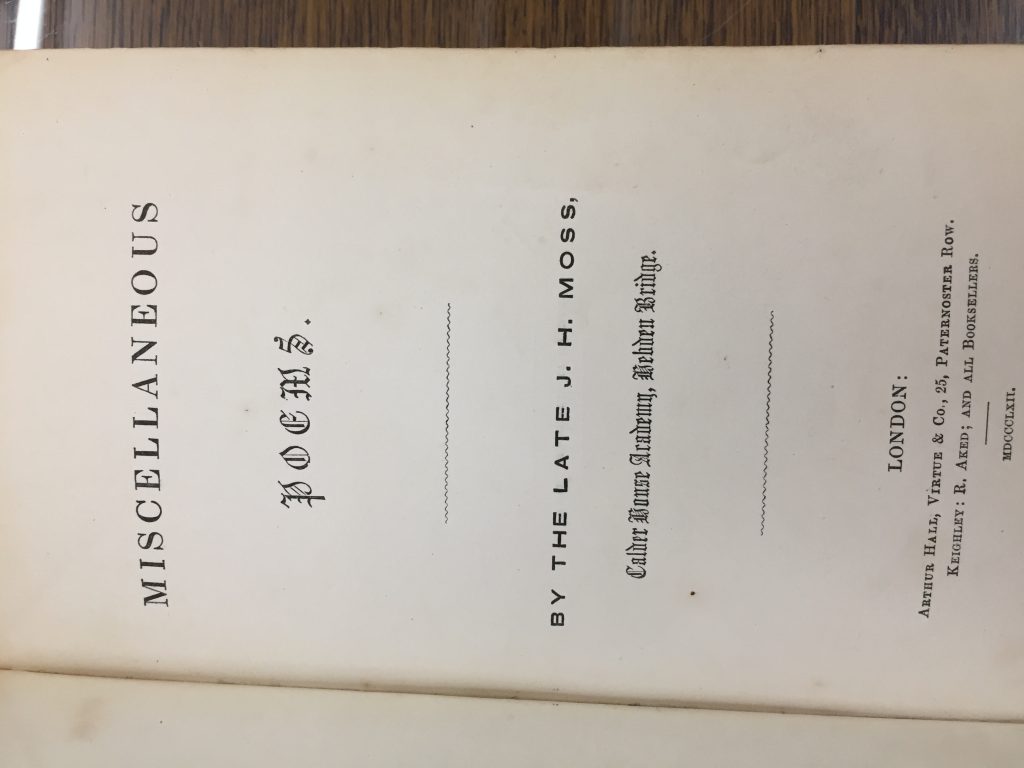

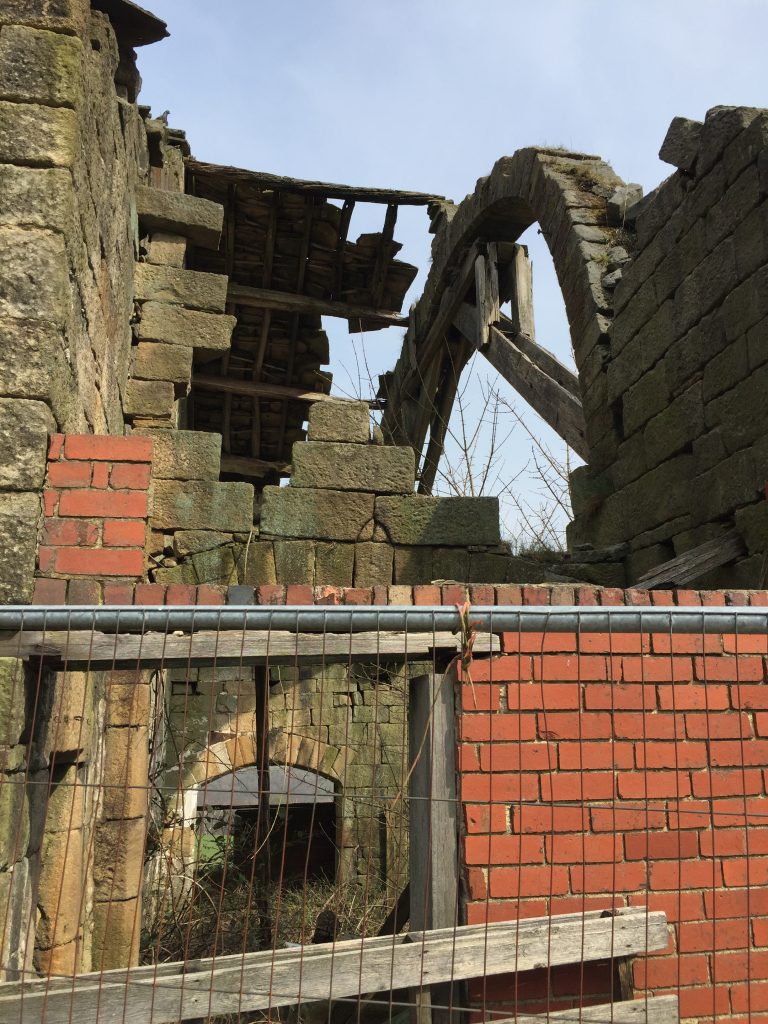
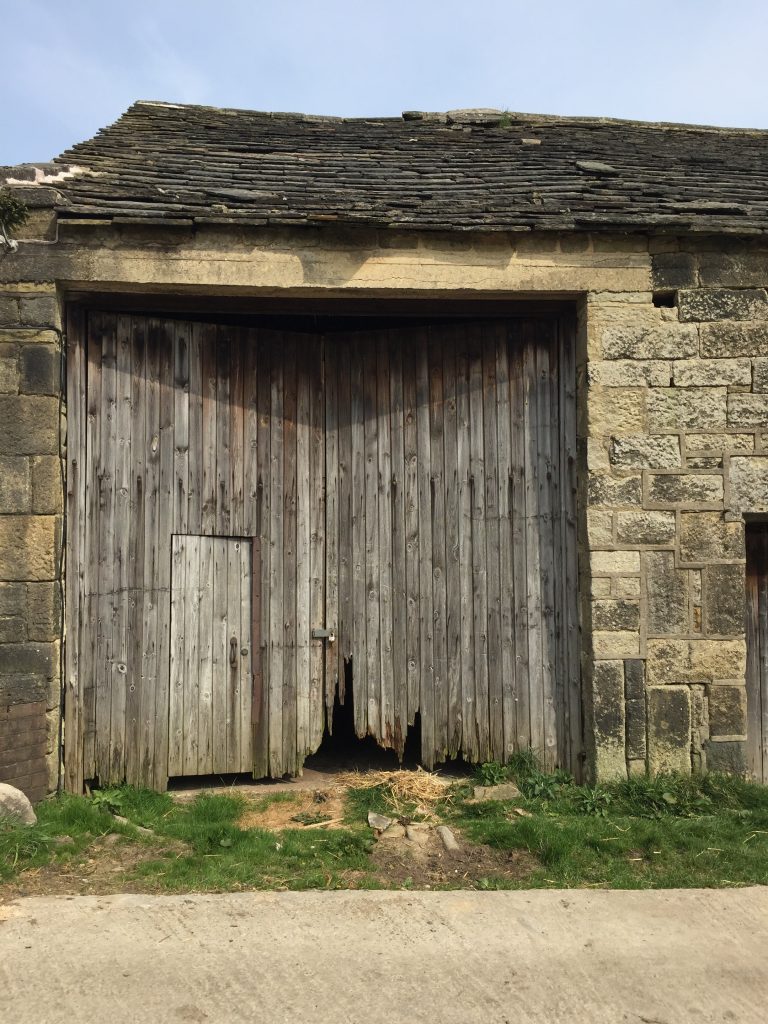
Recent Comments